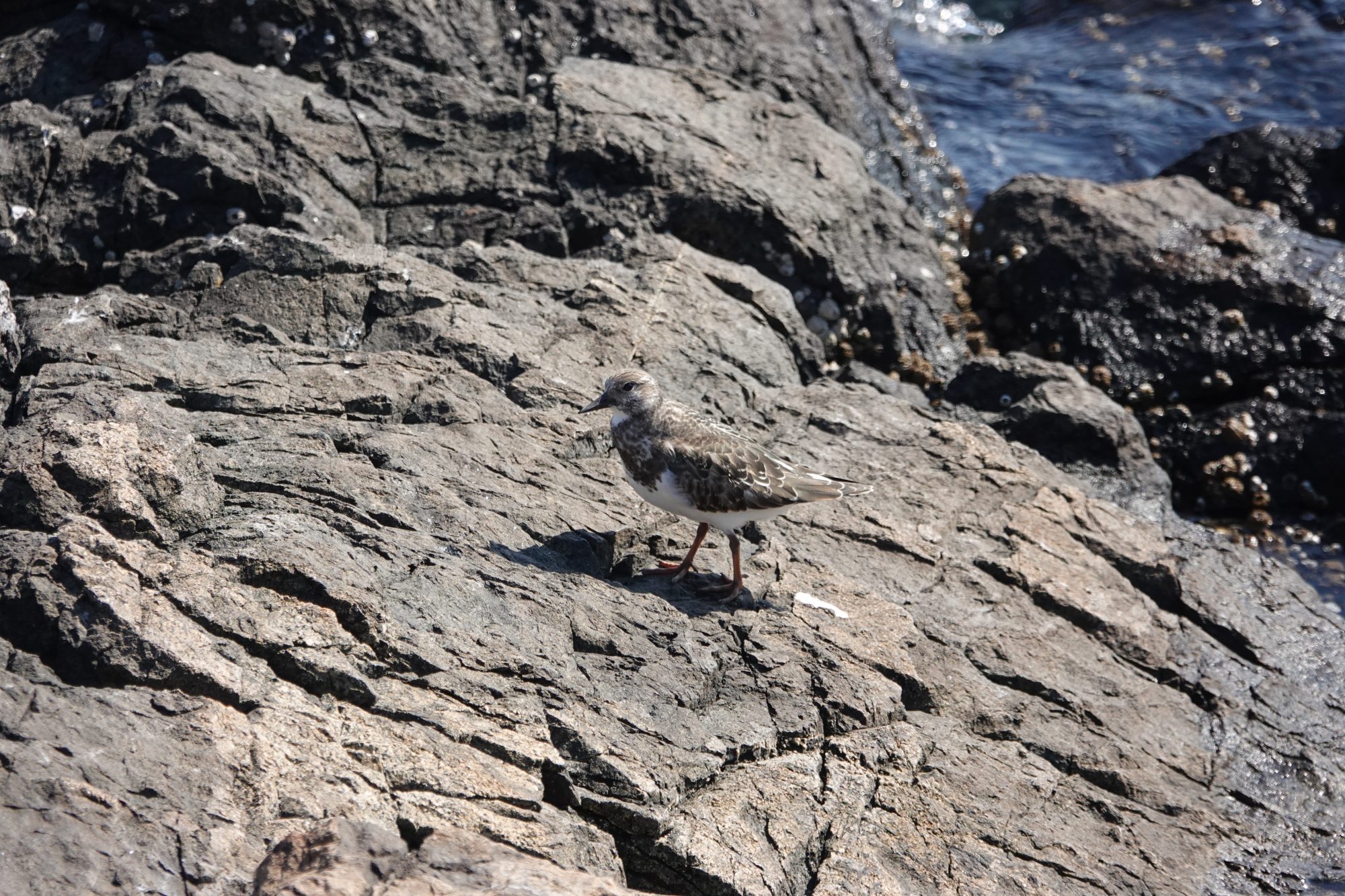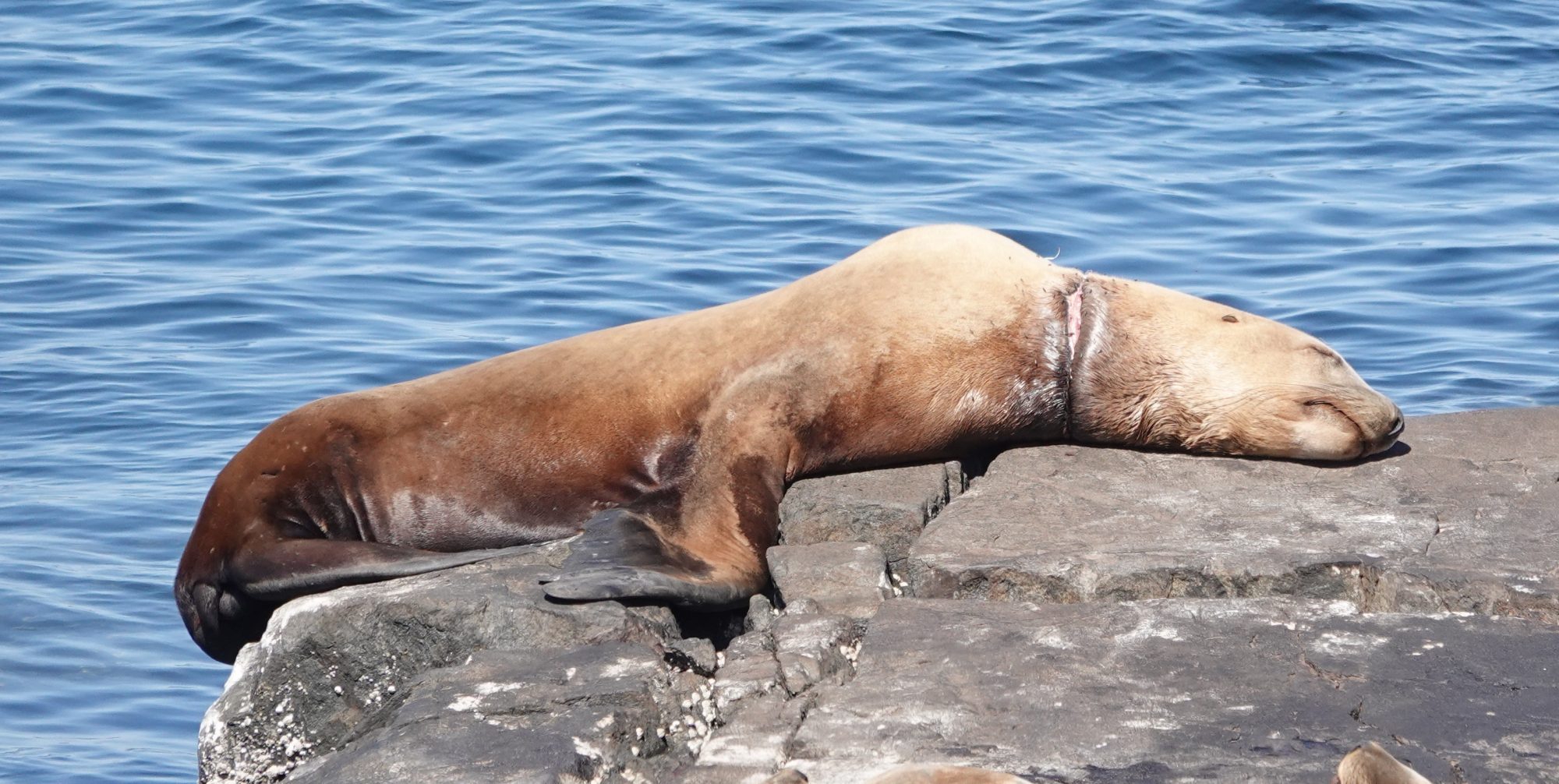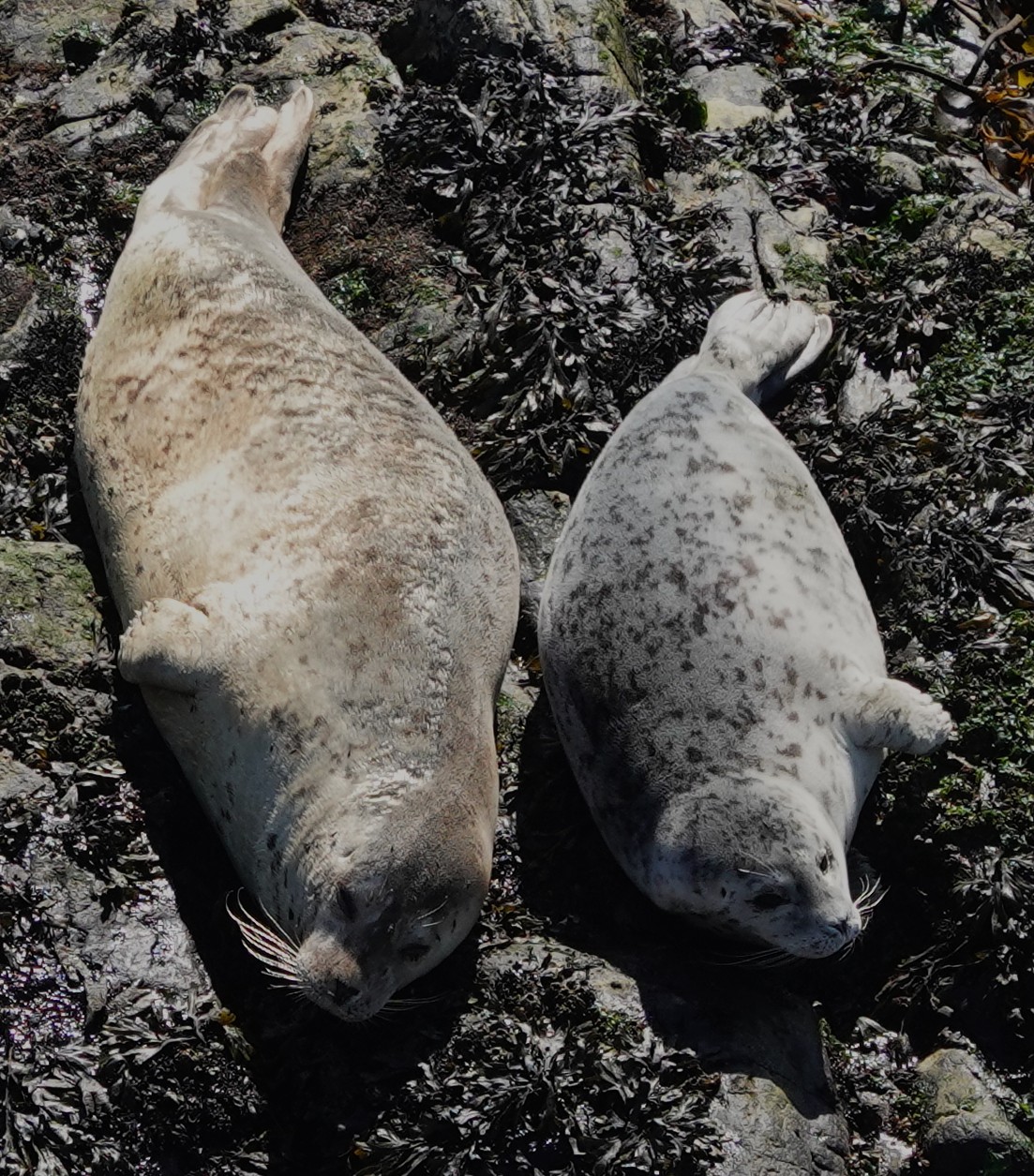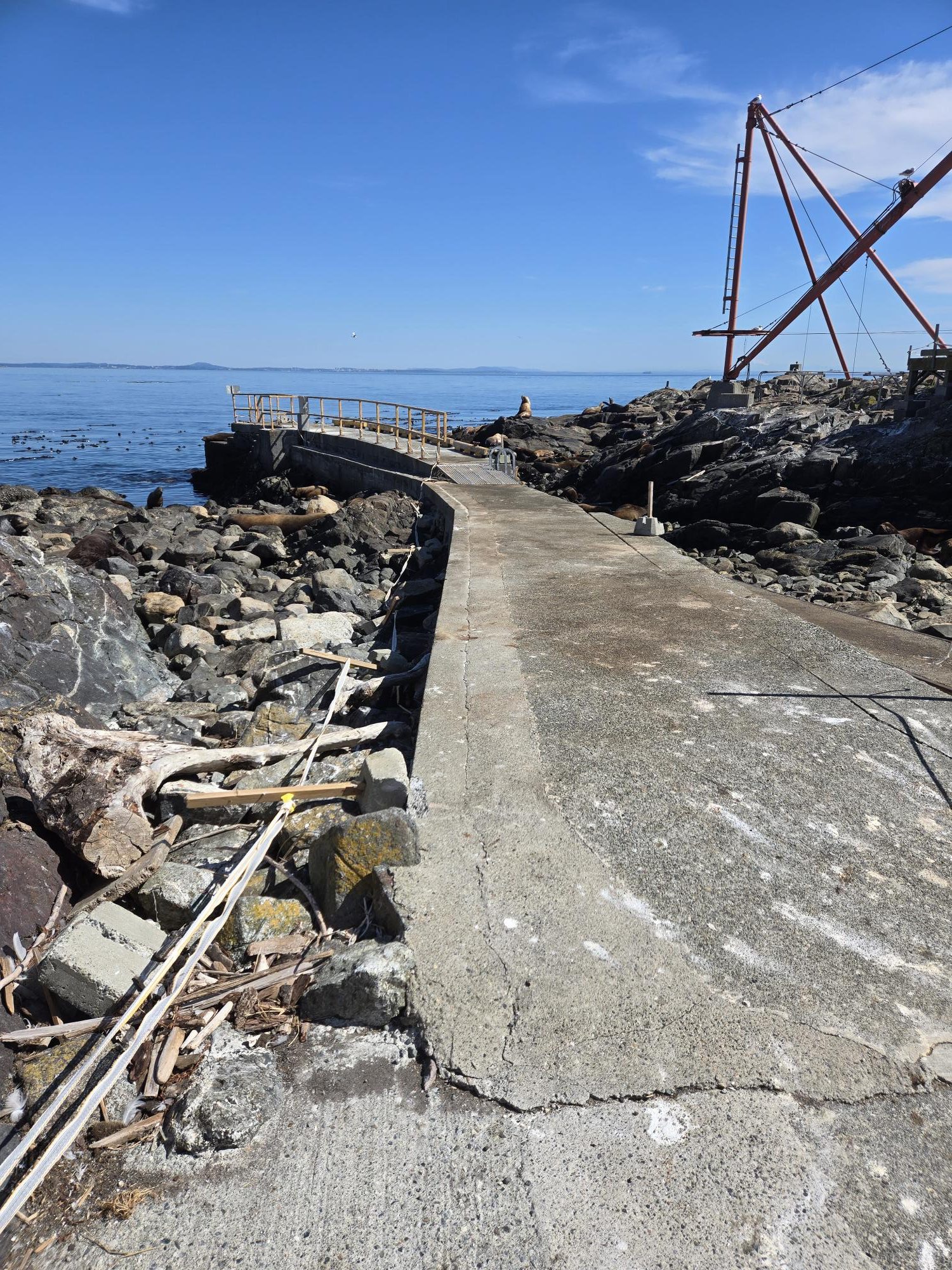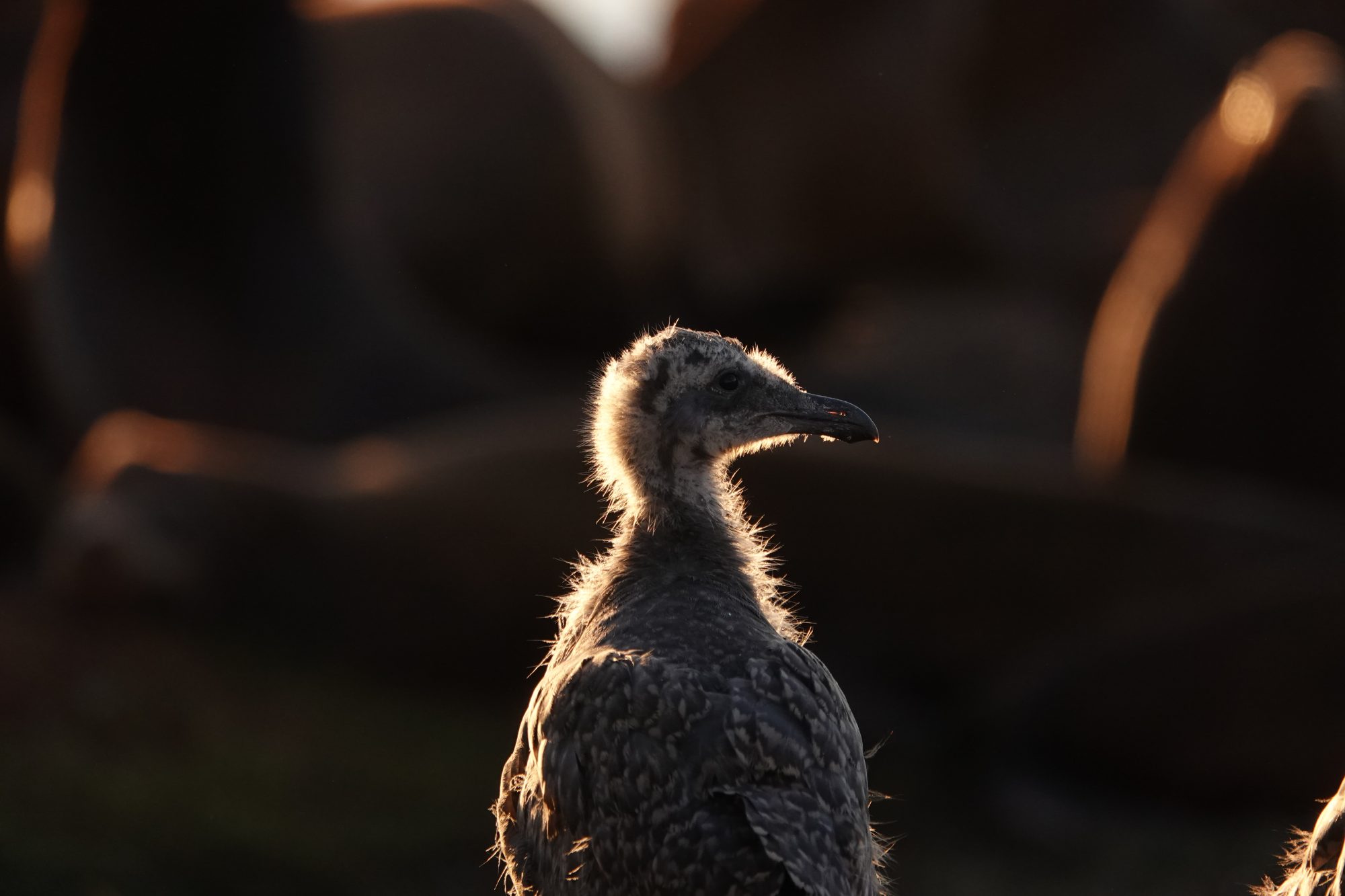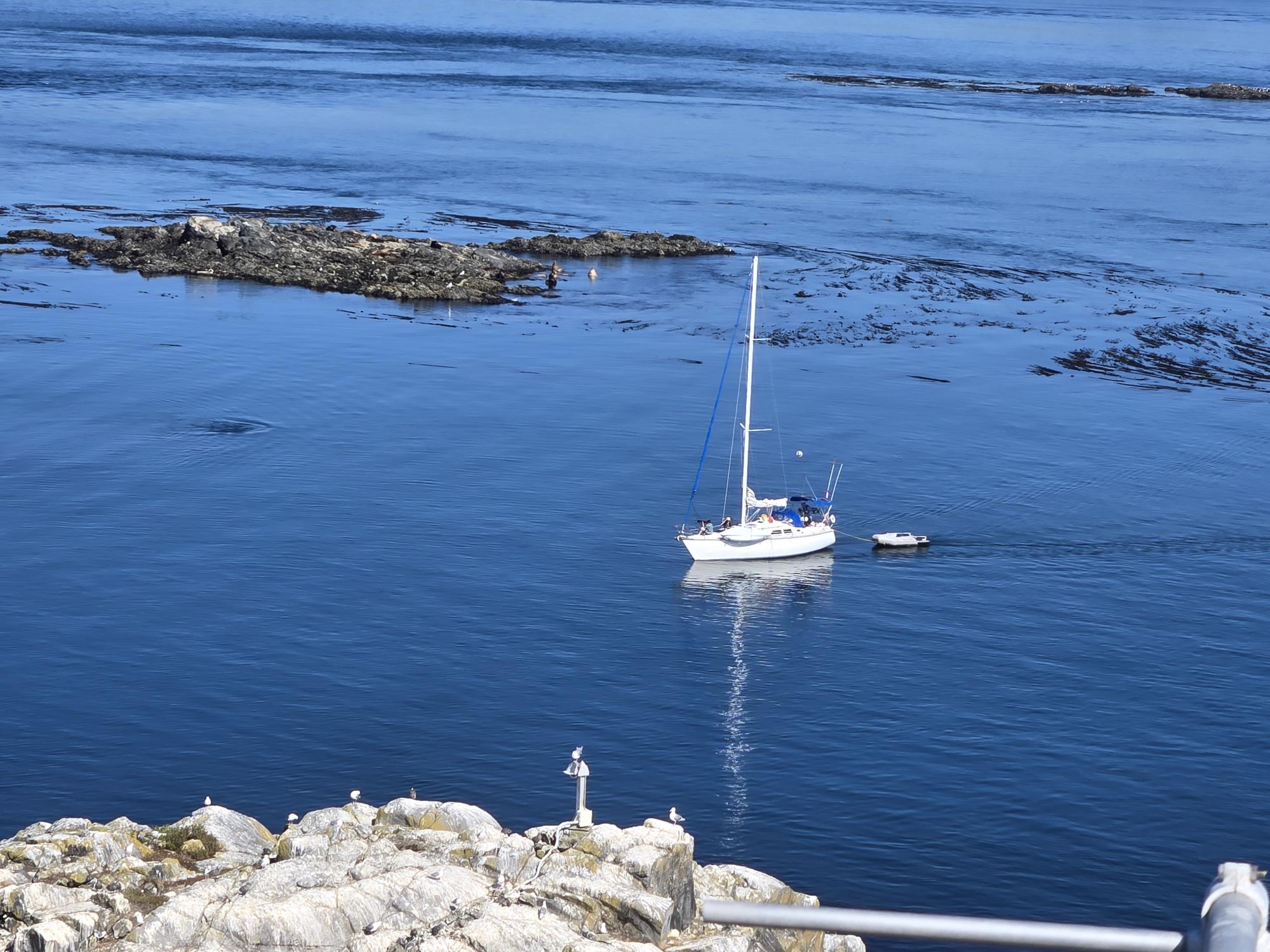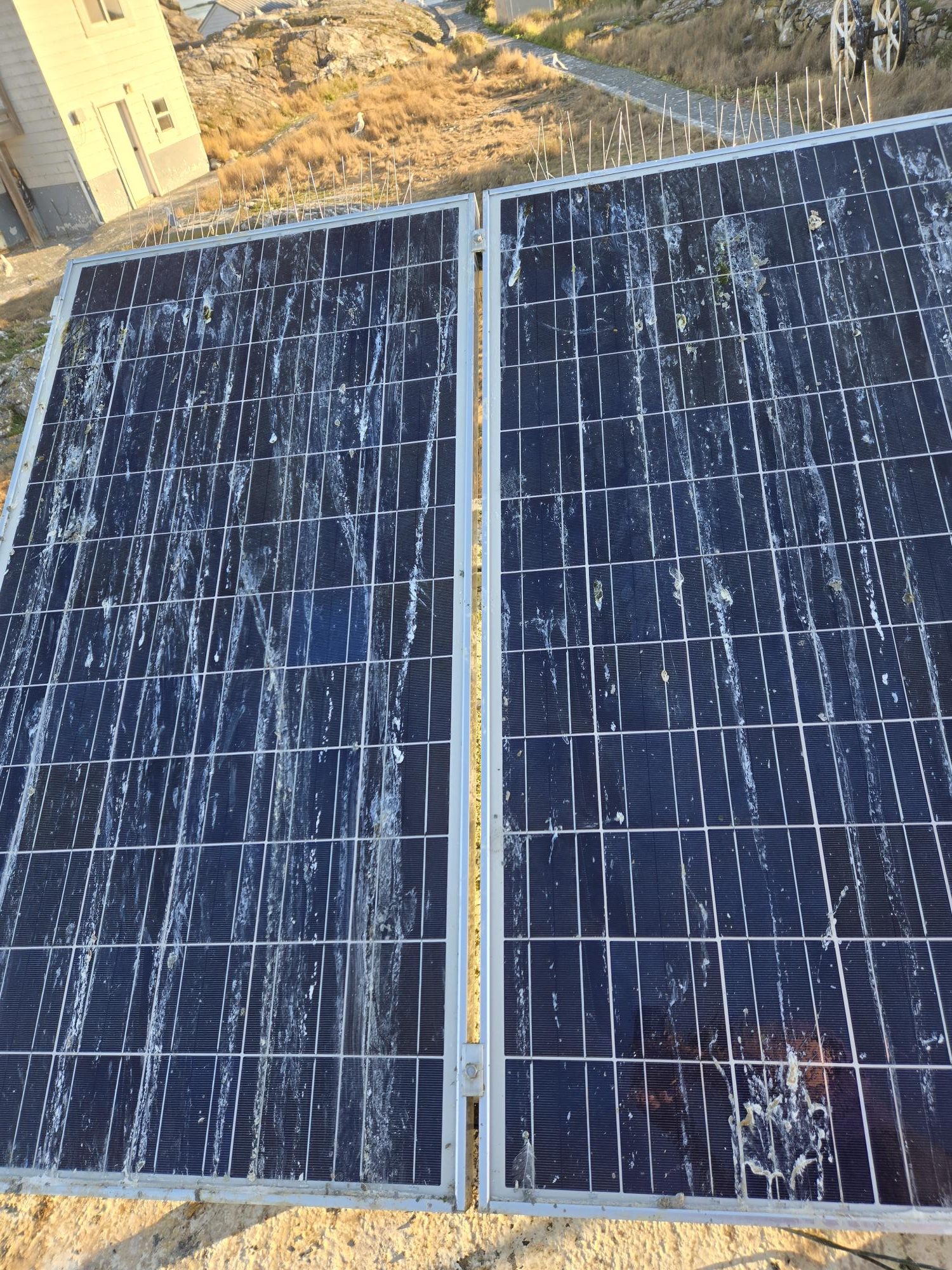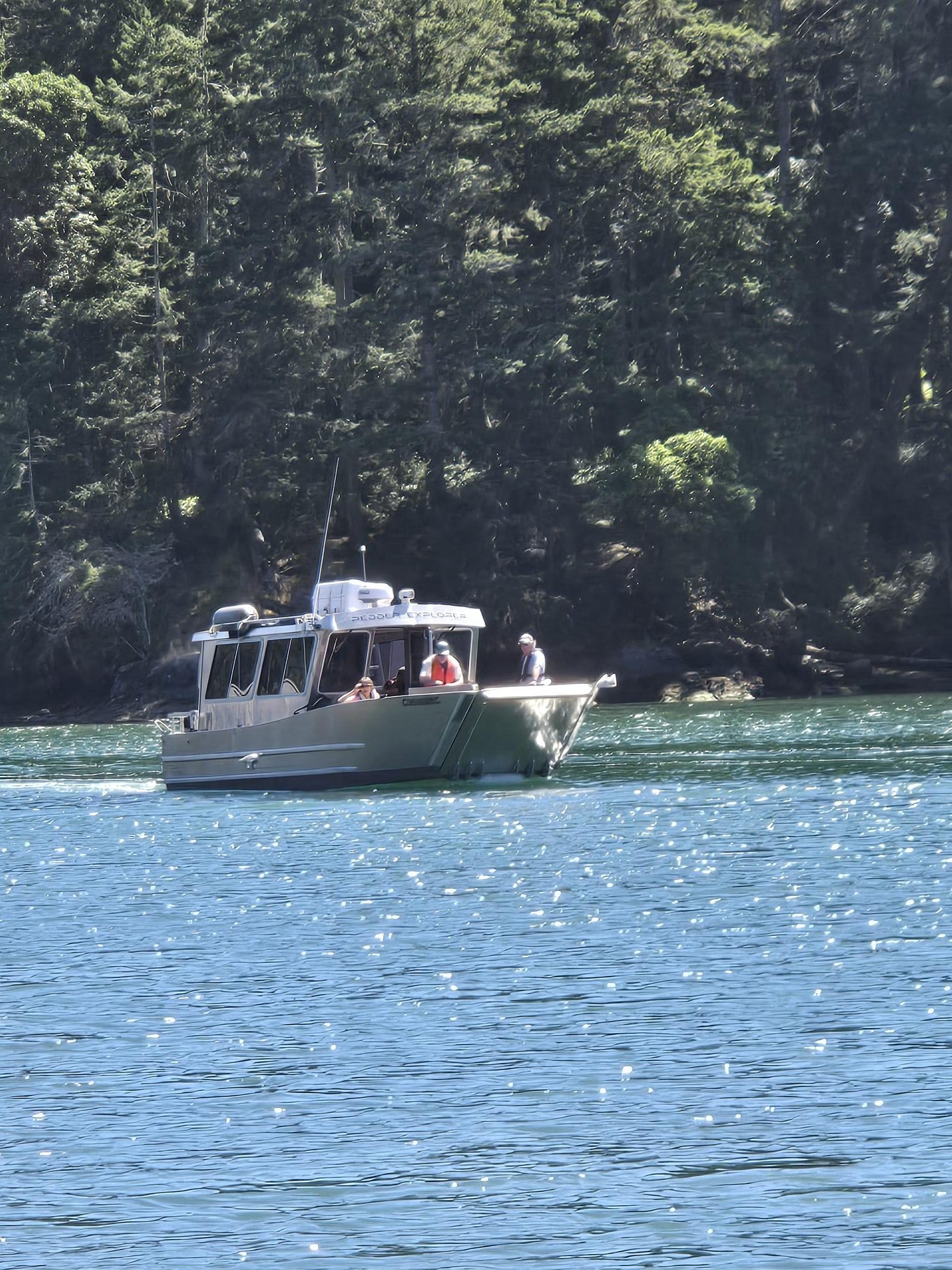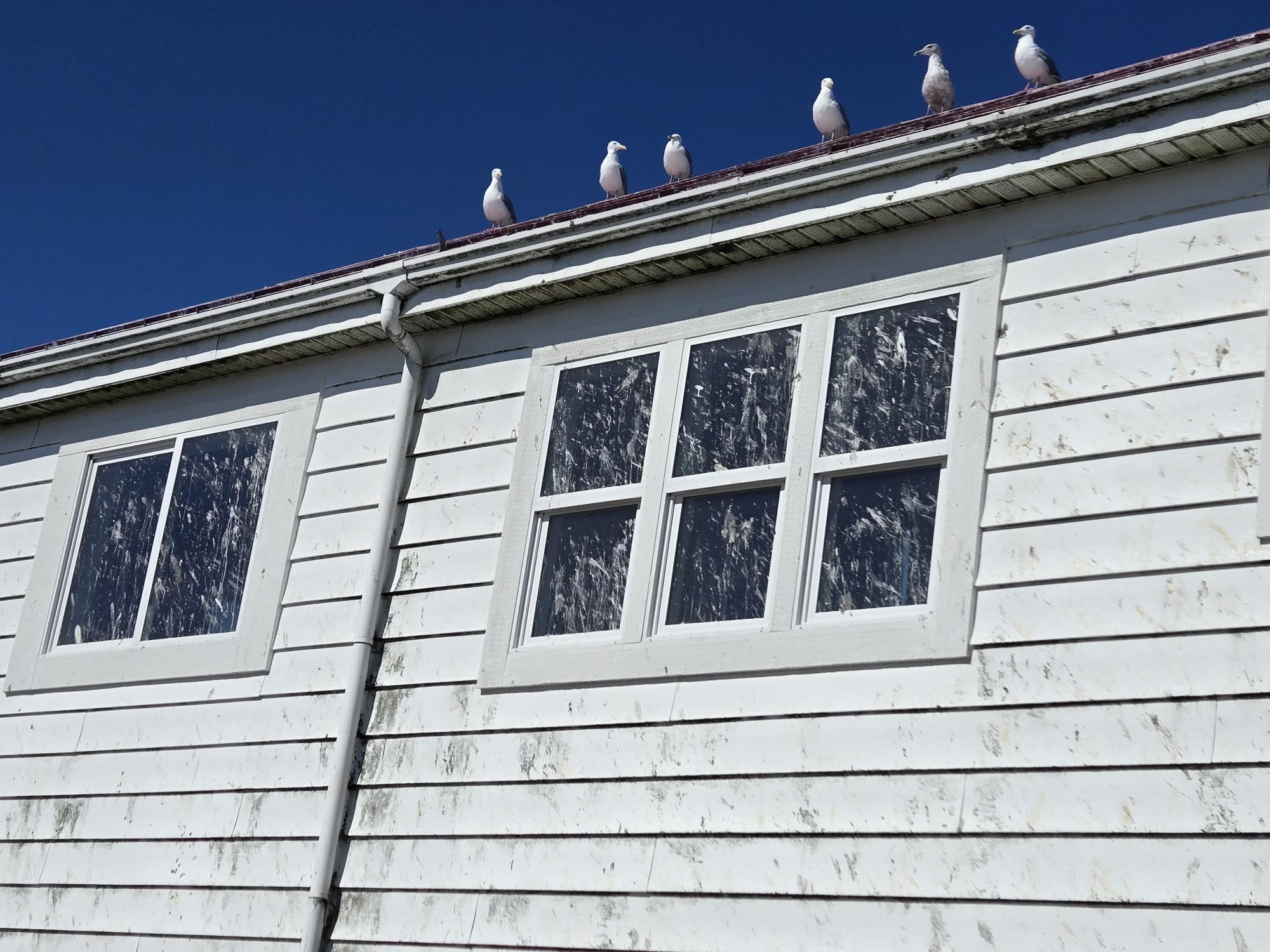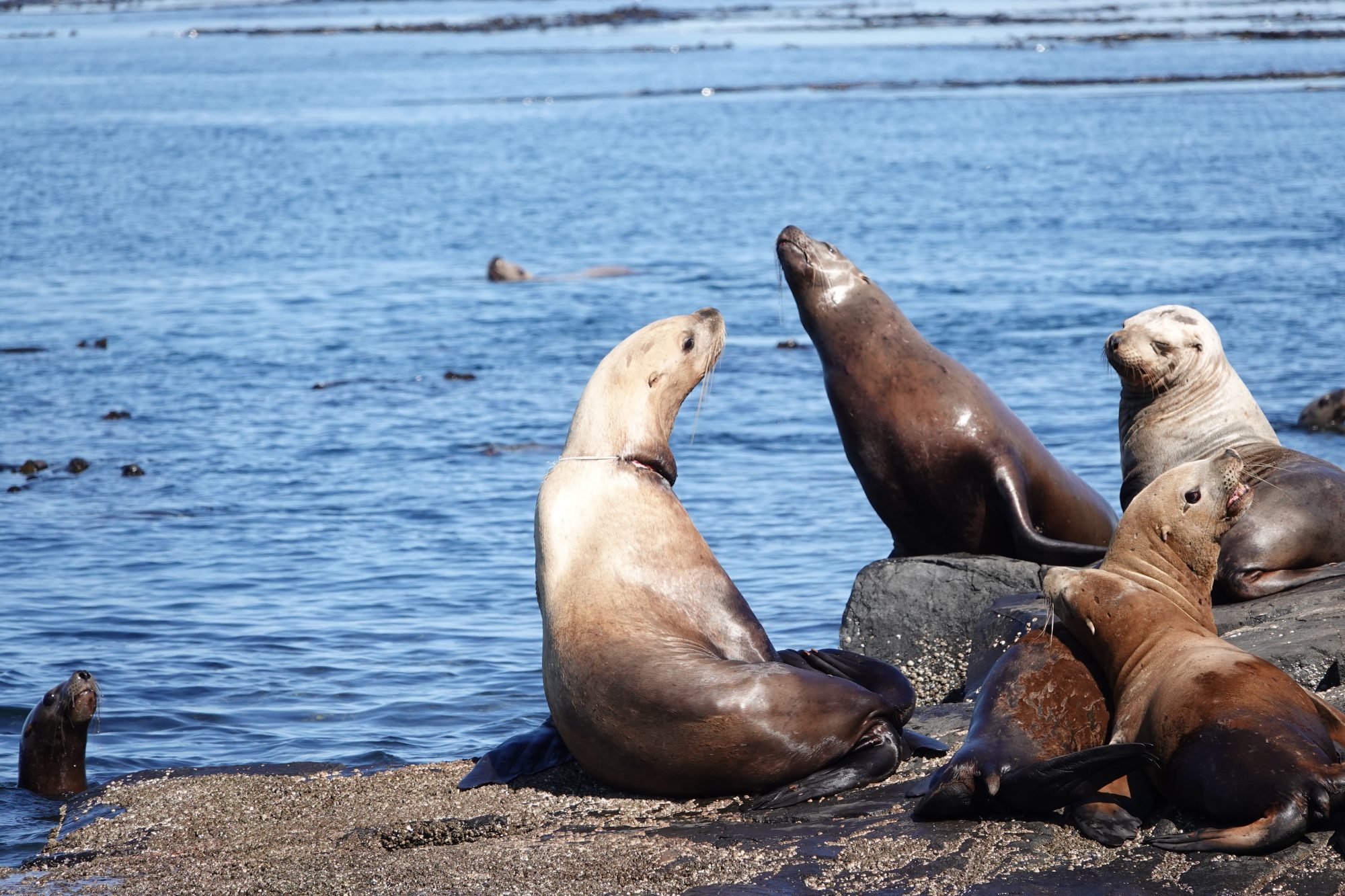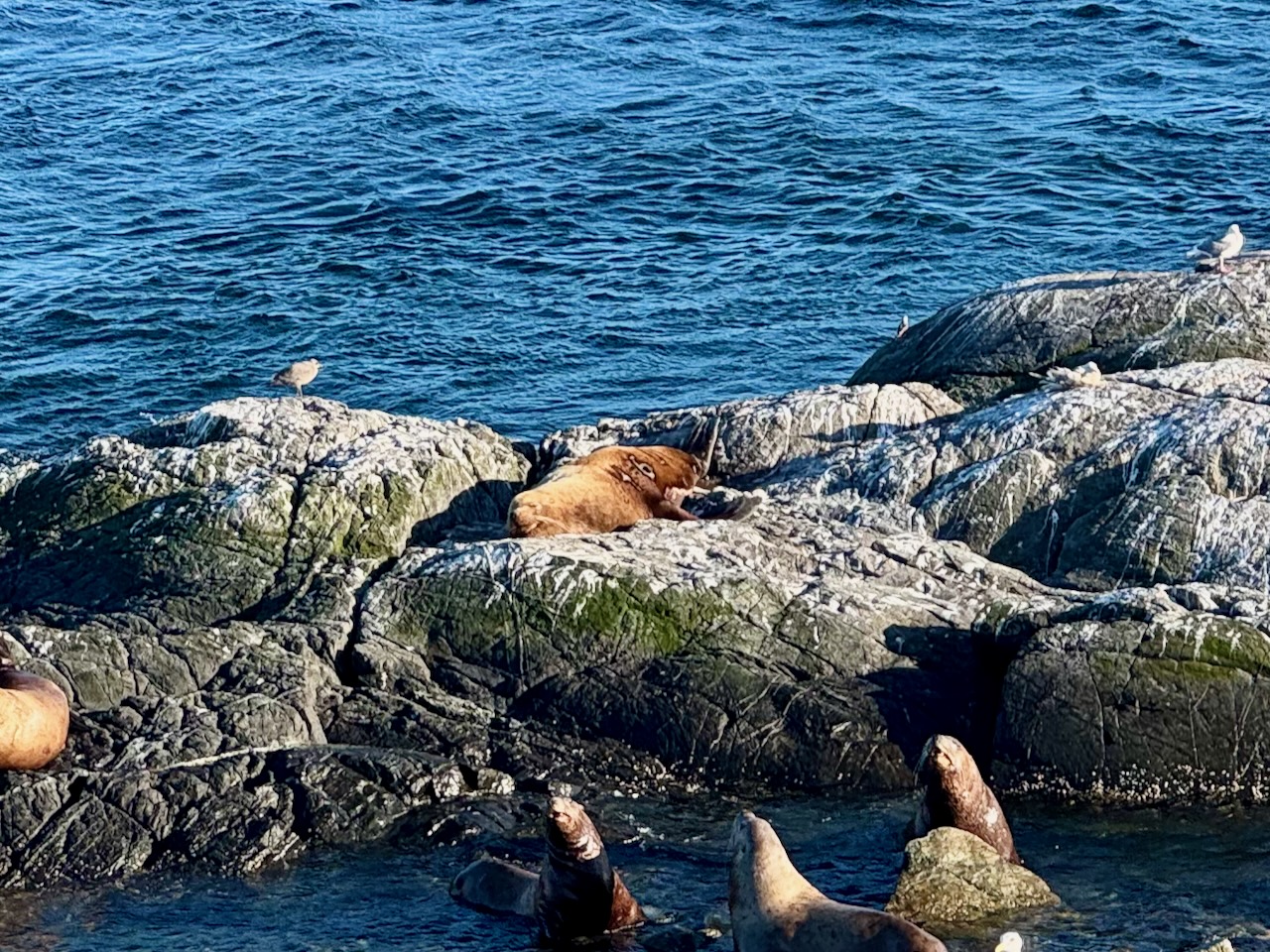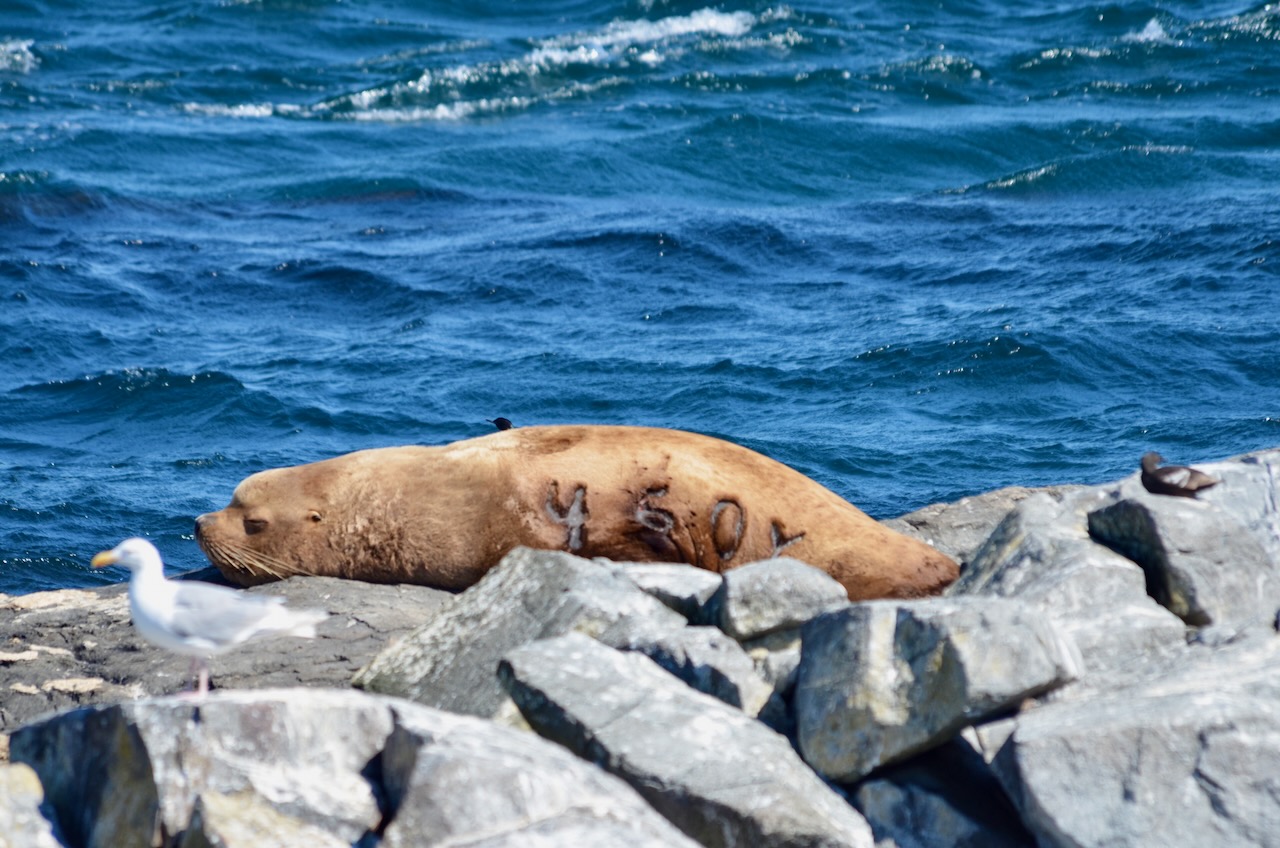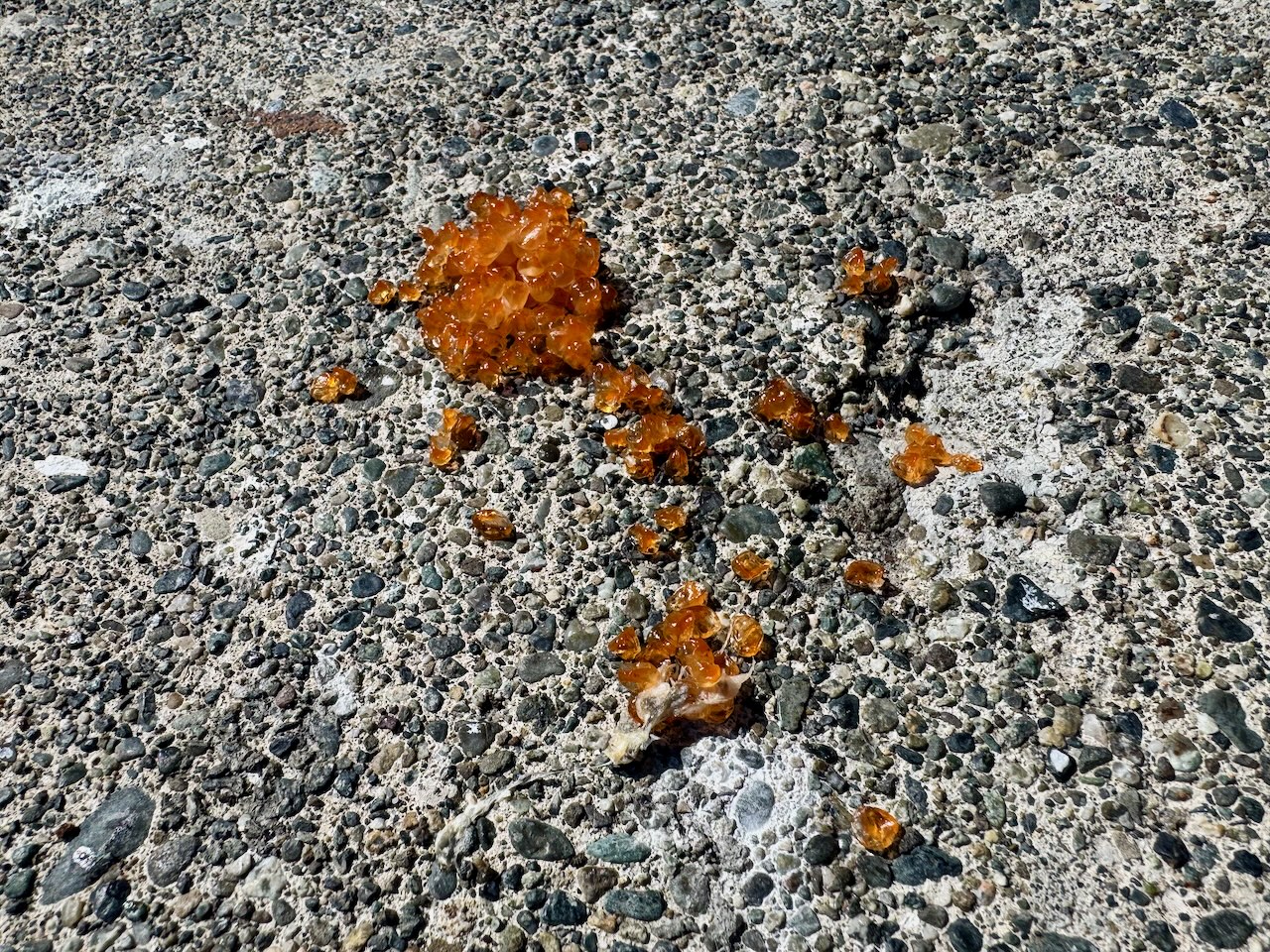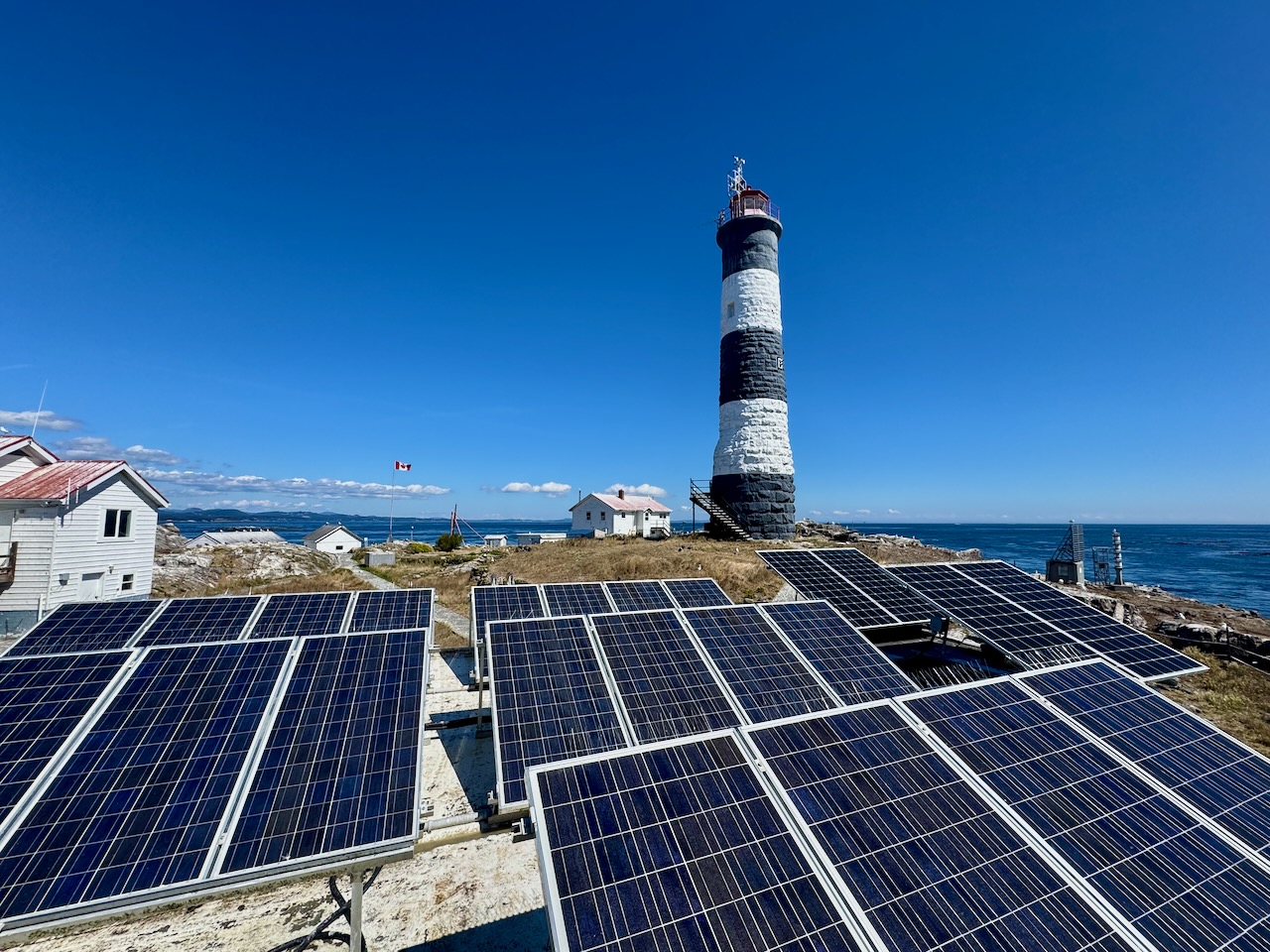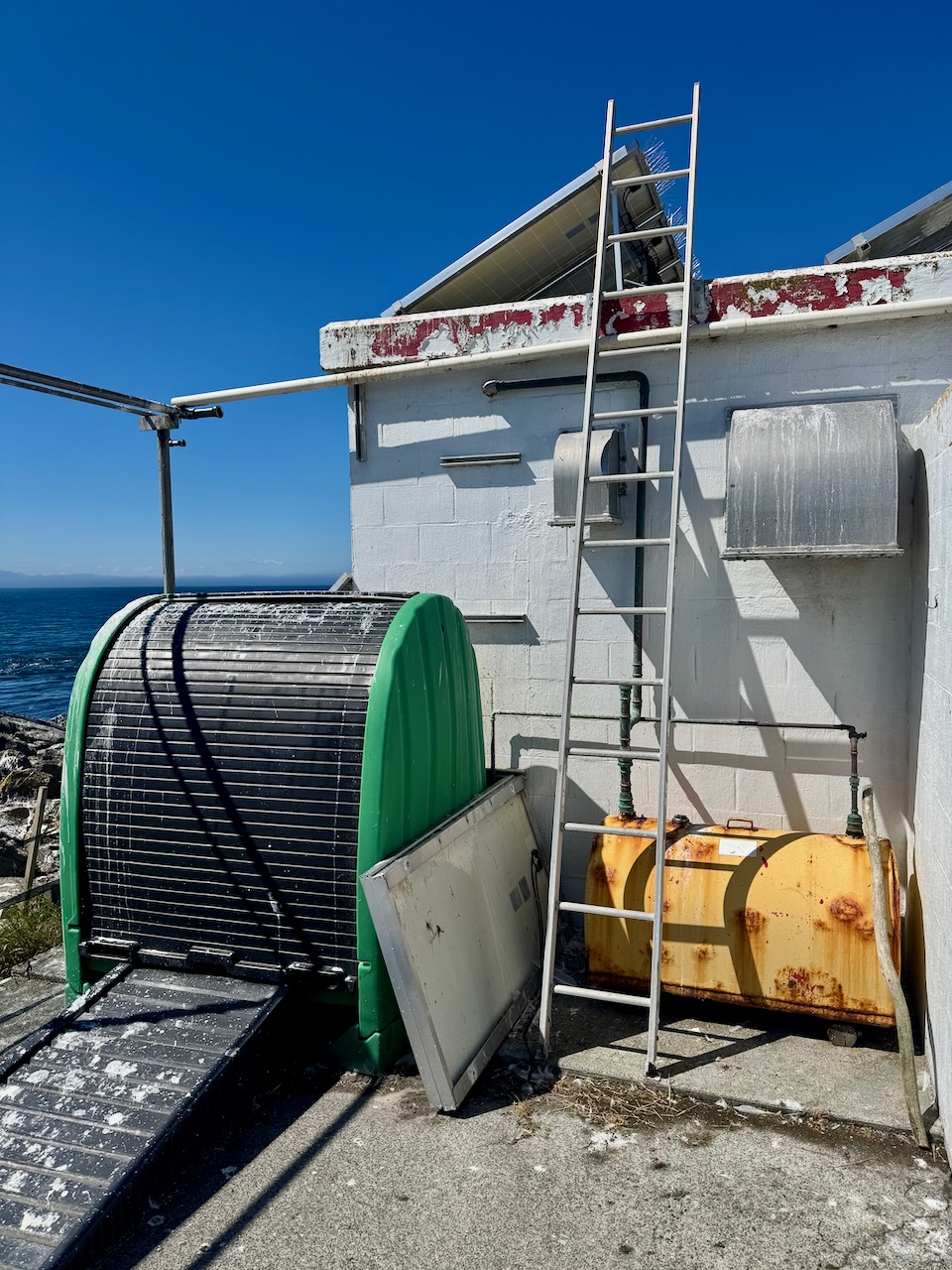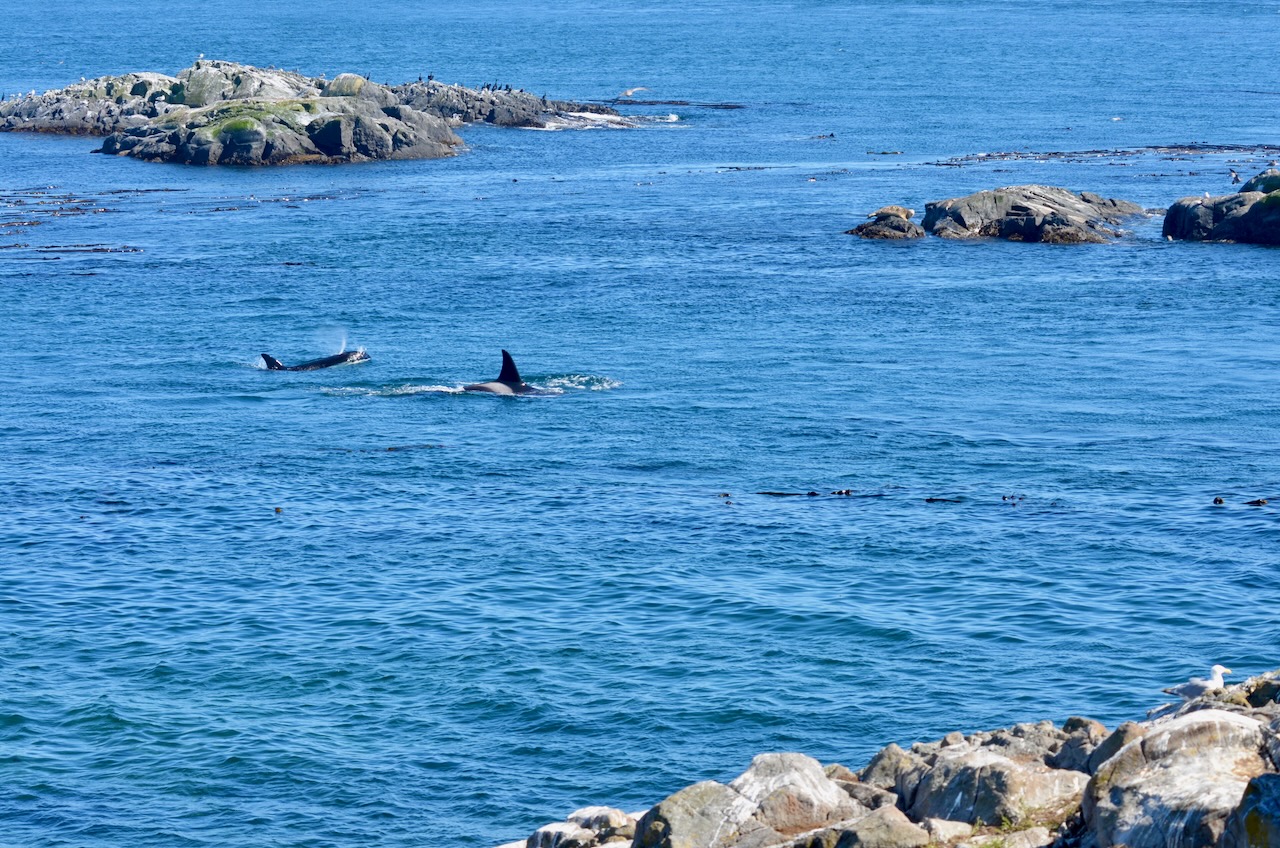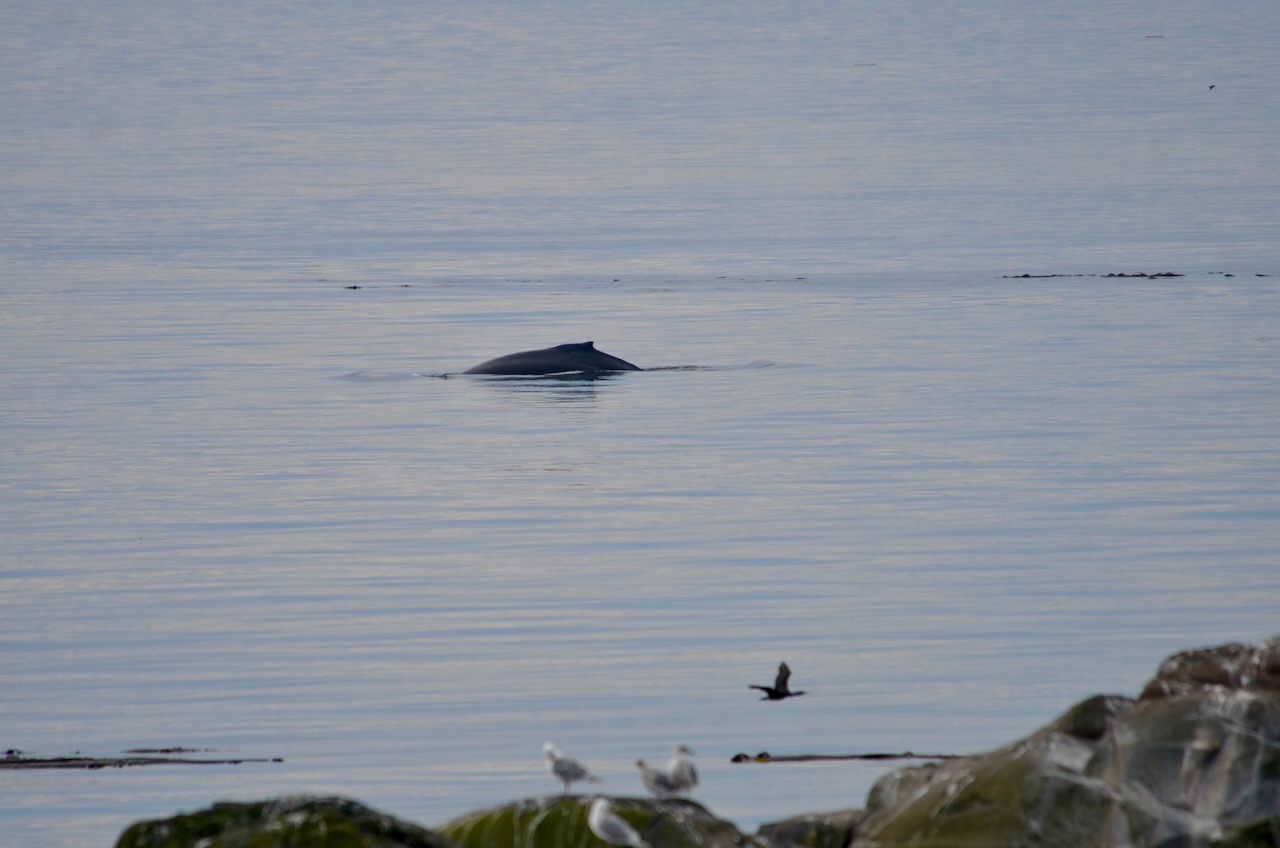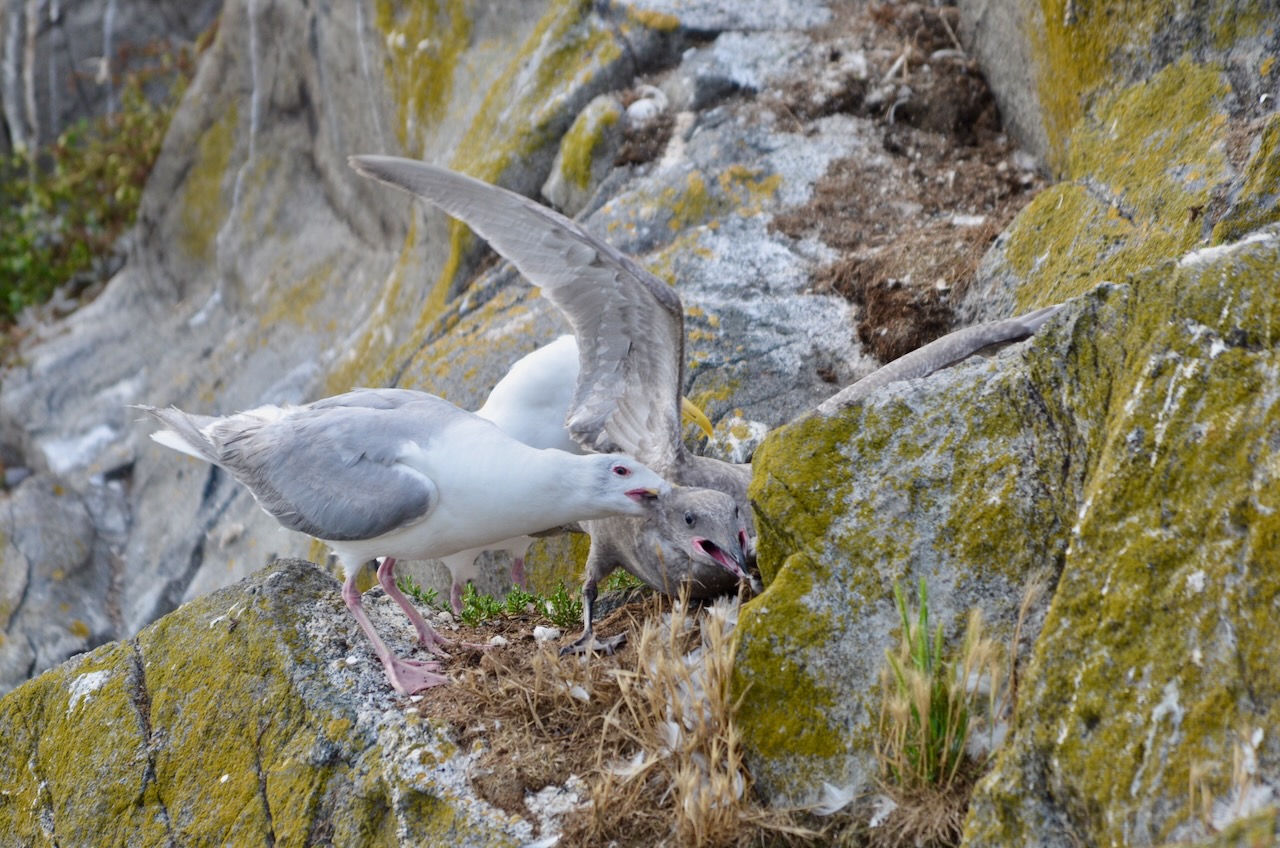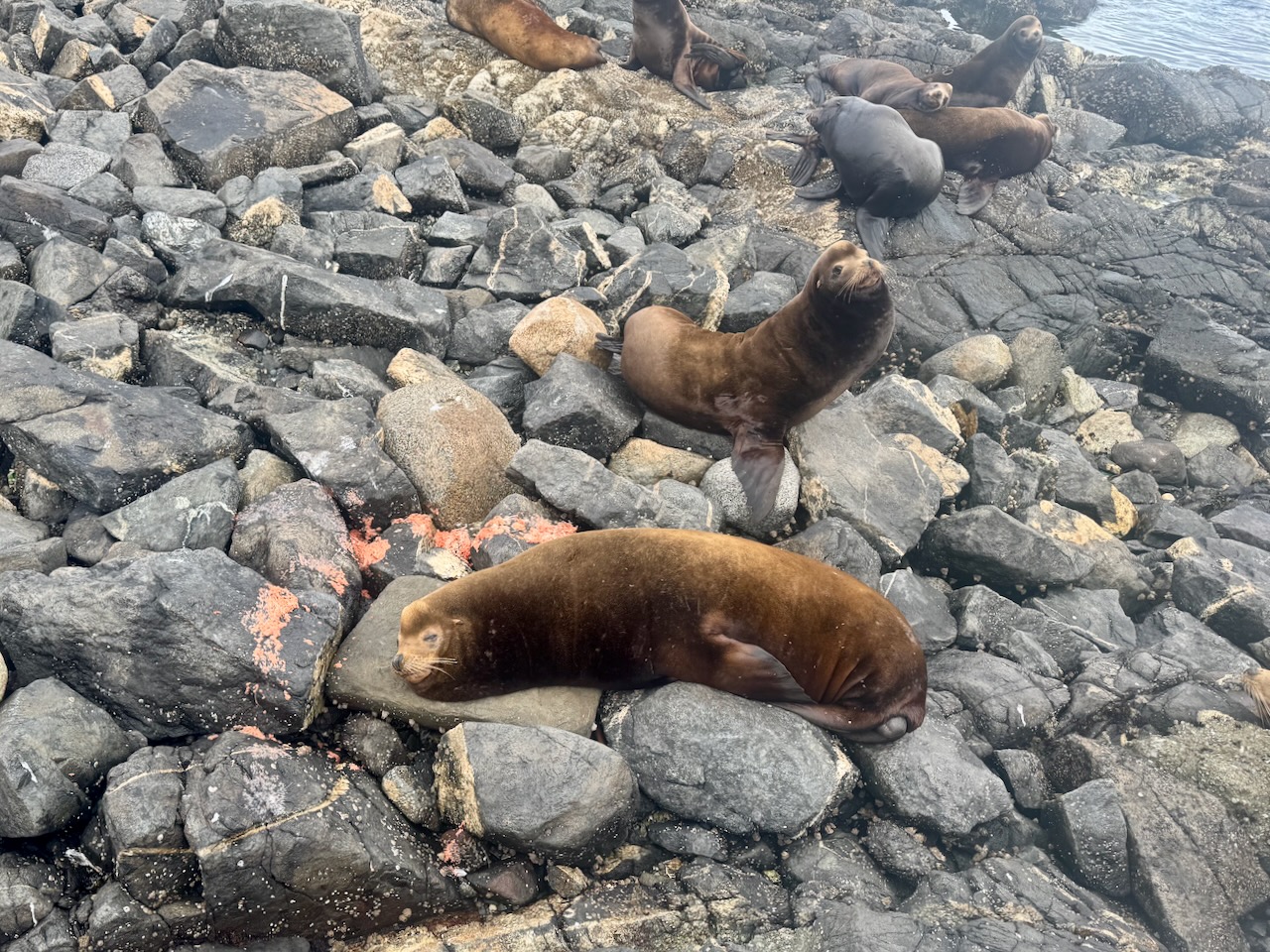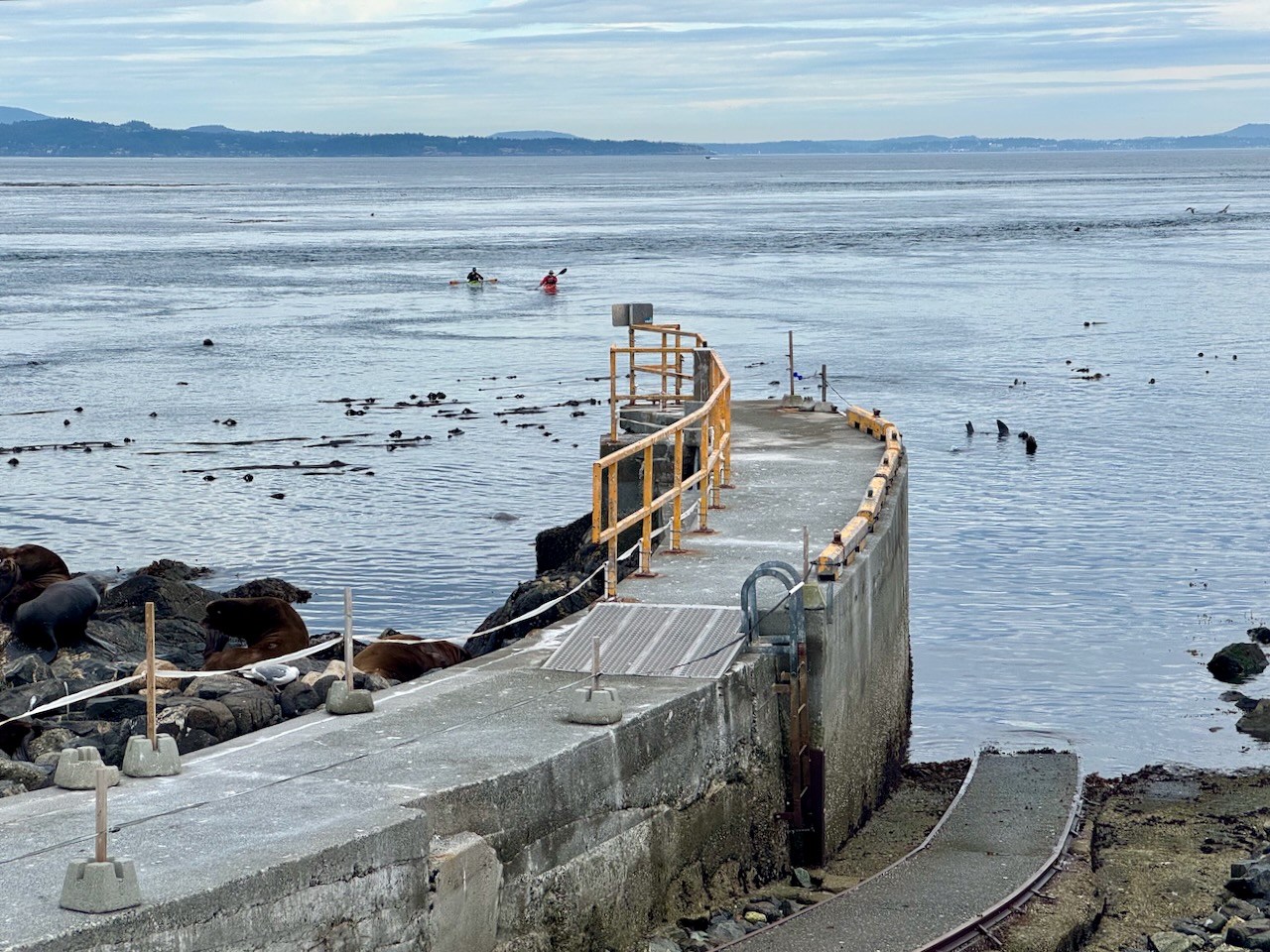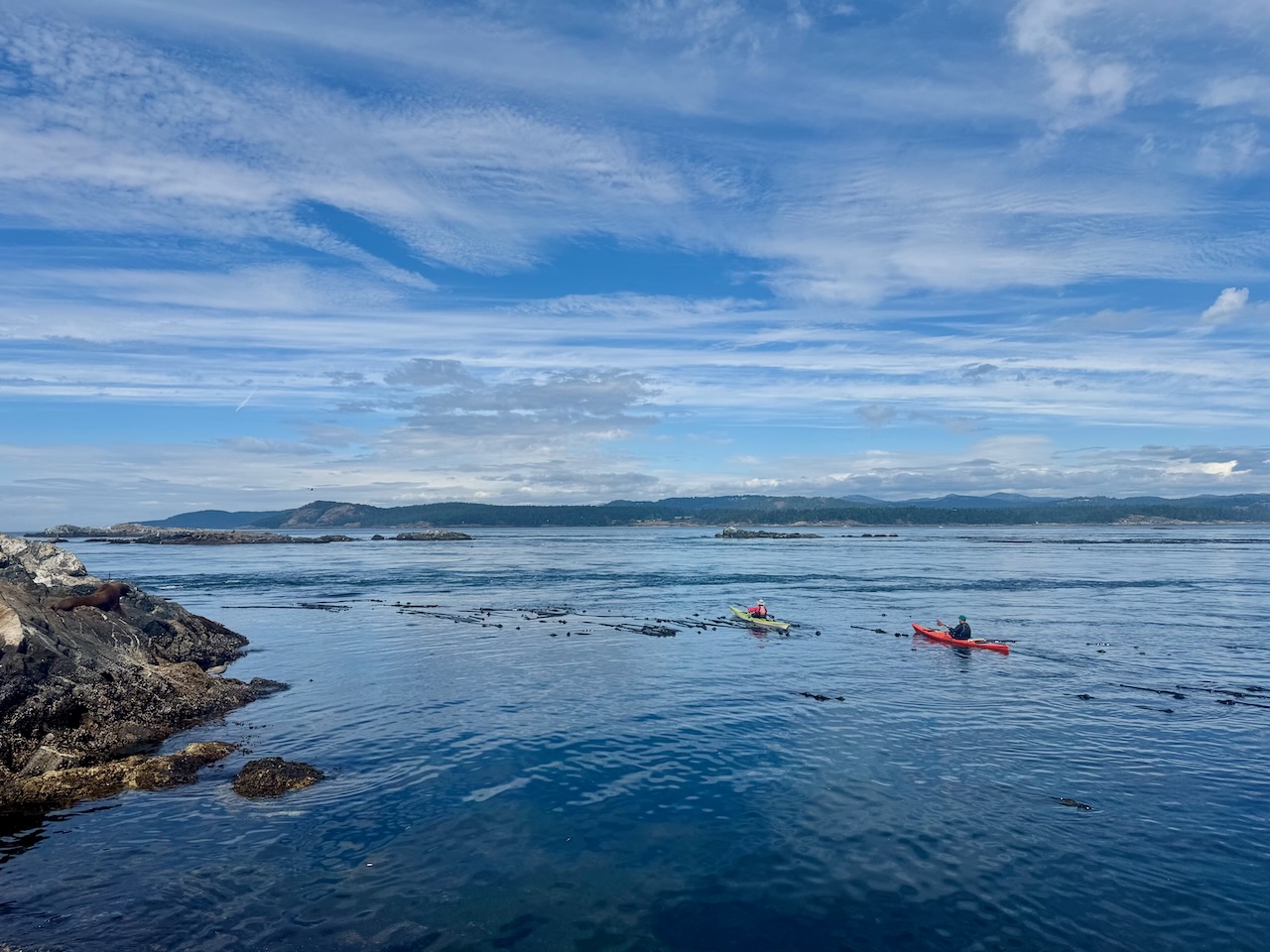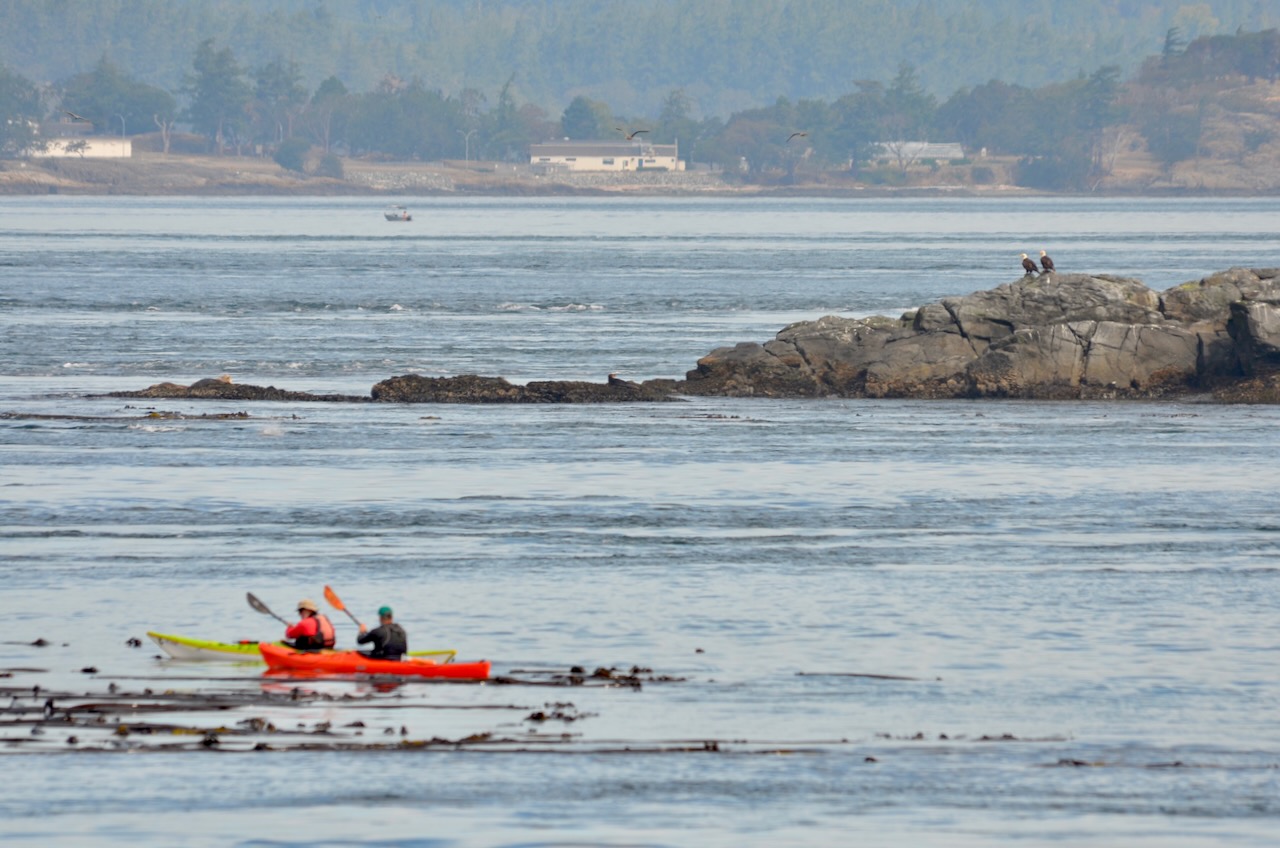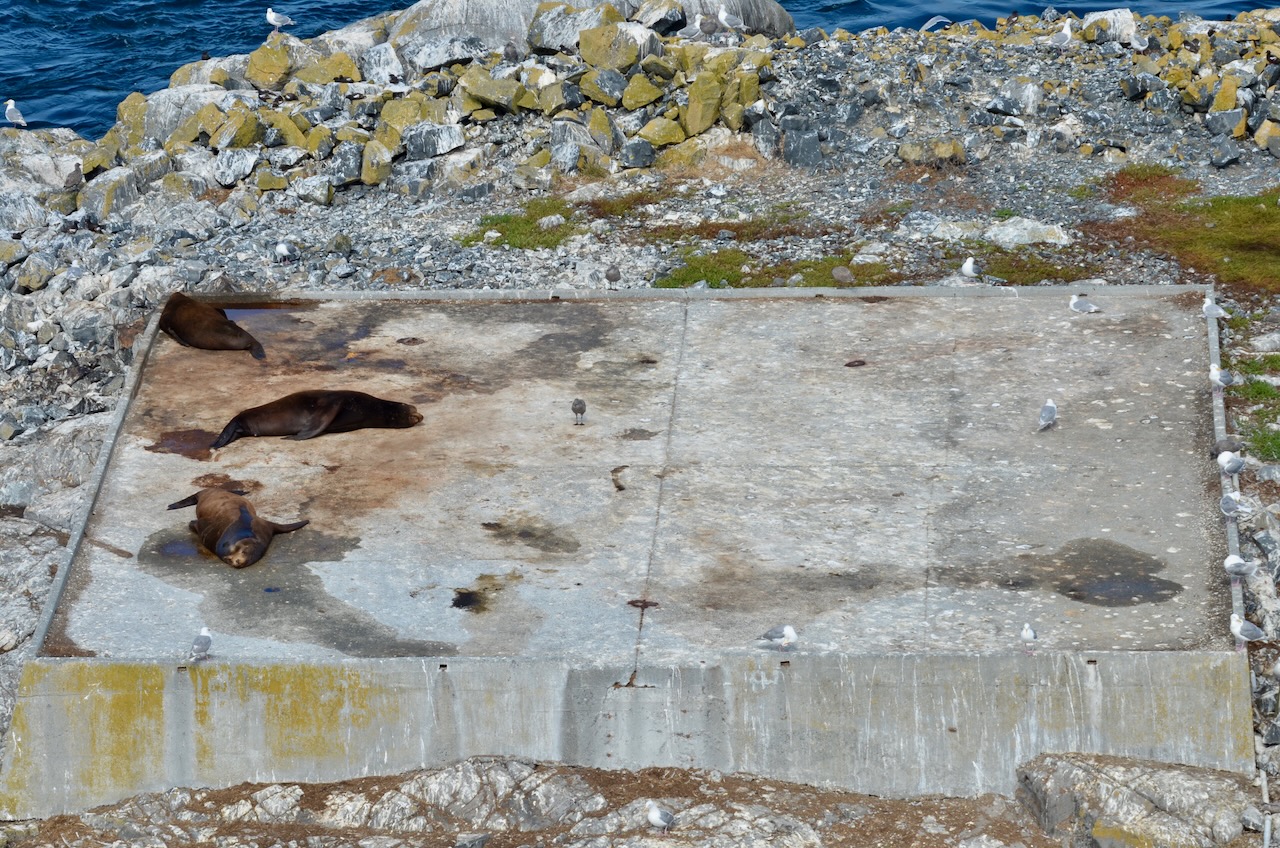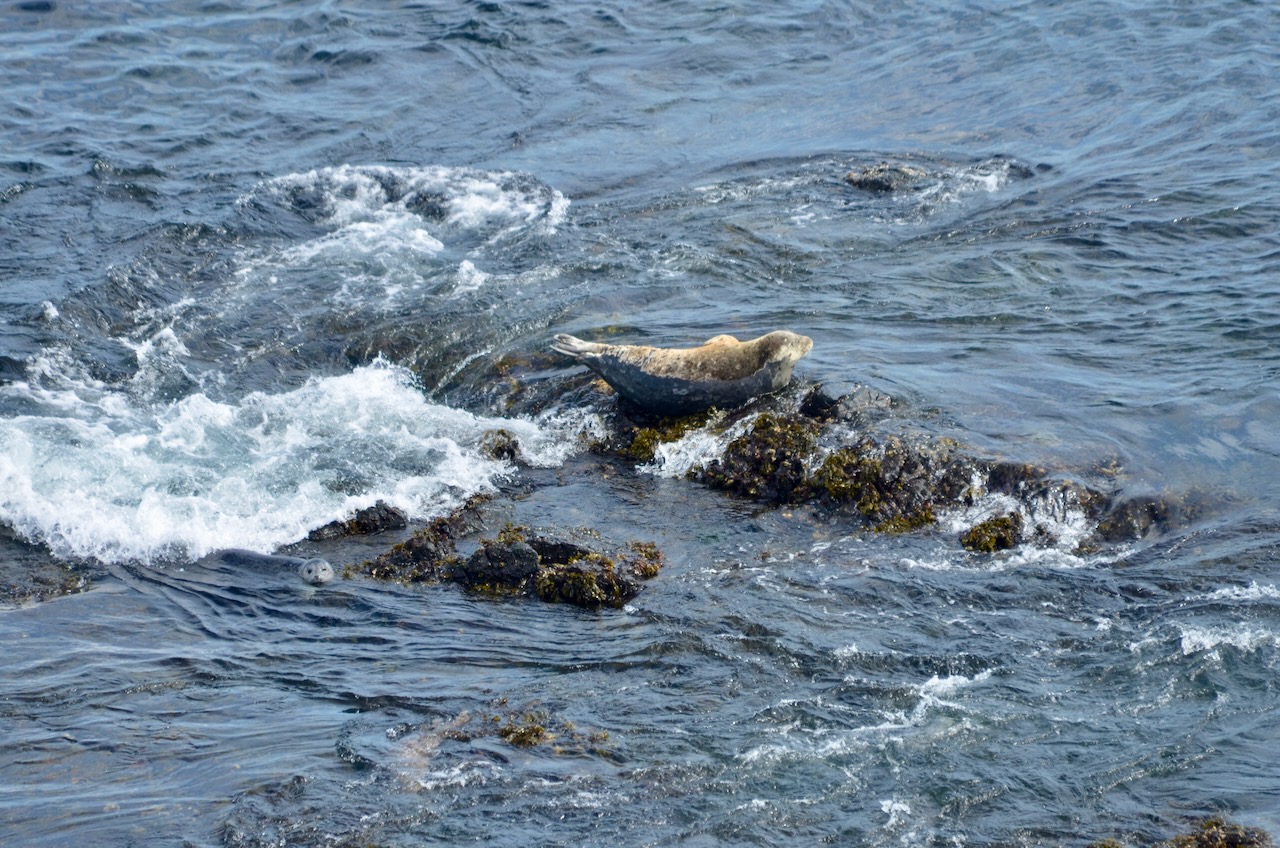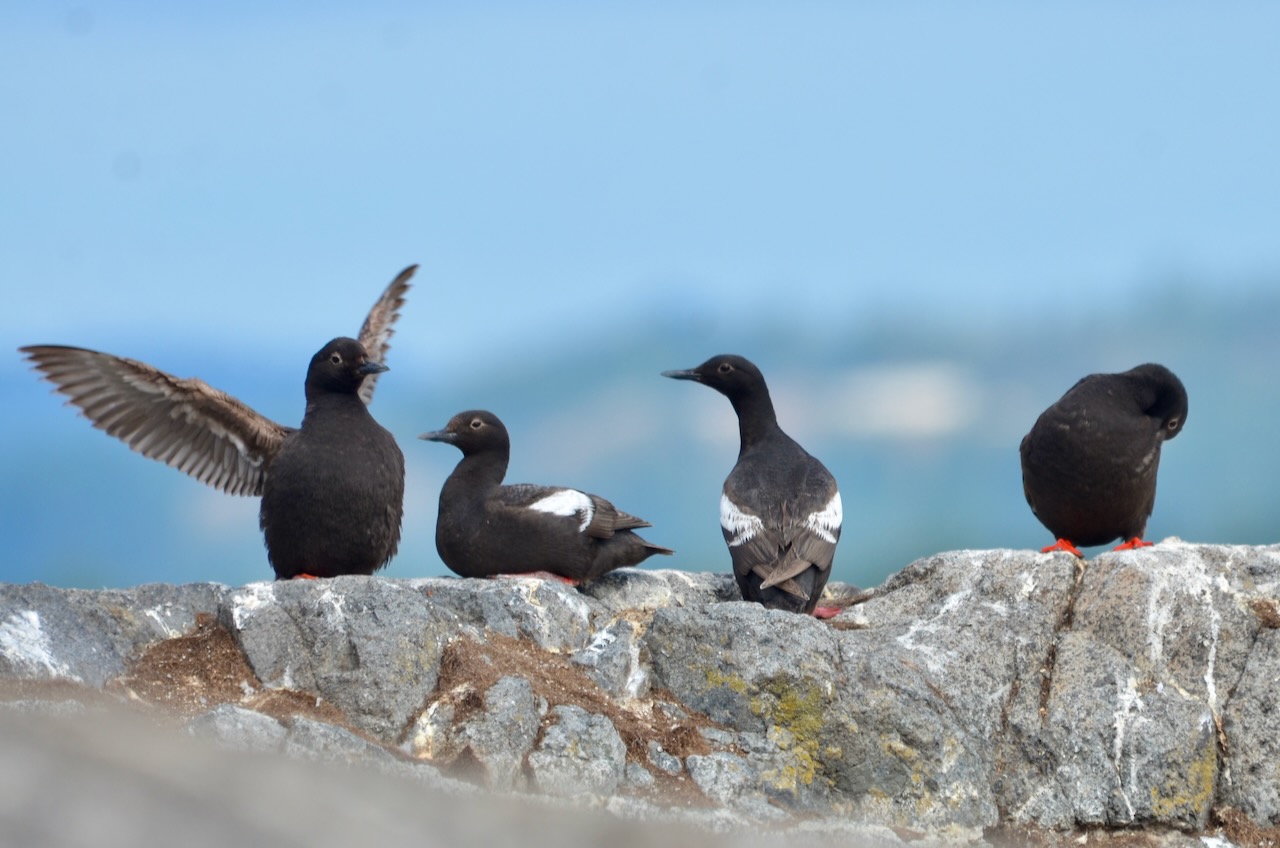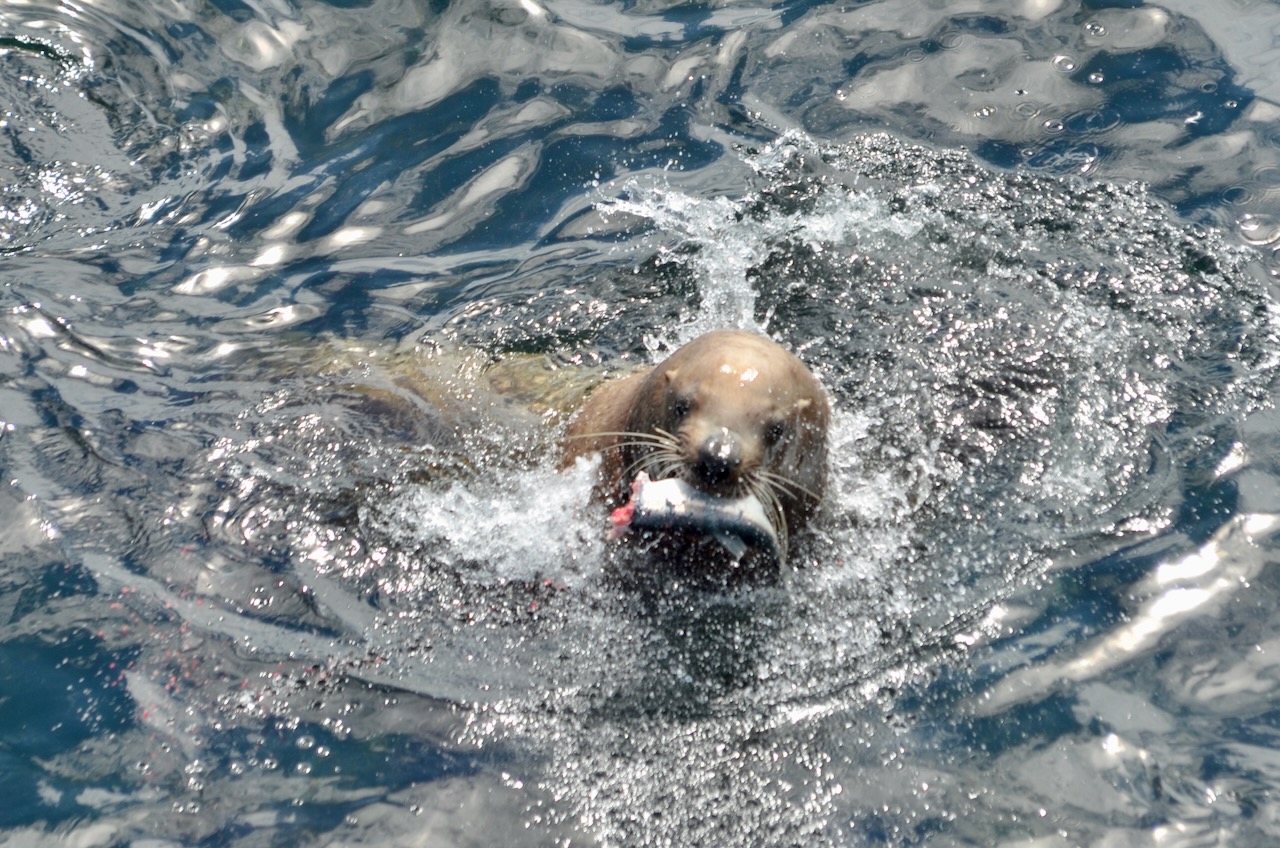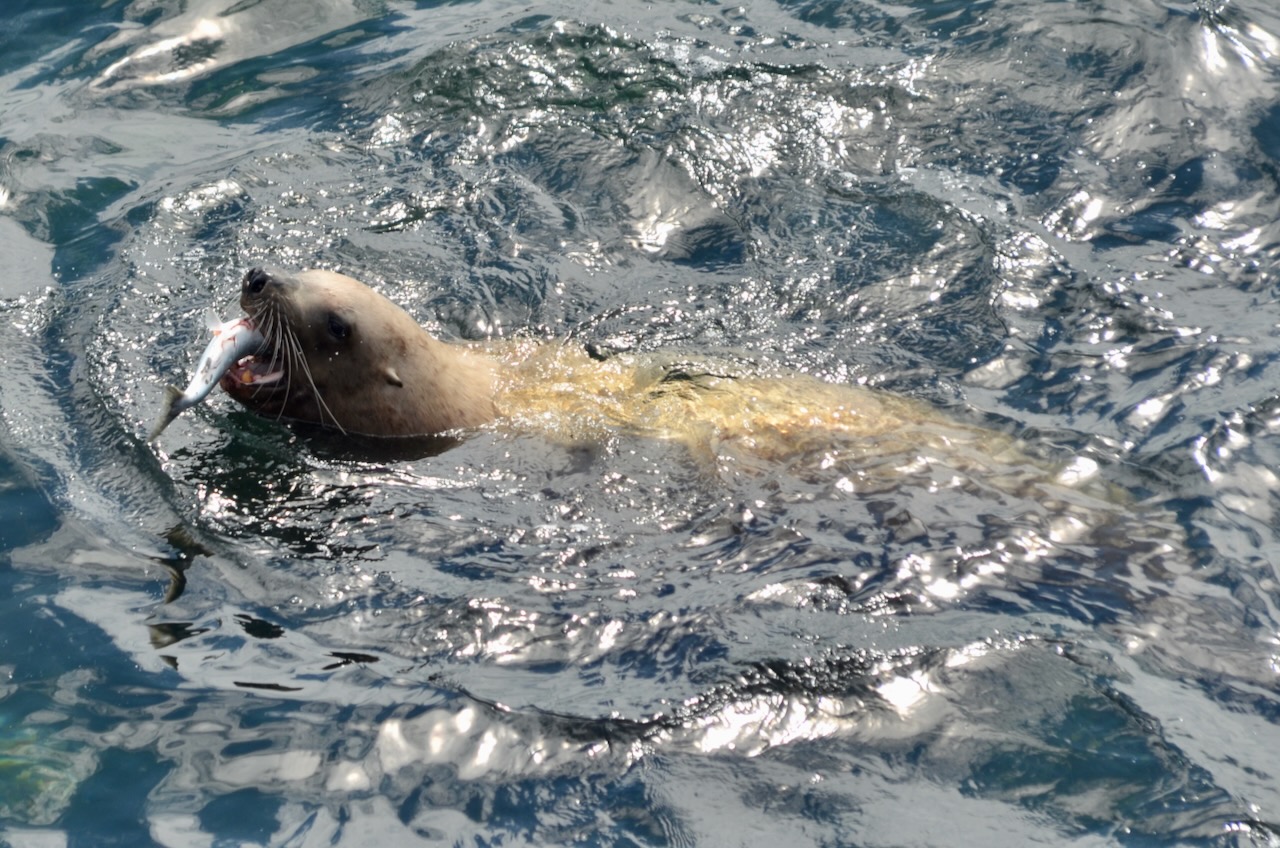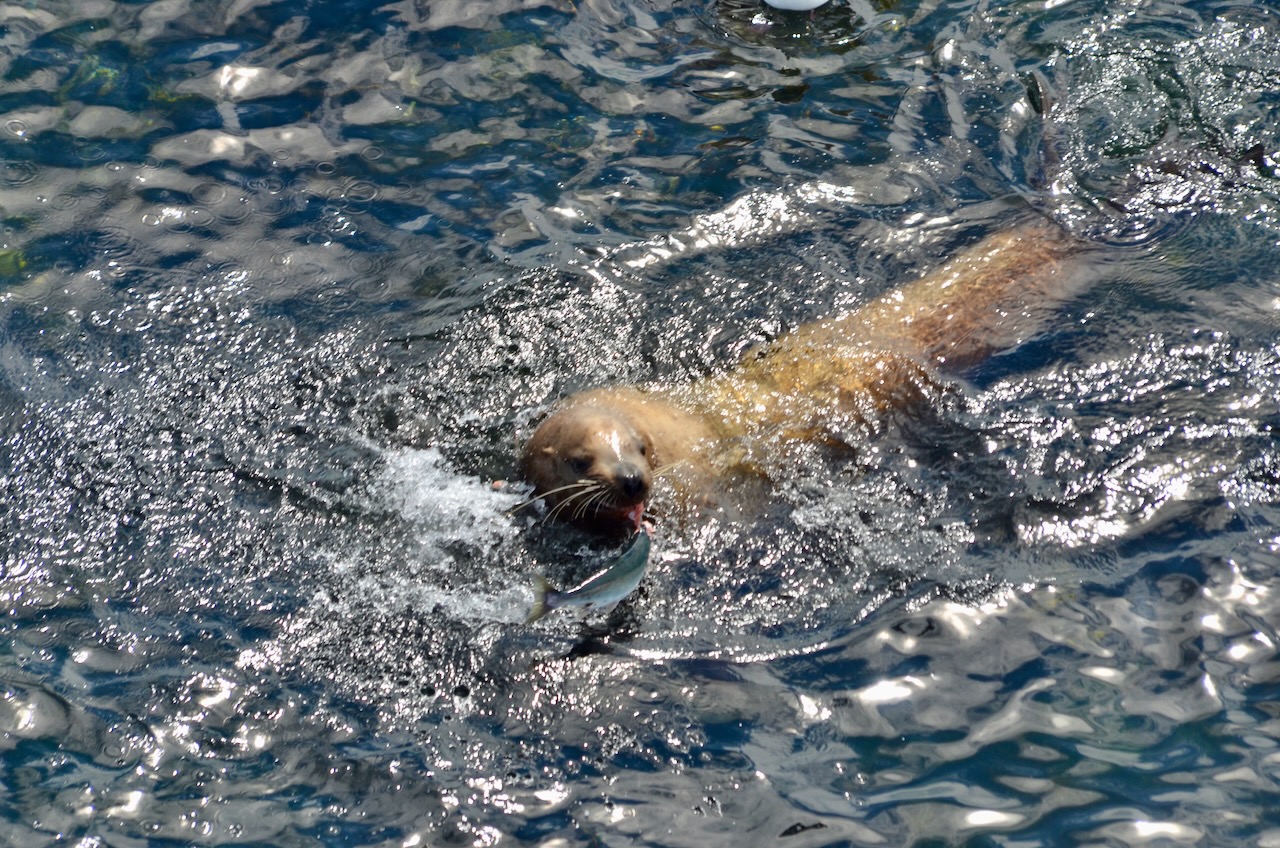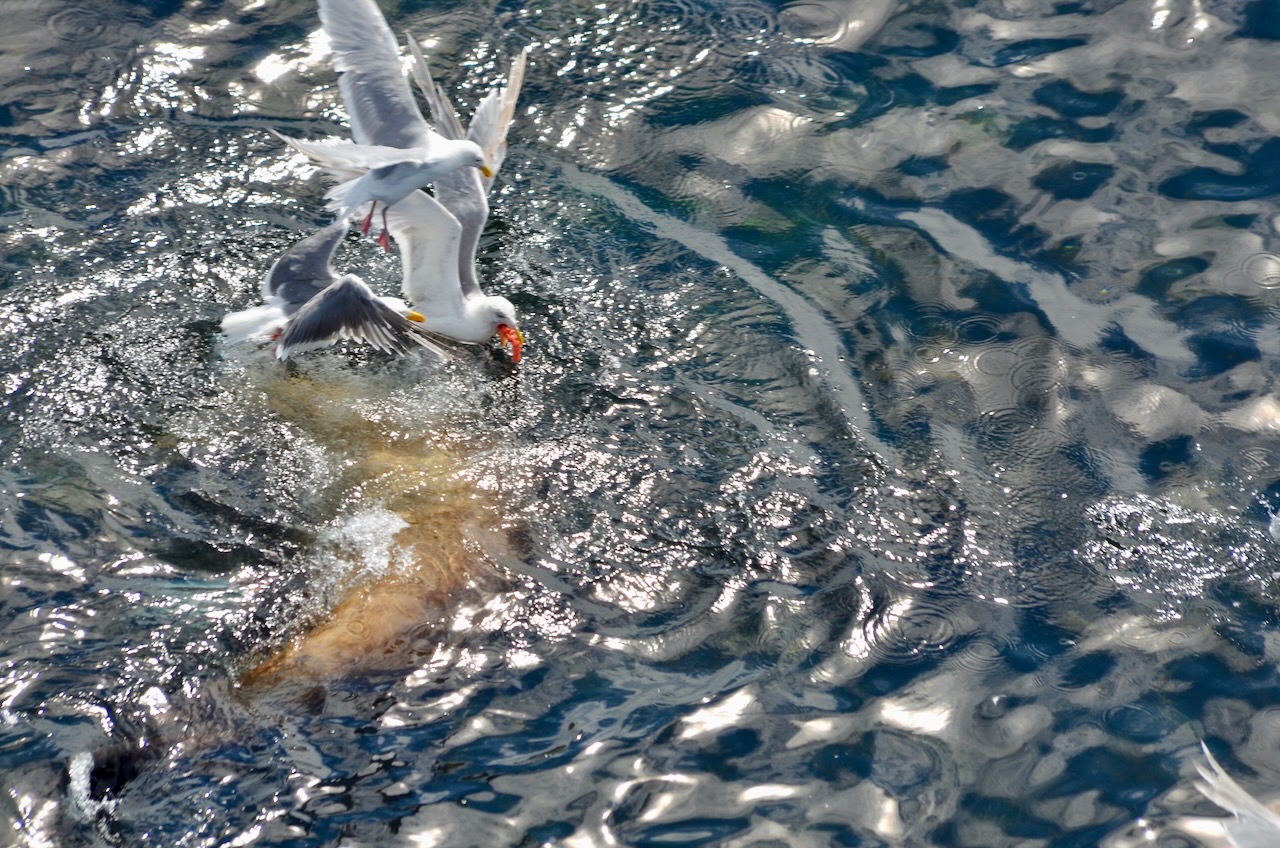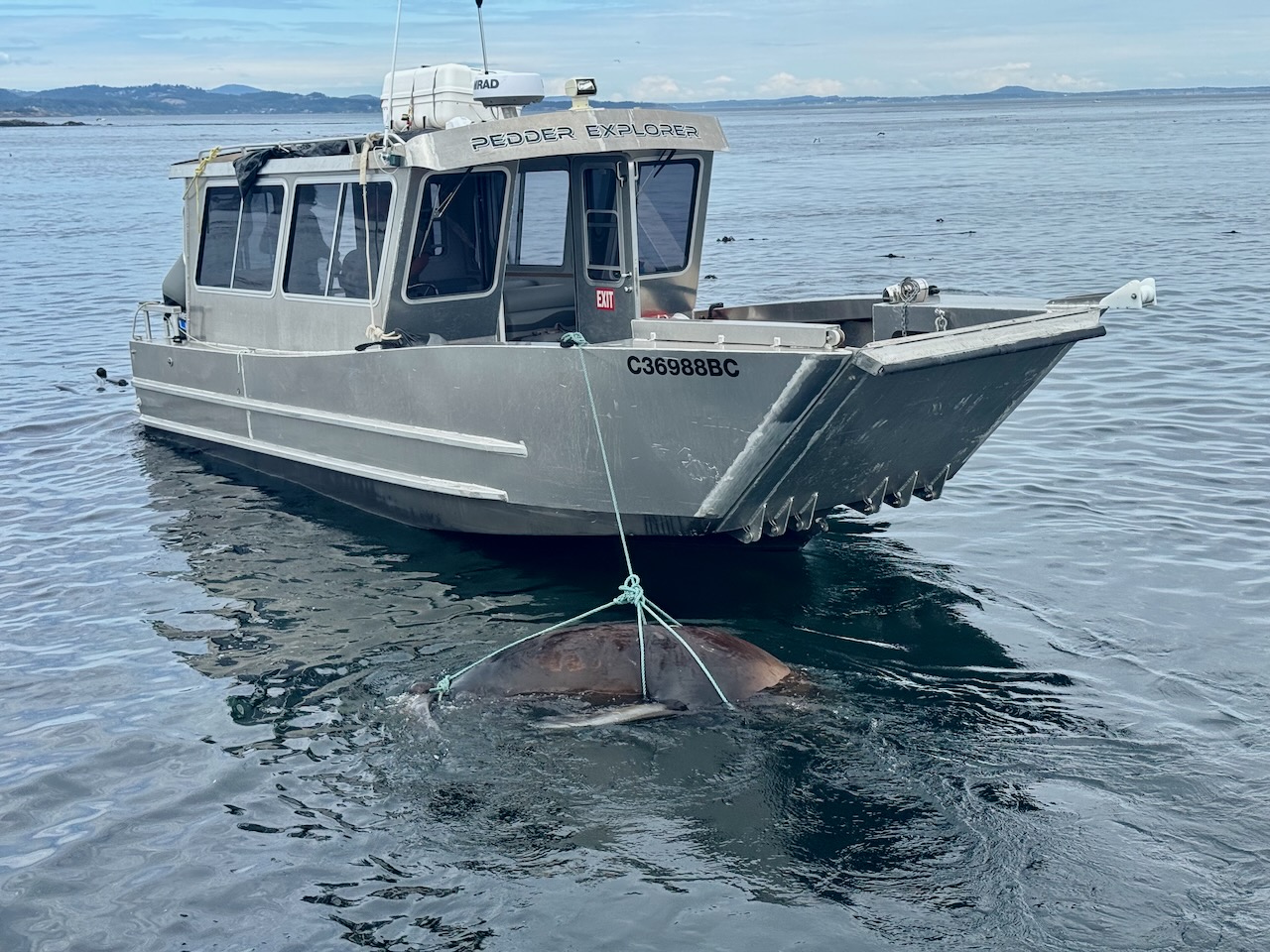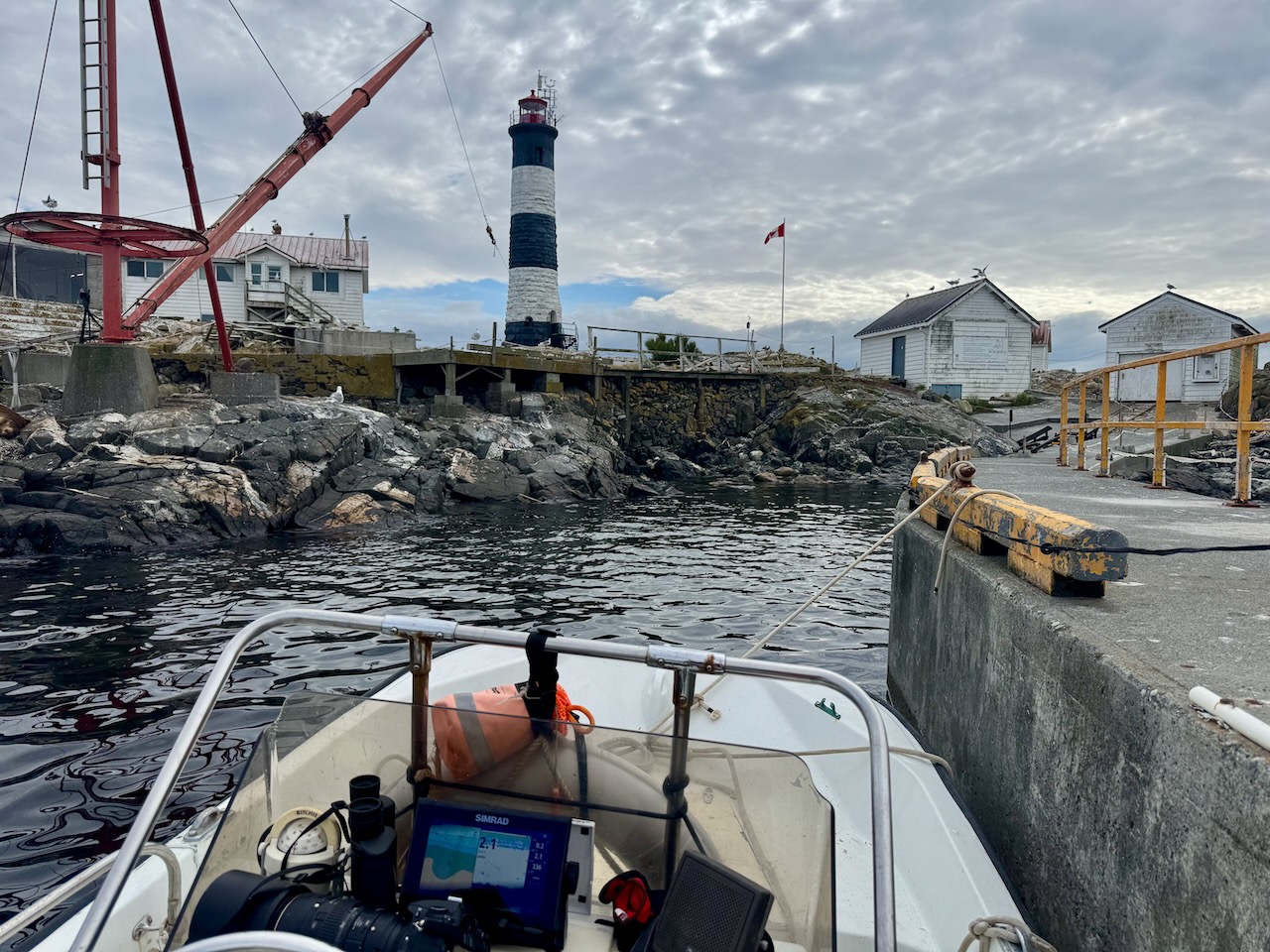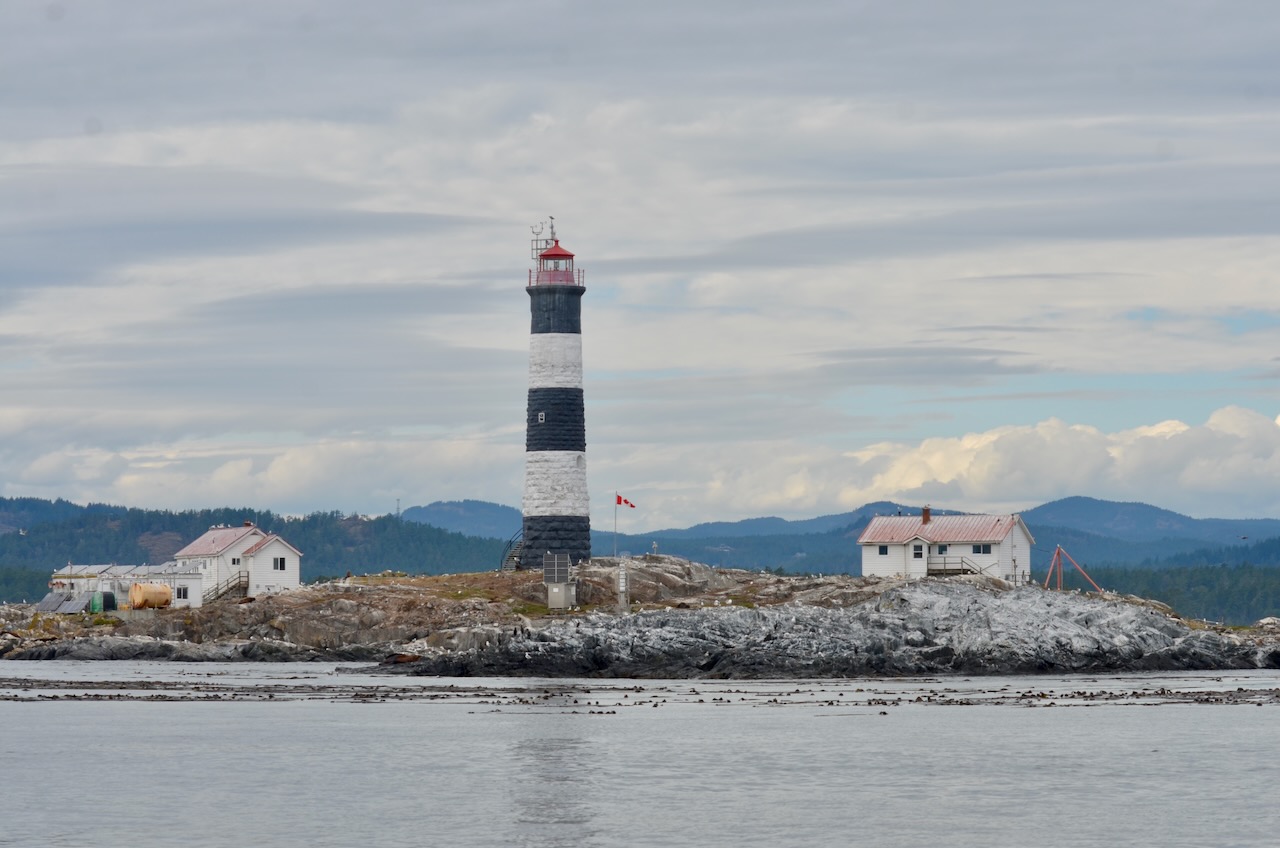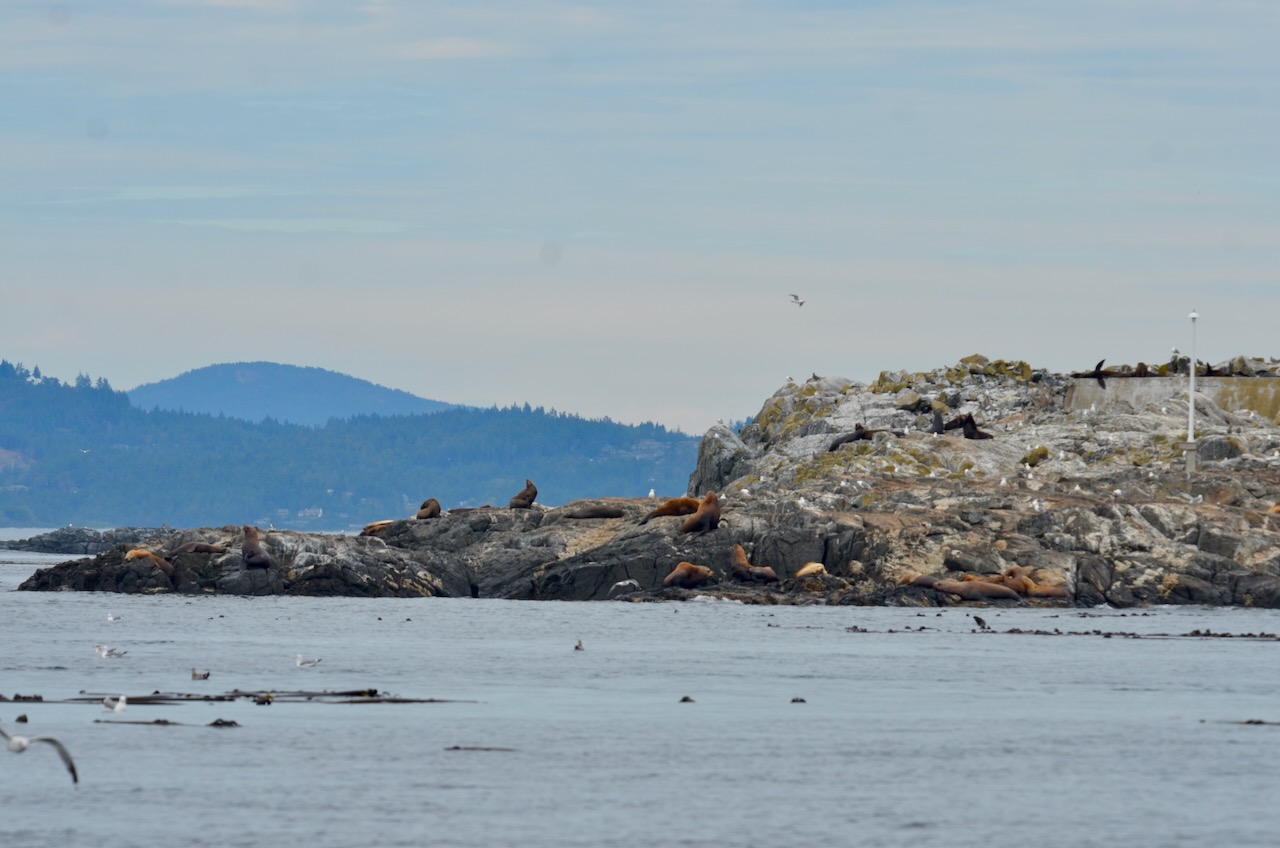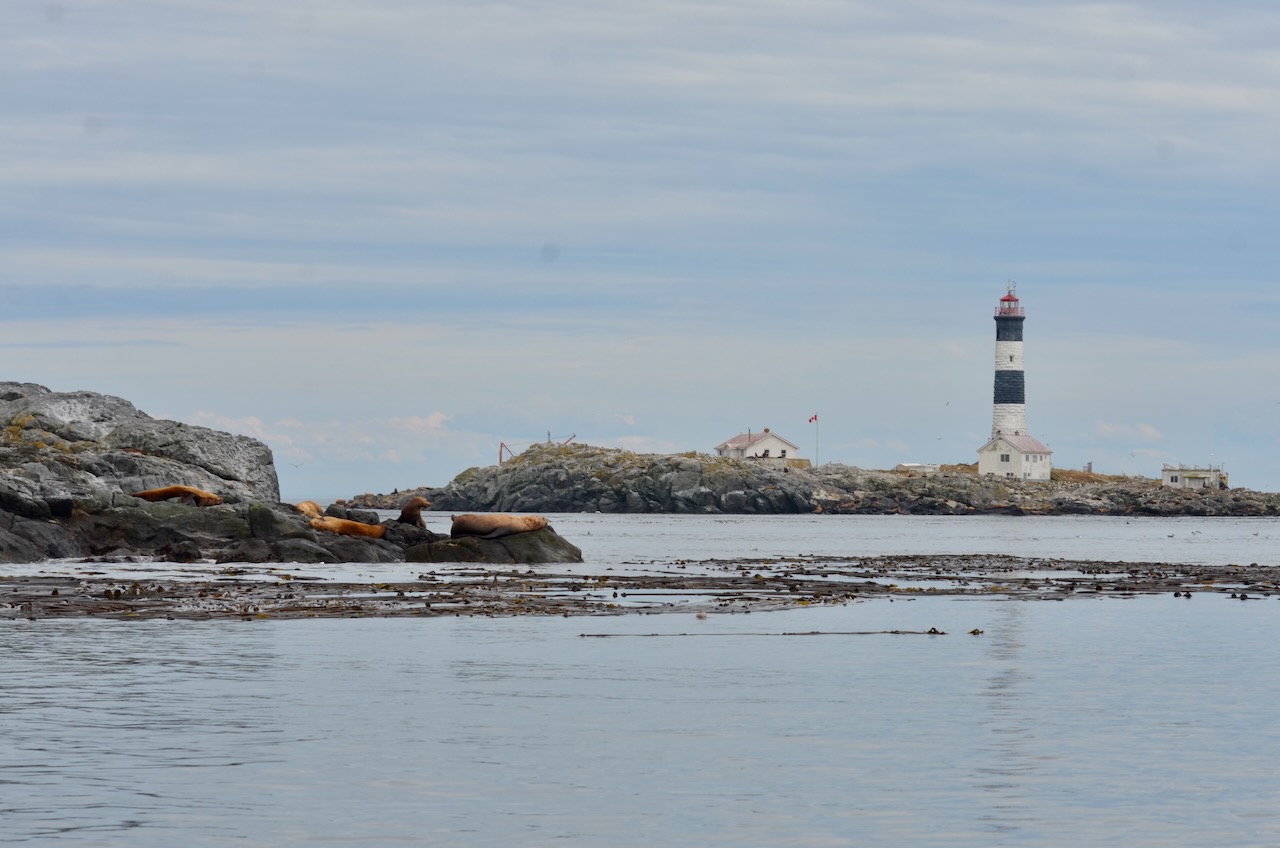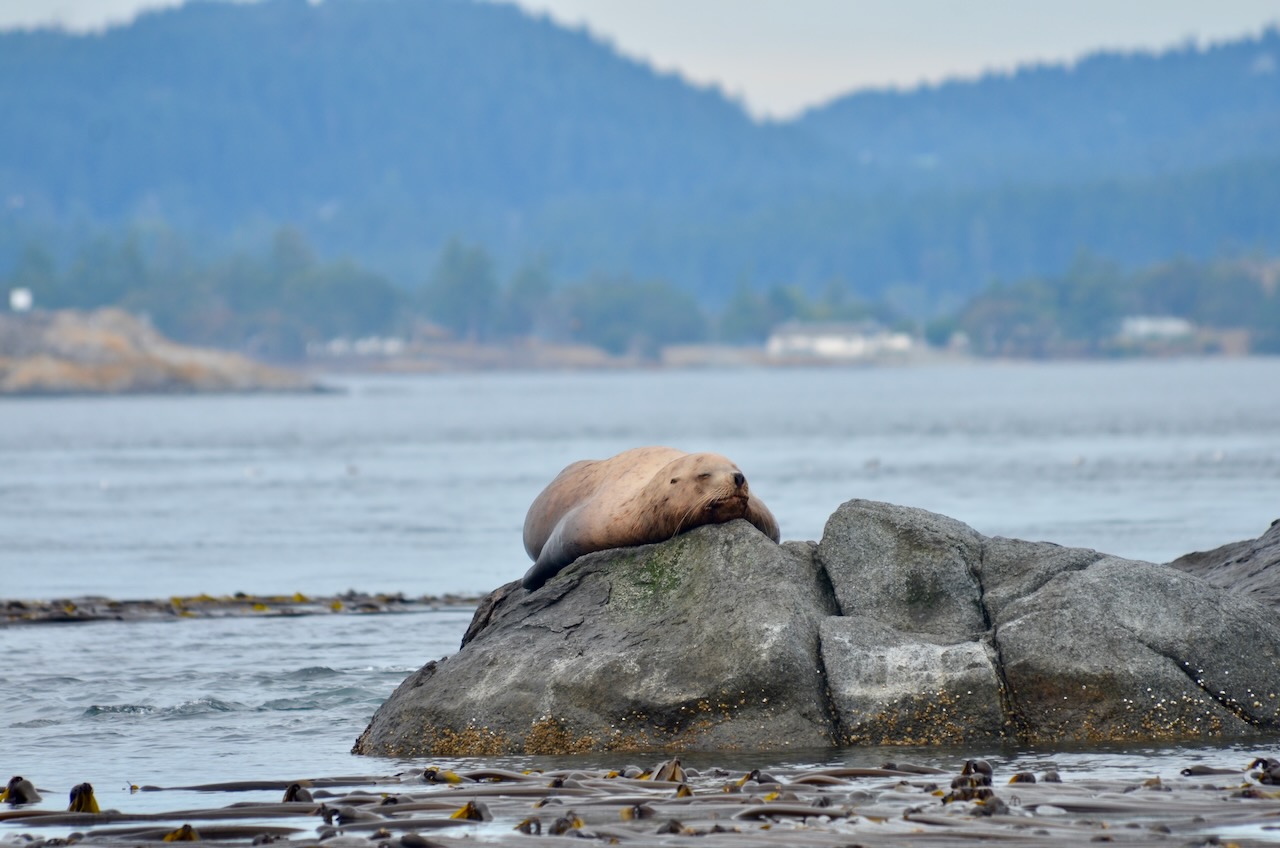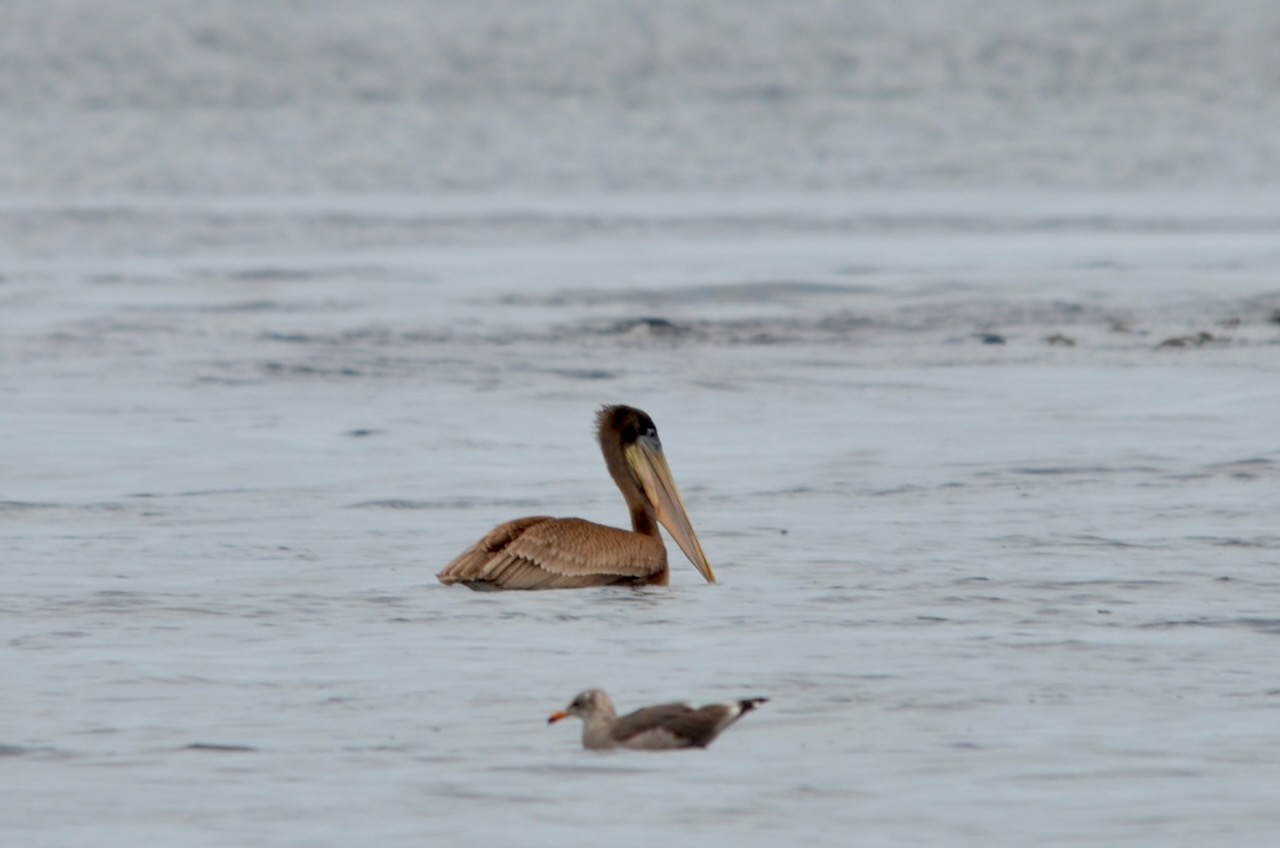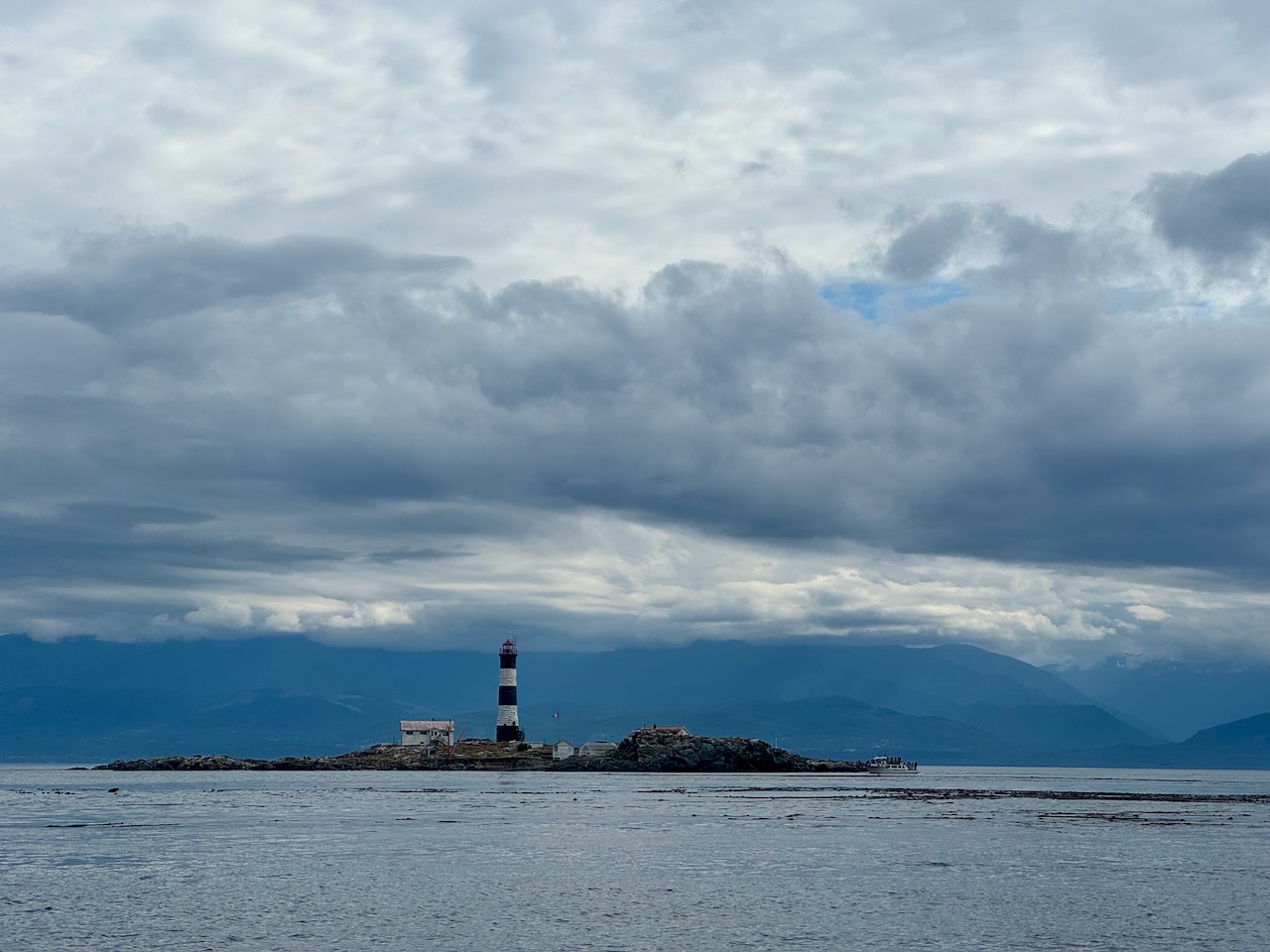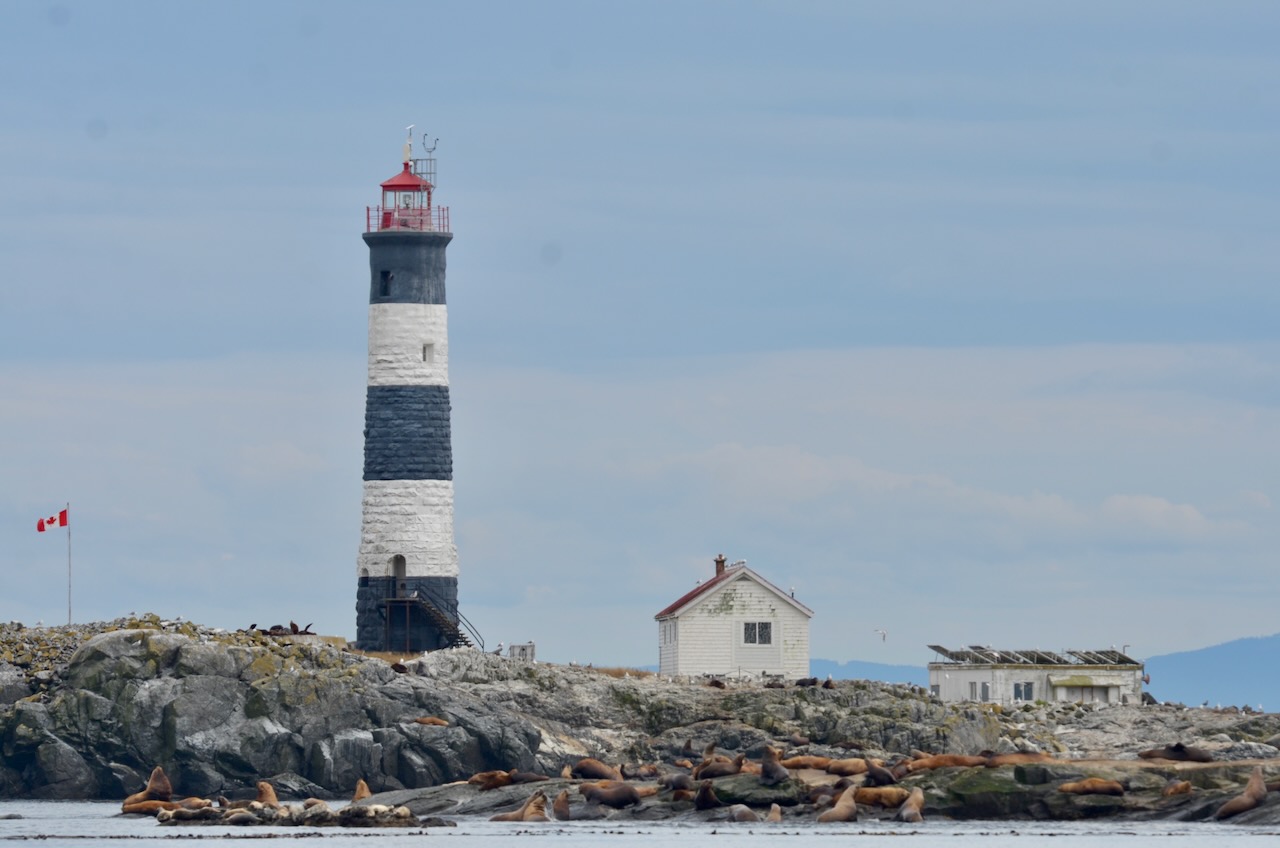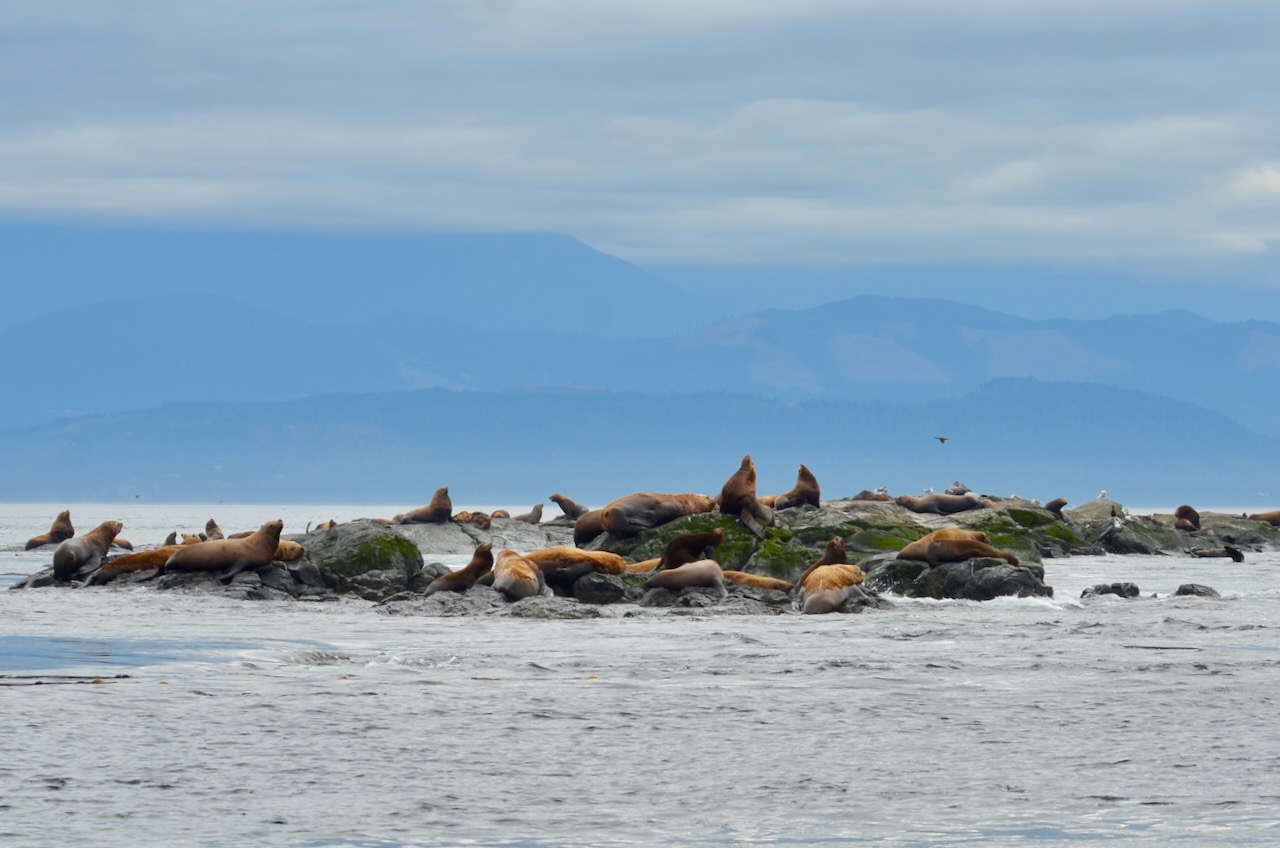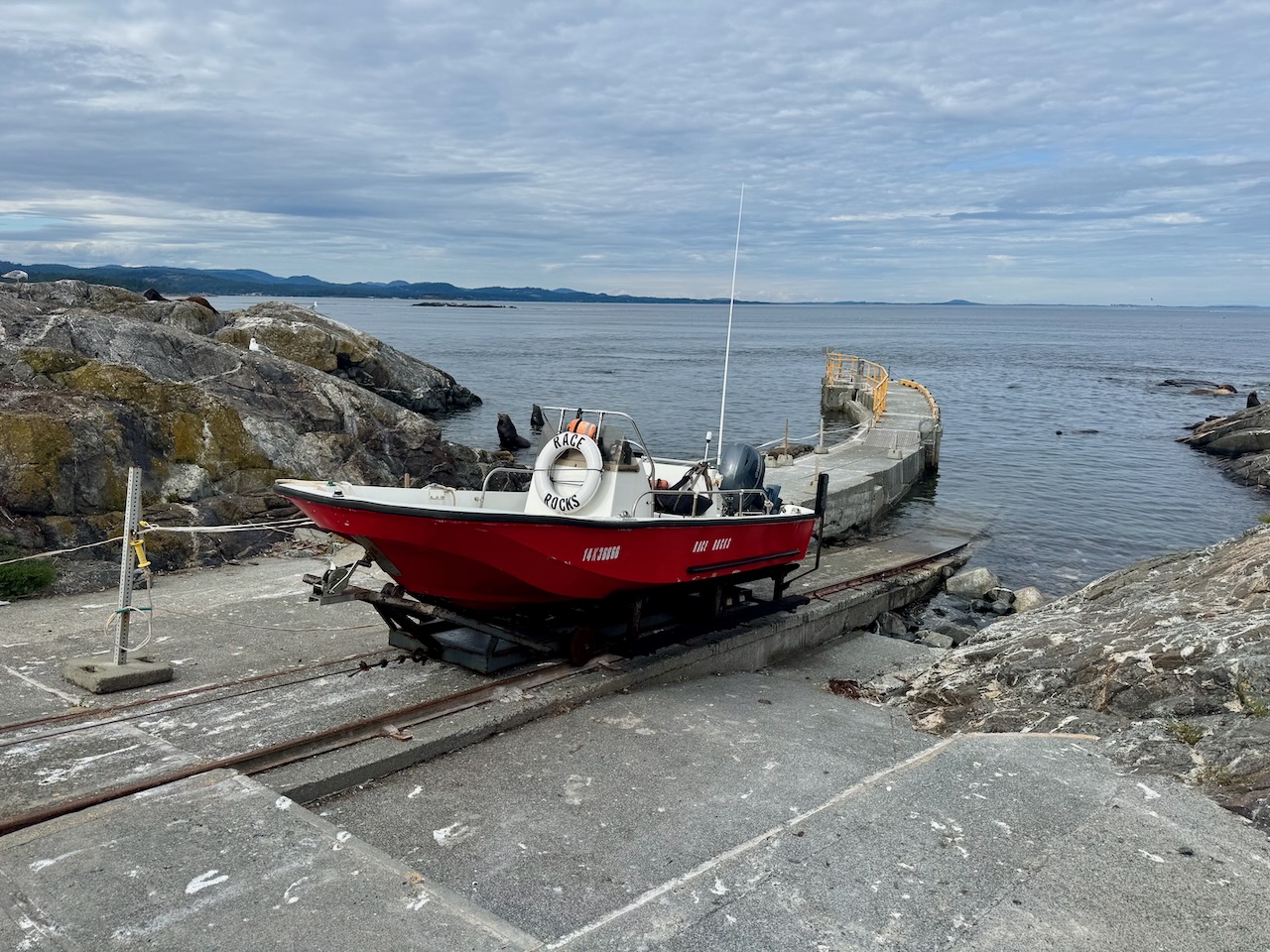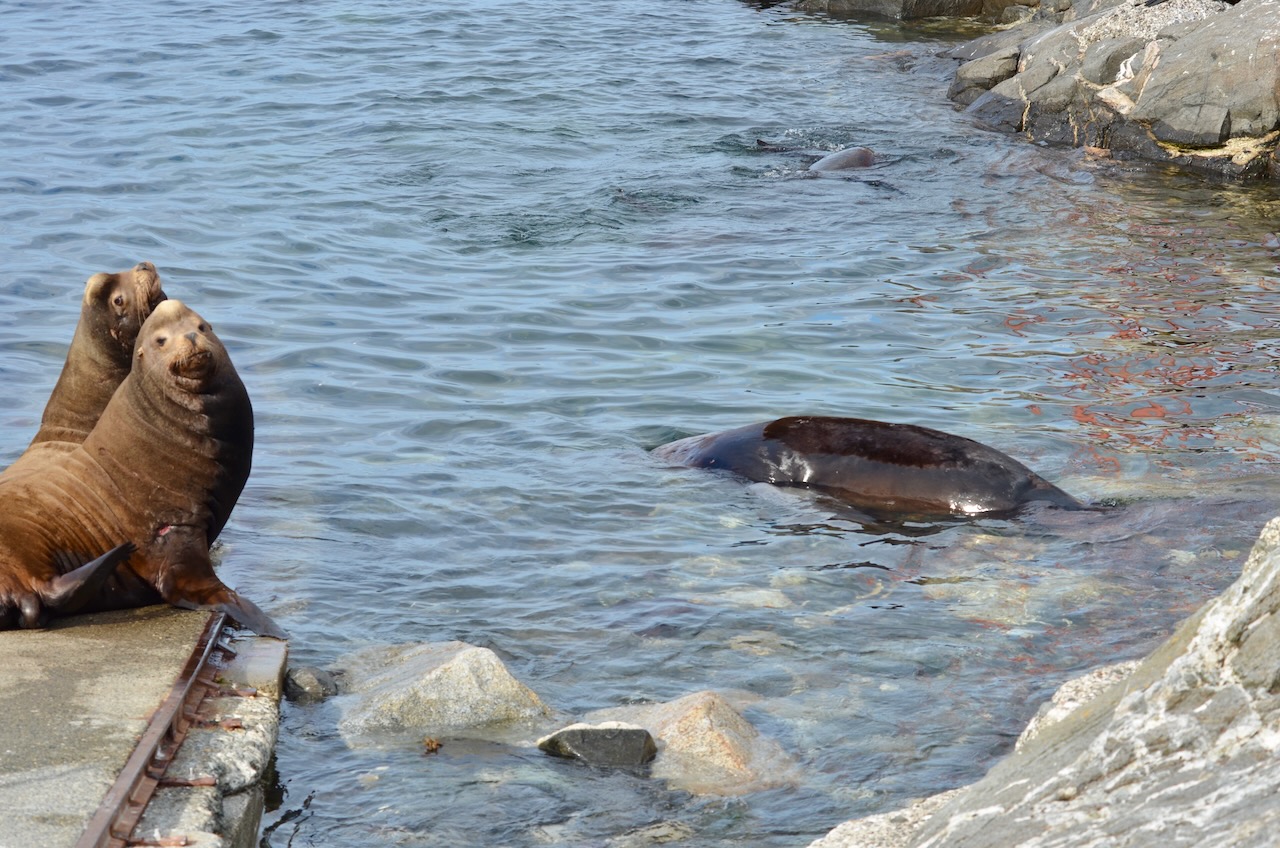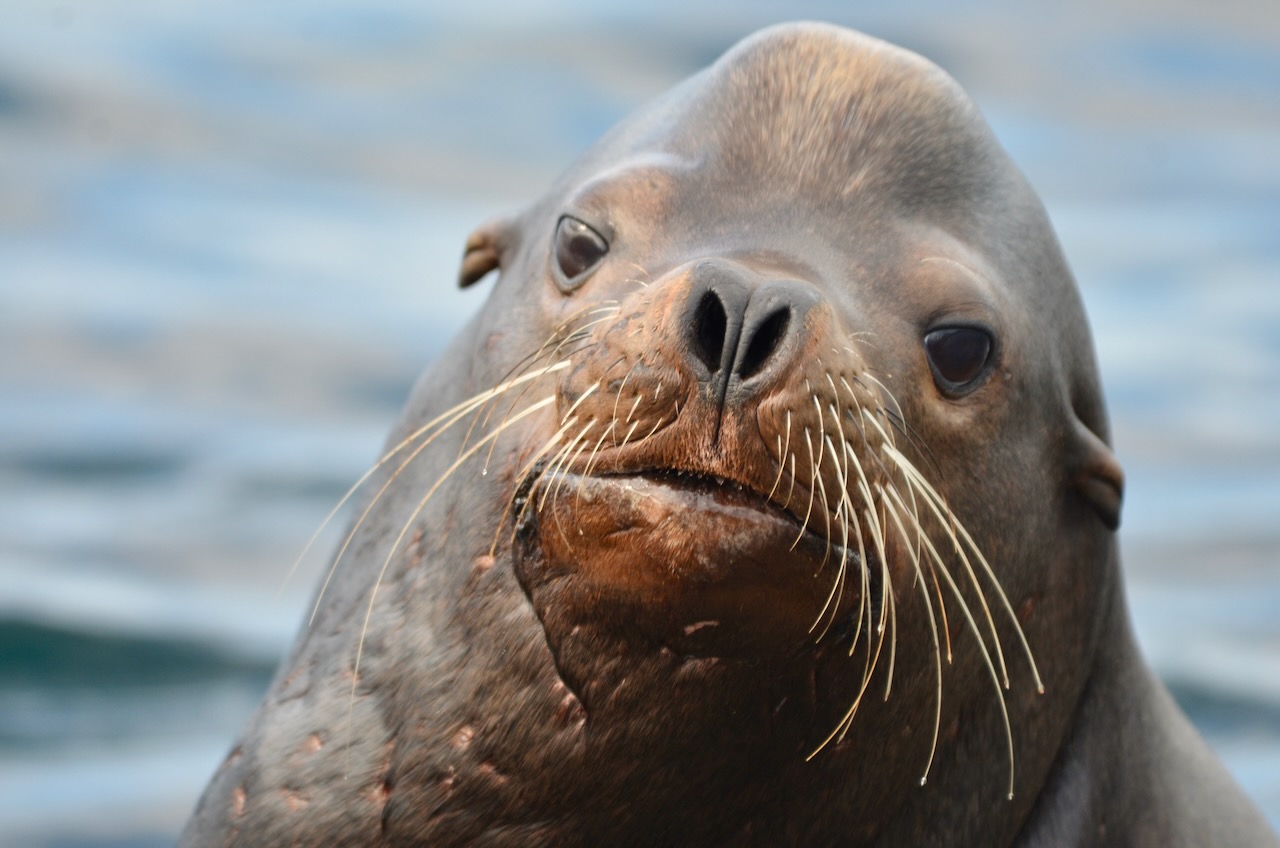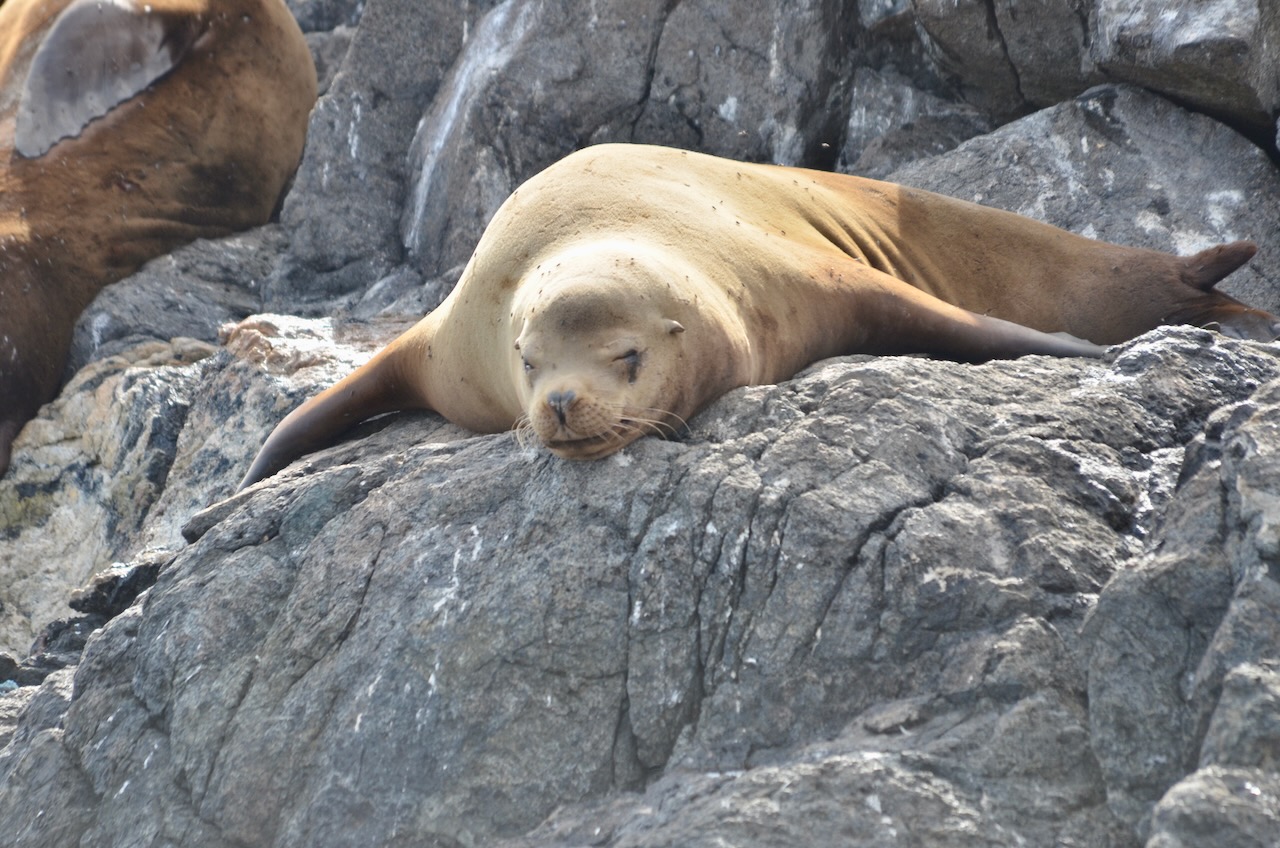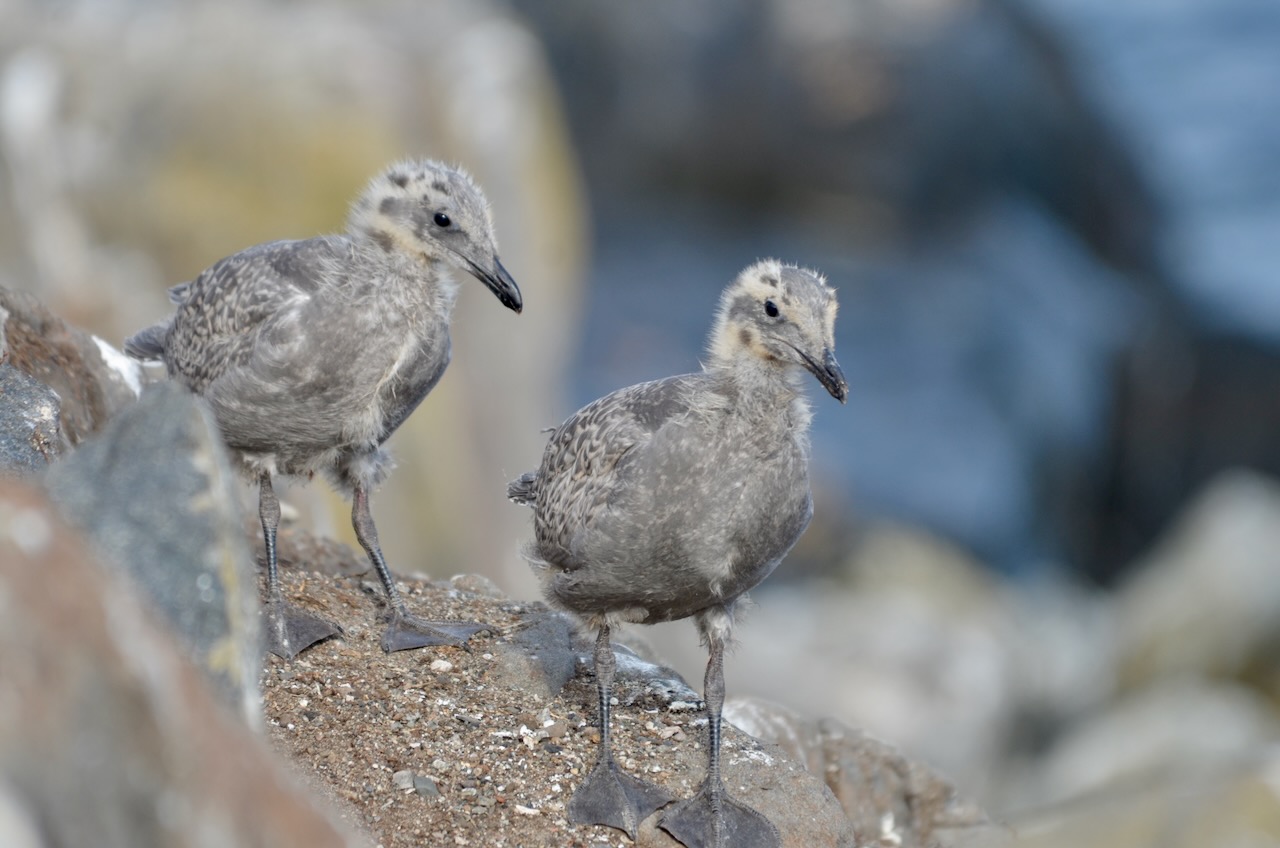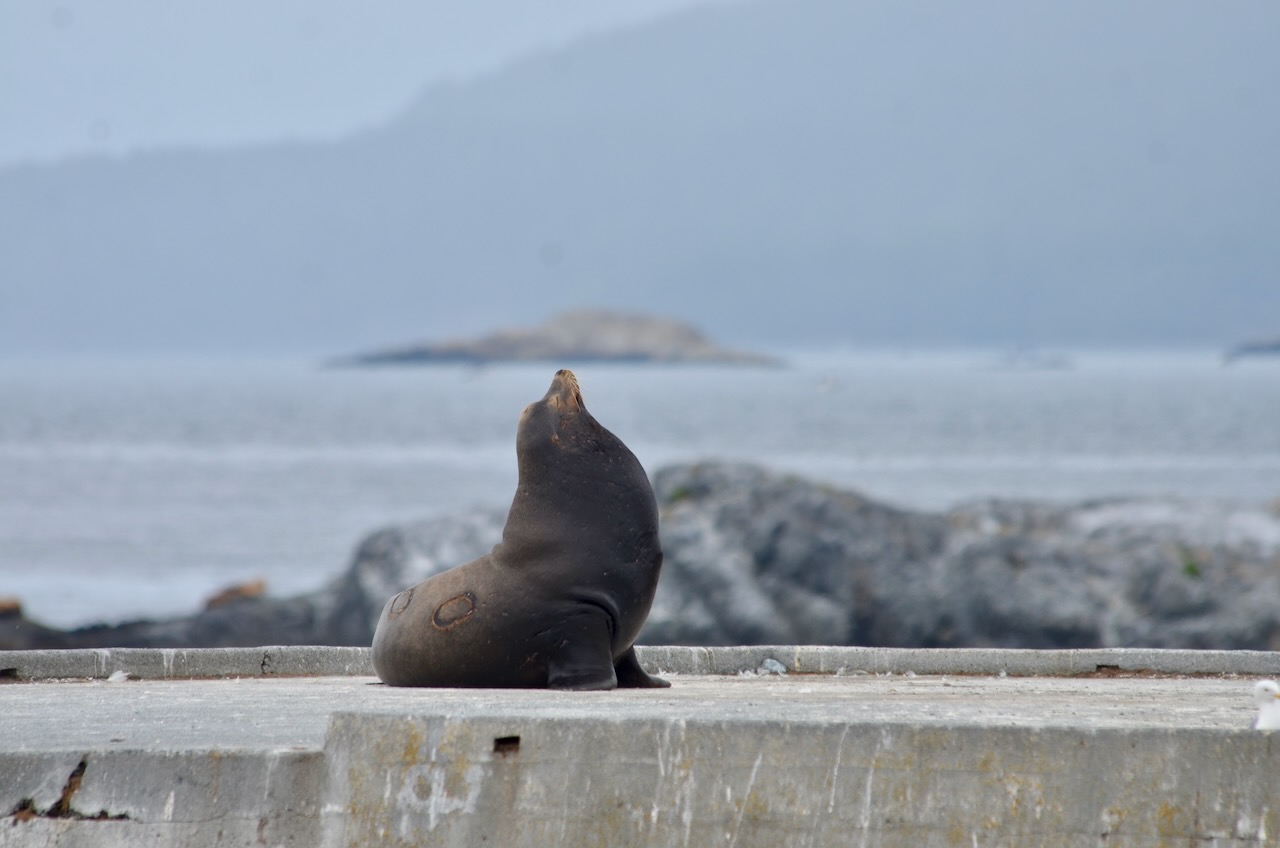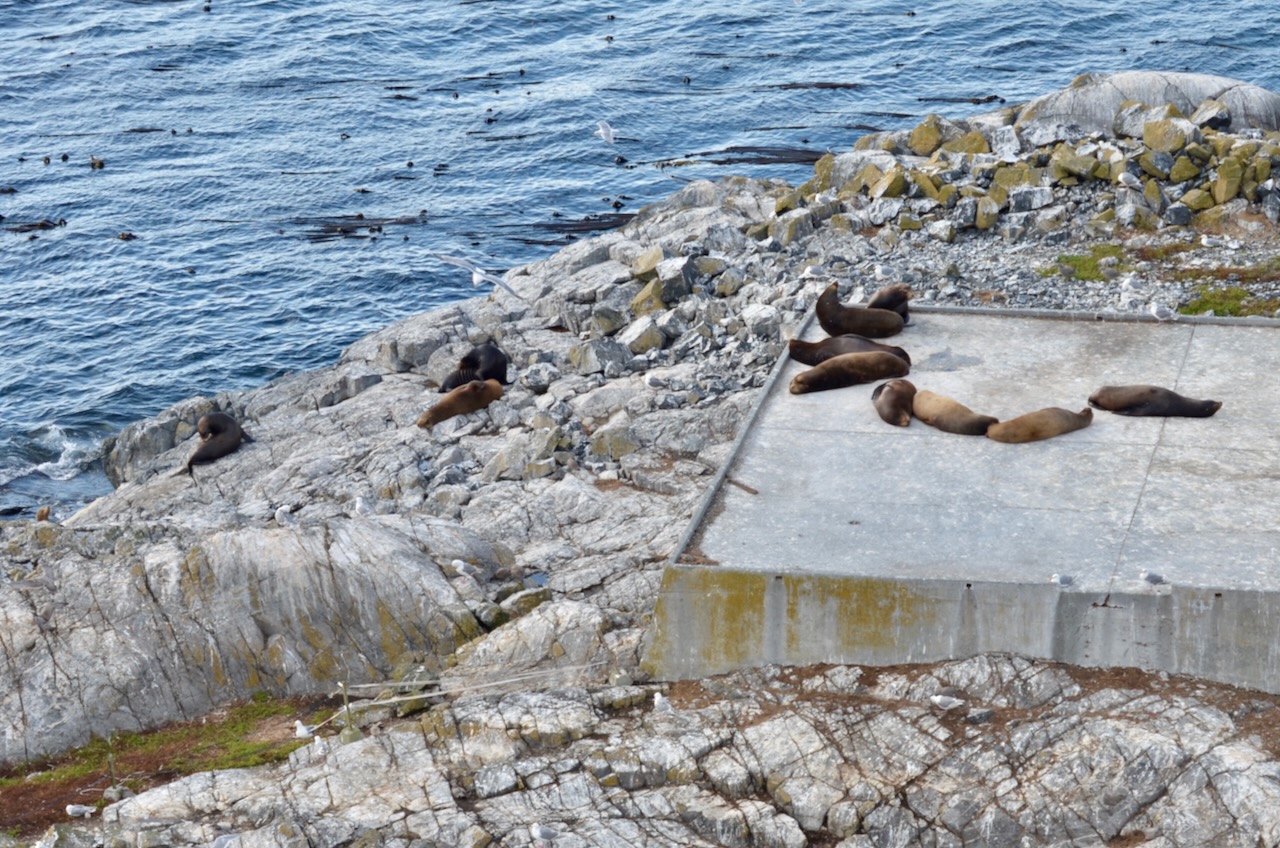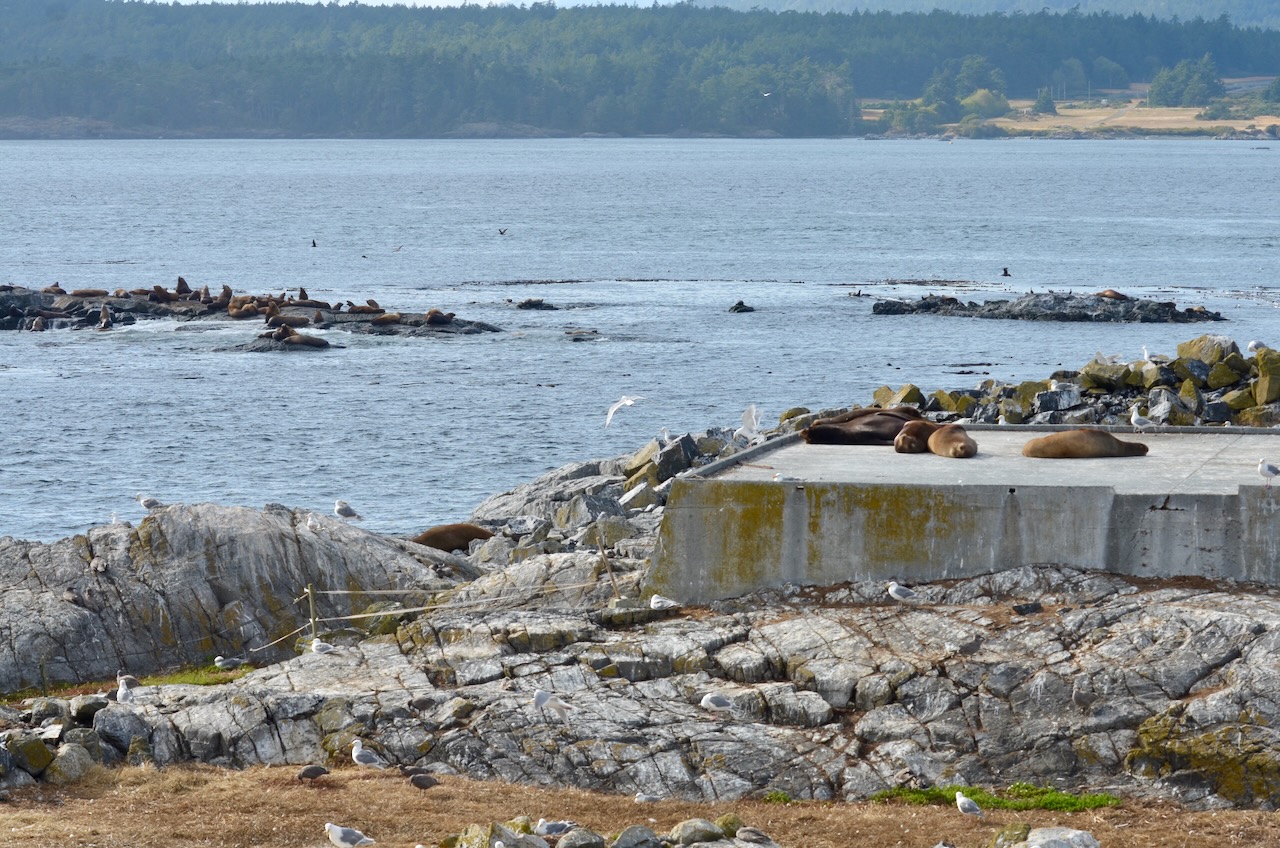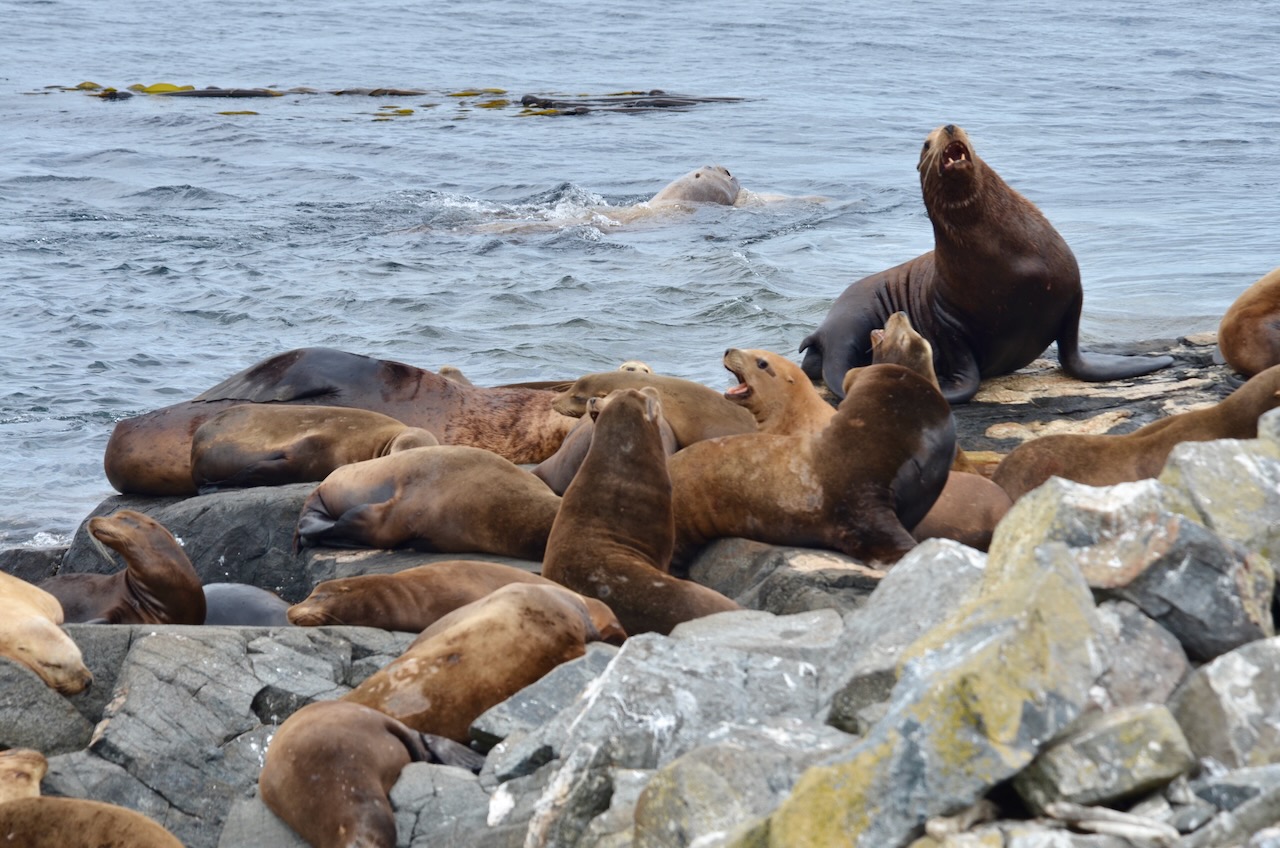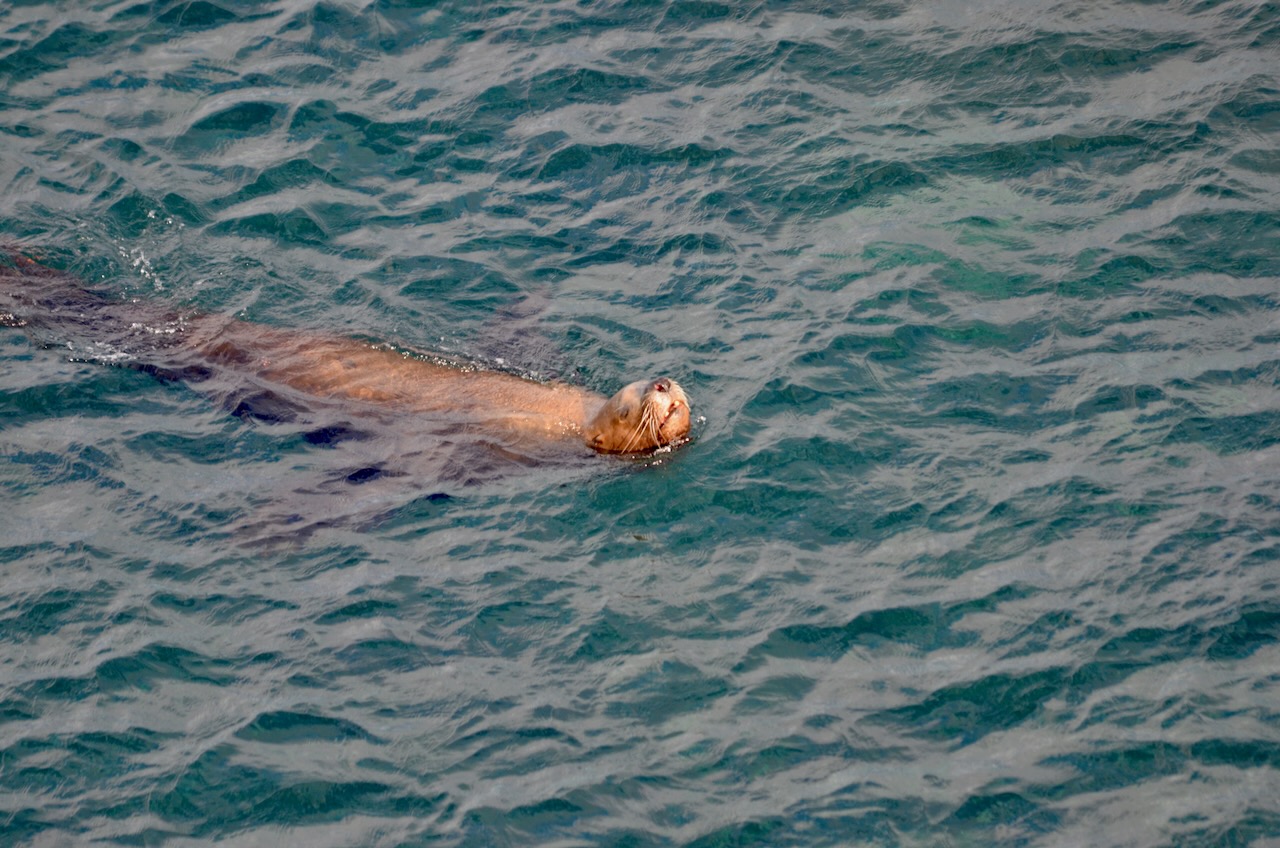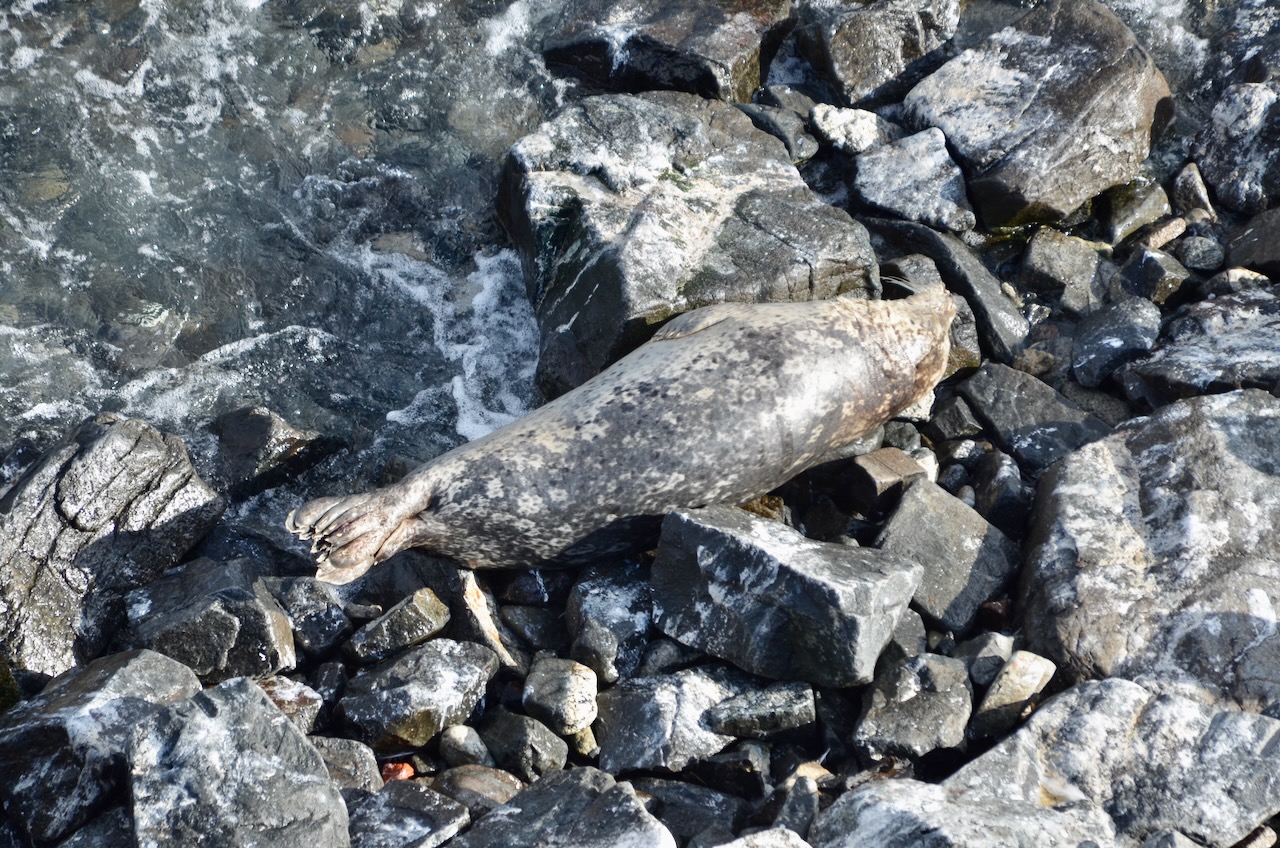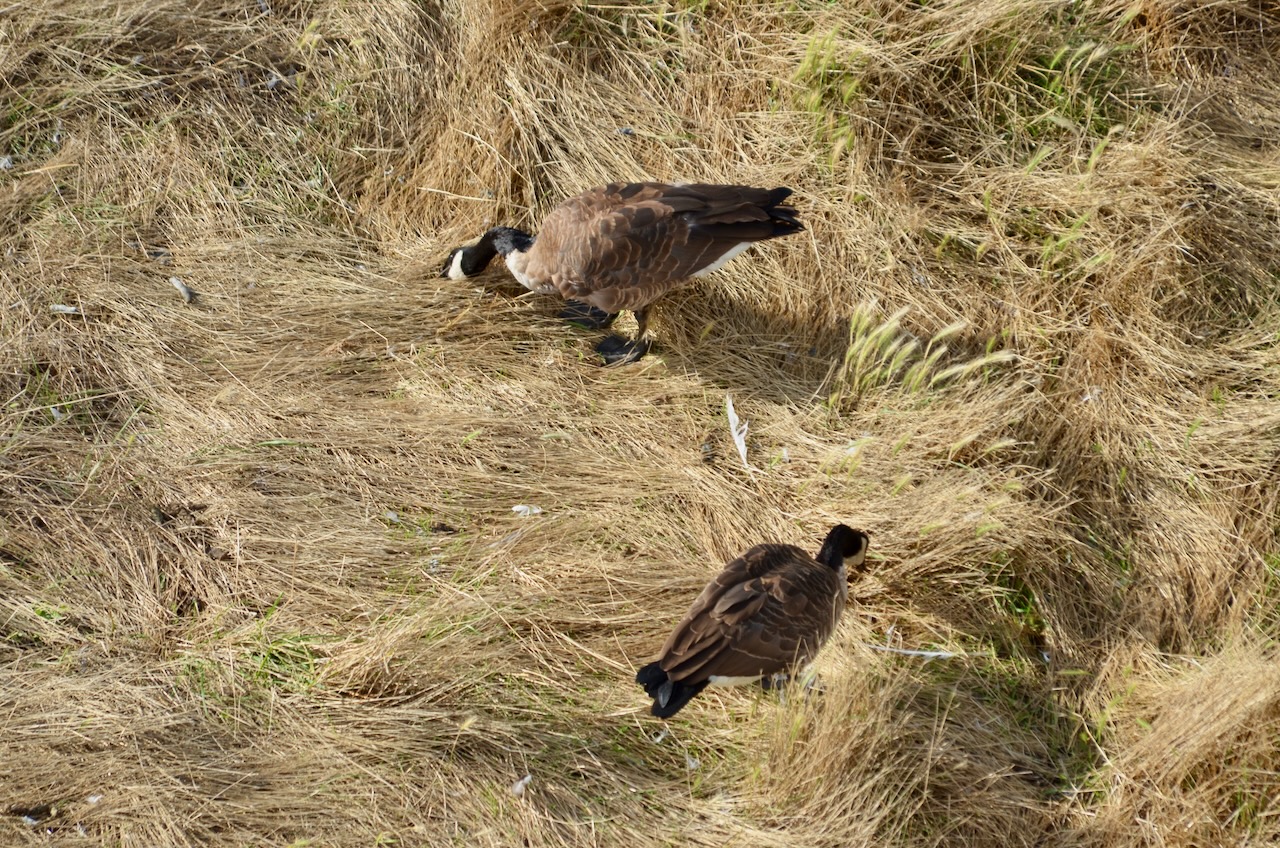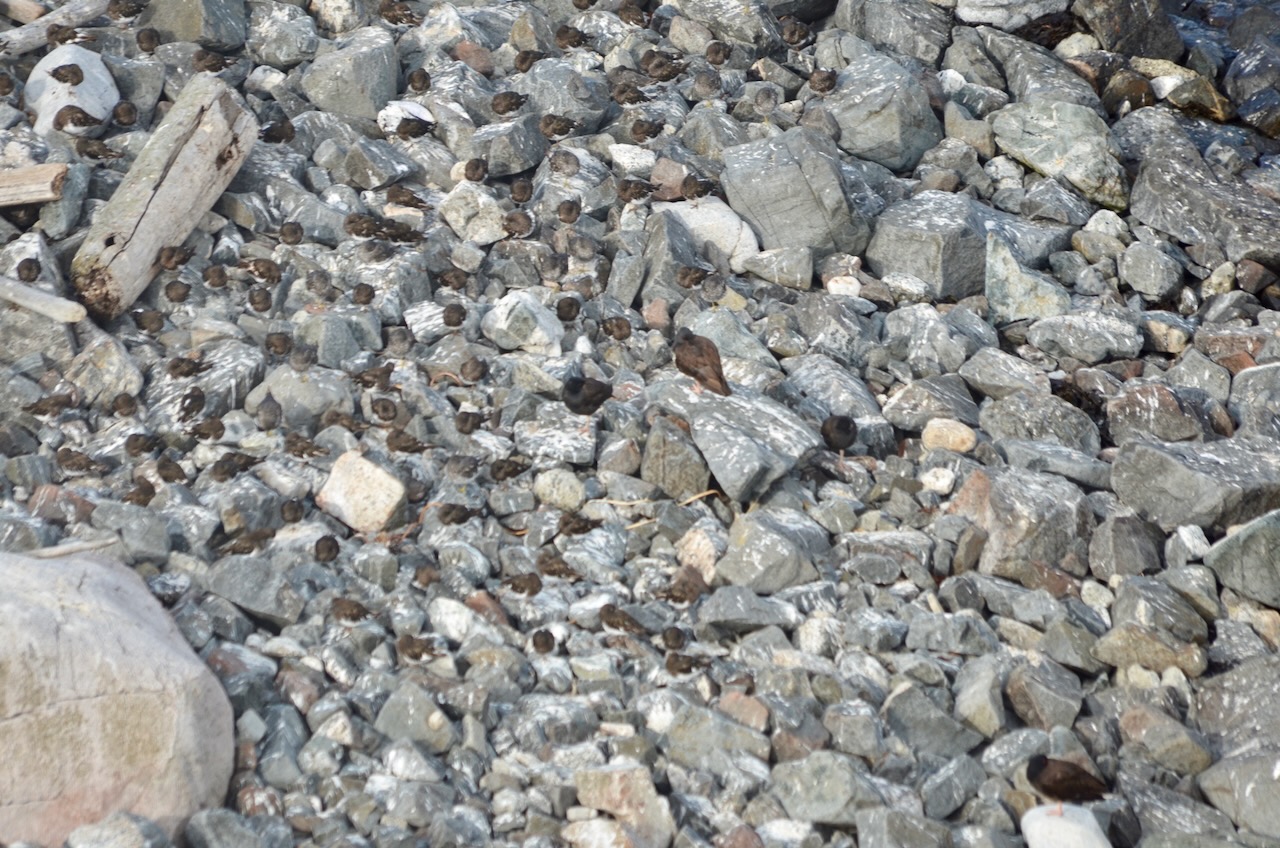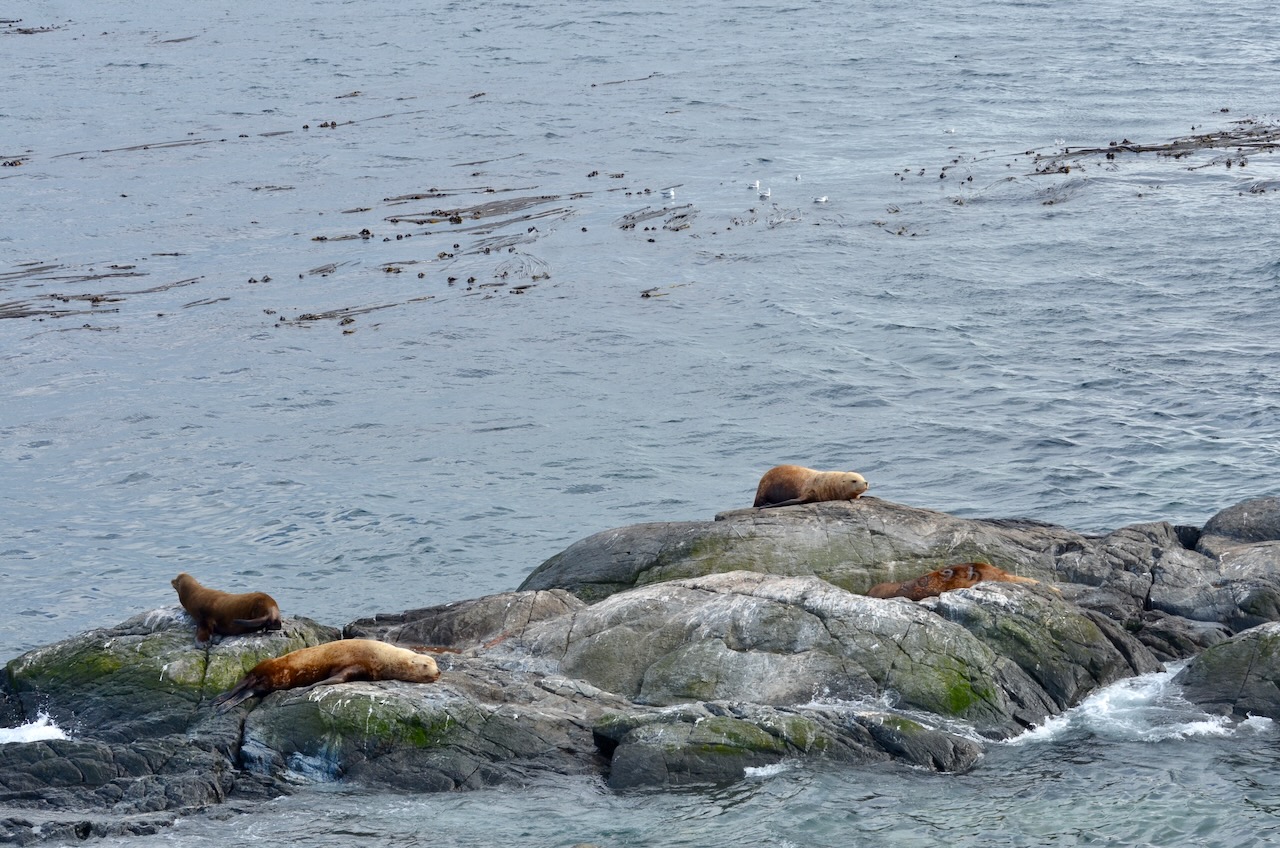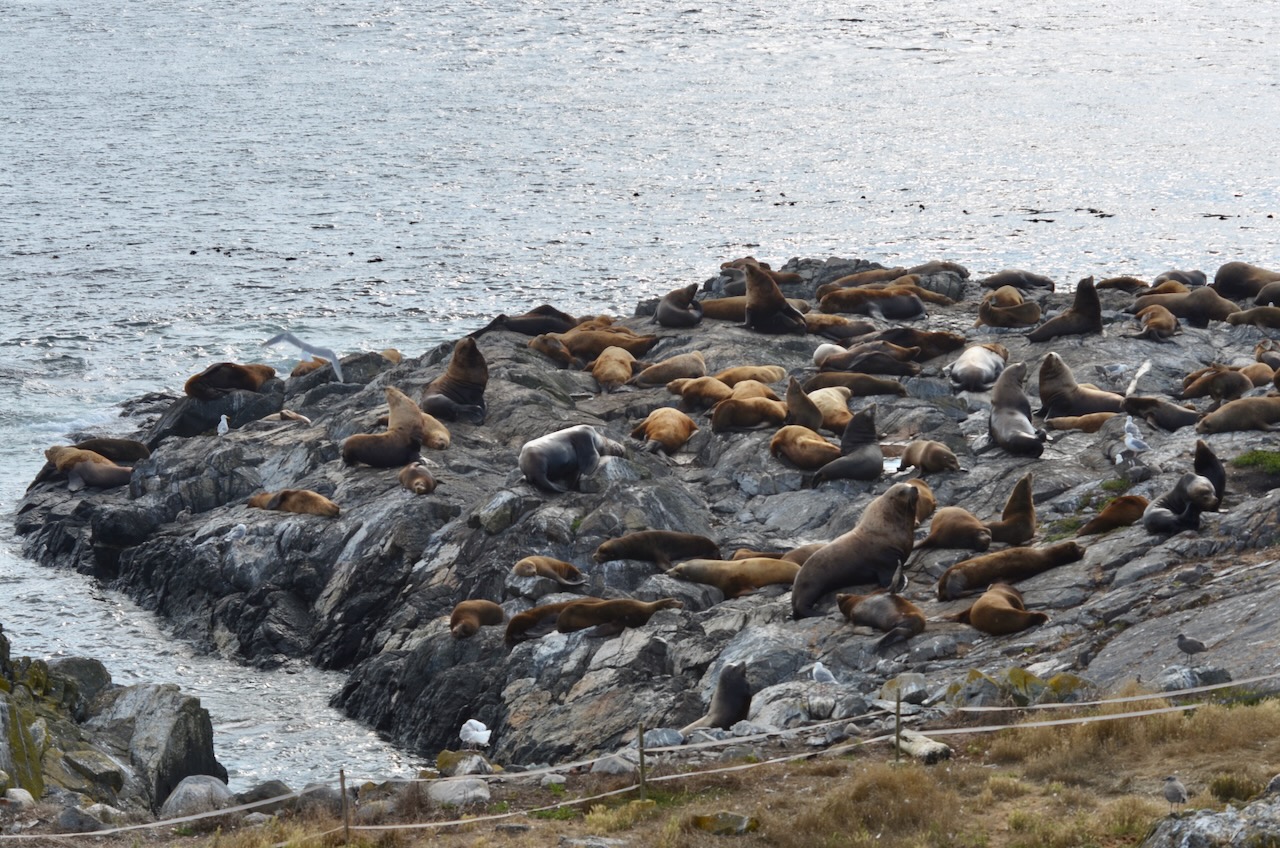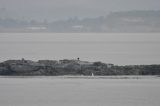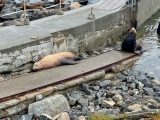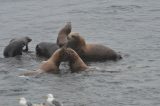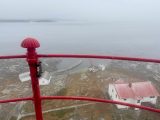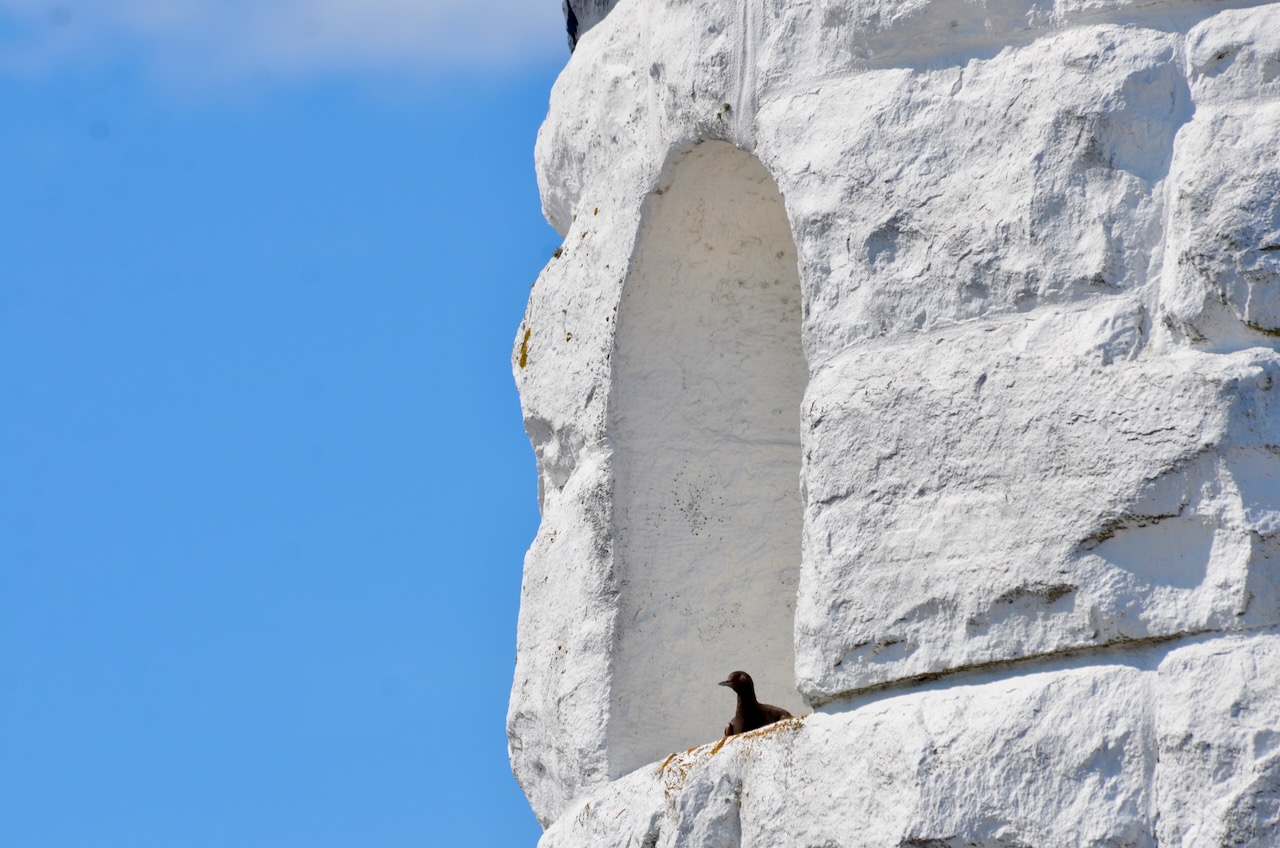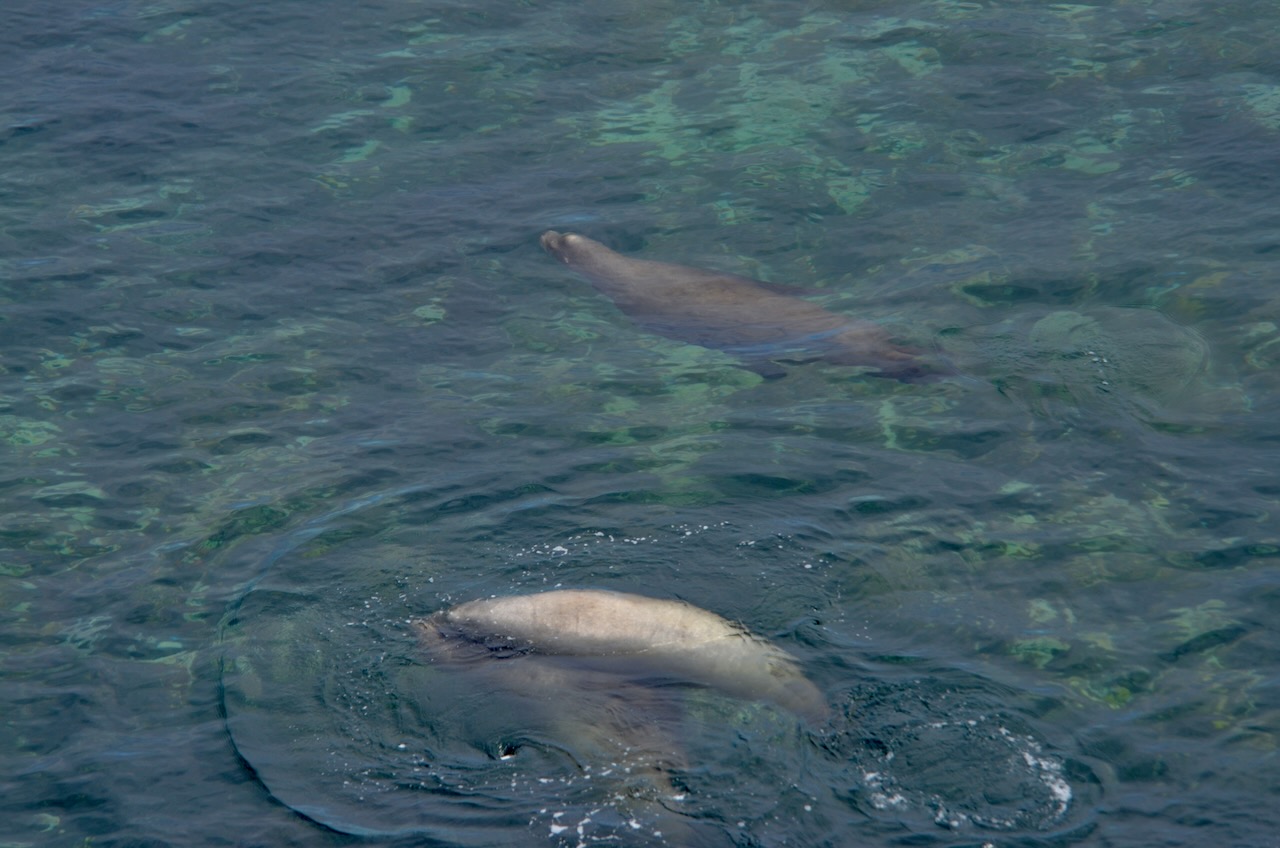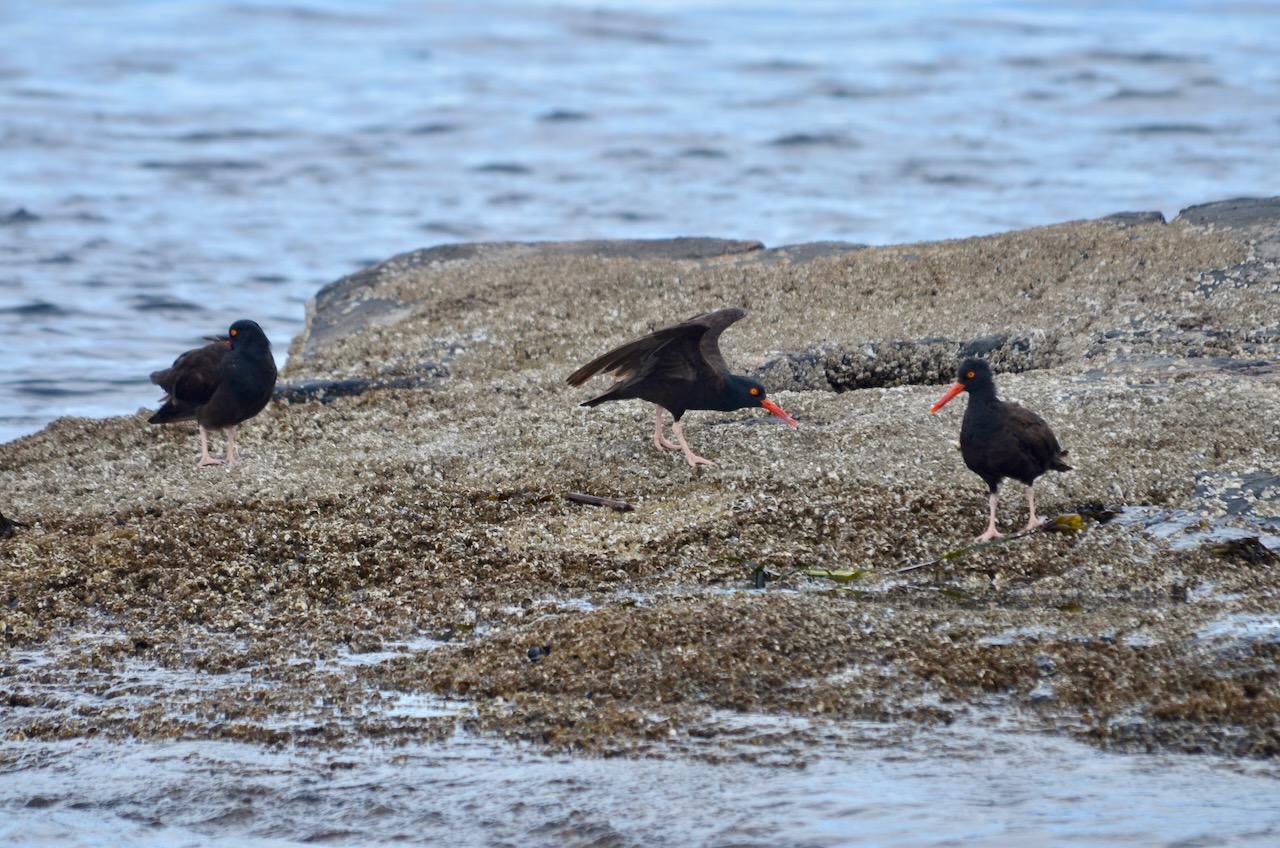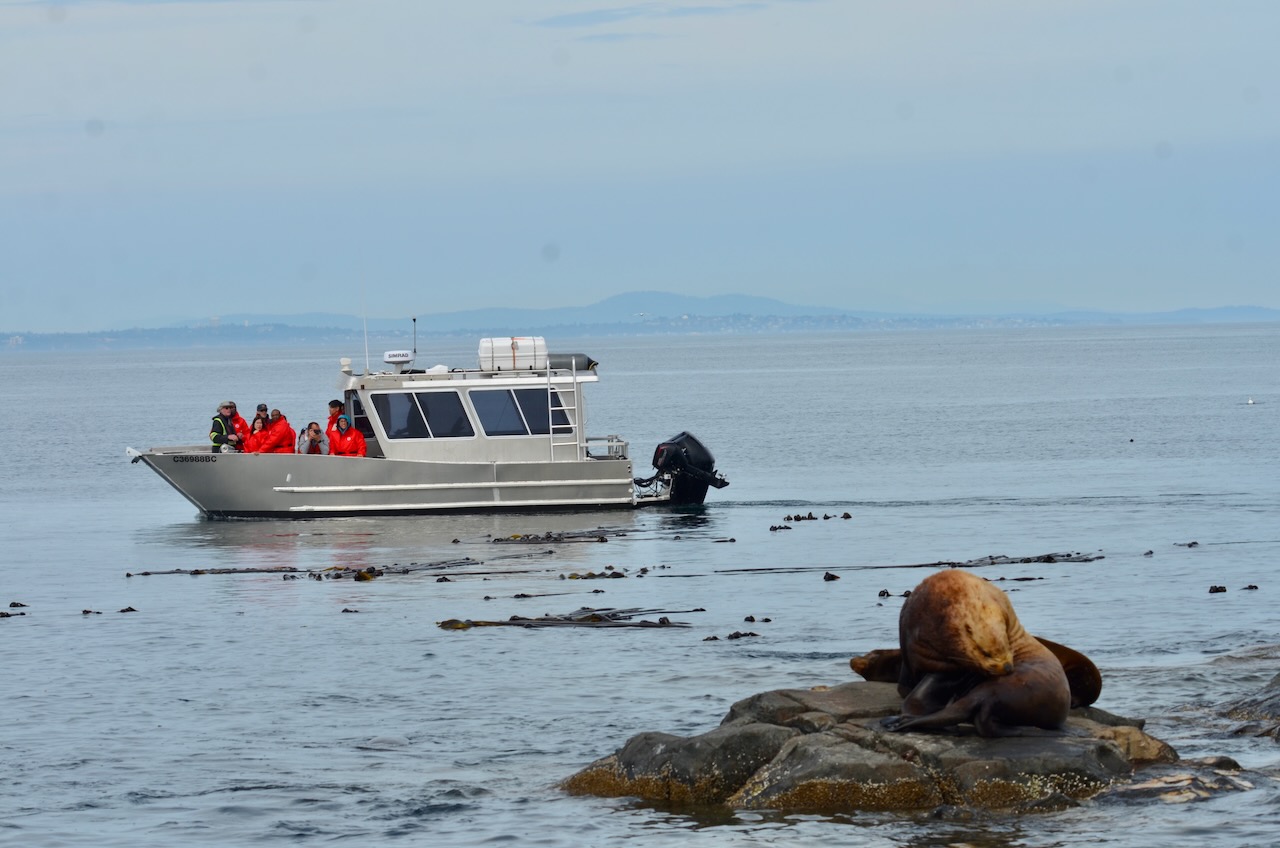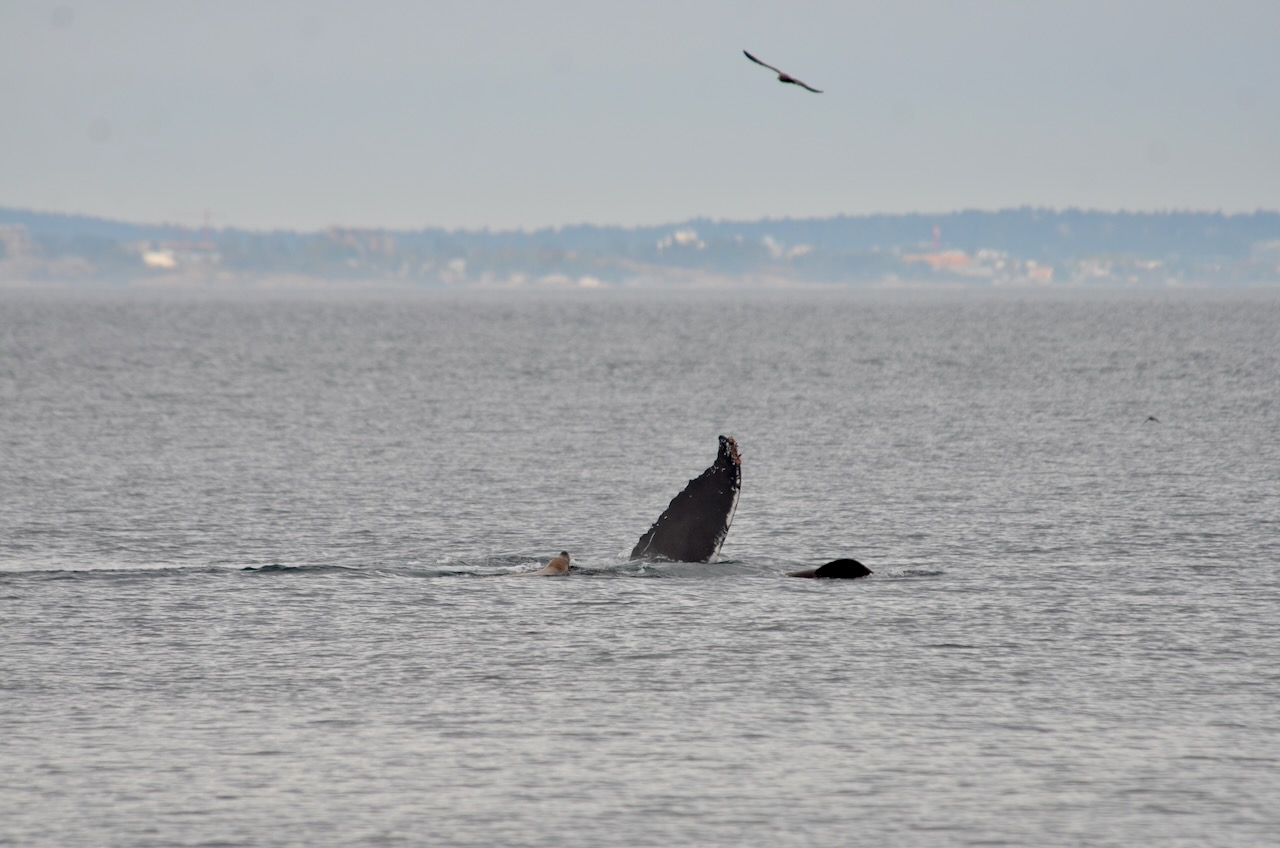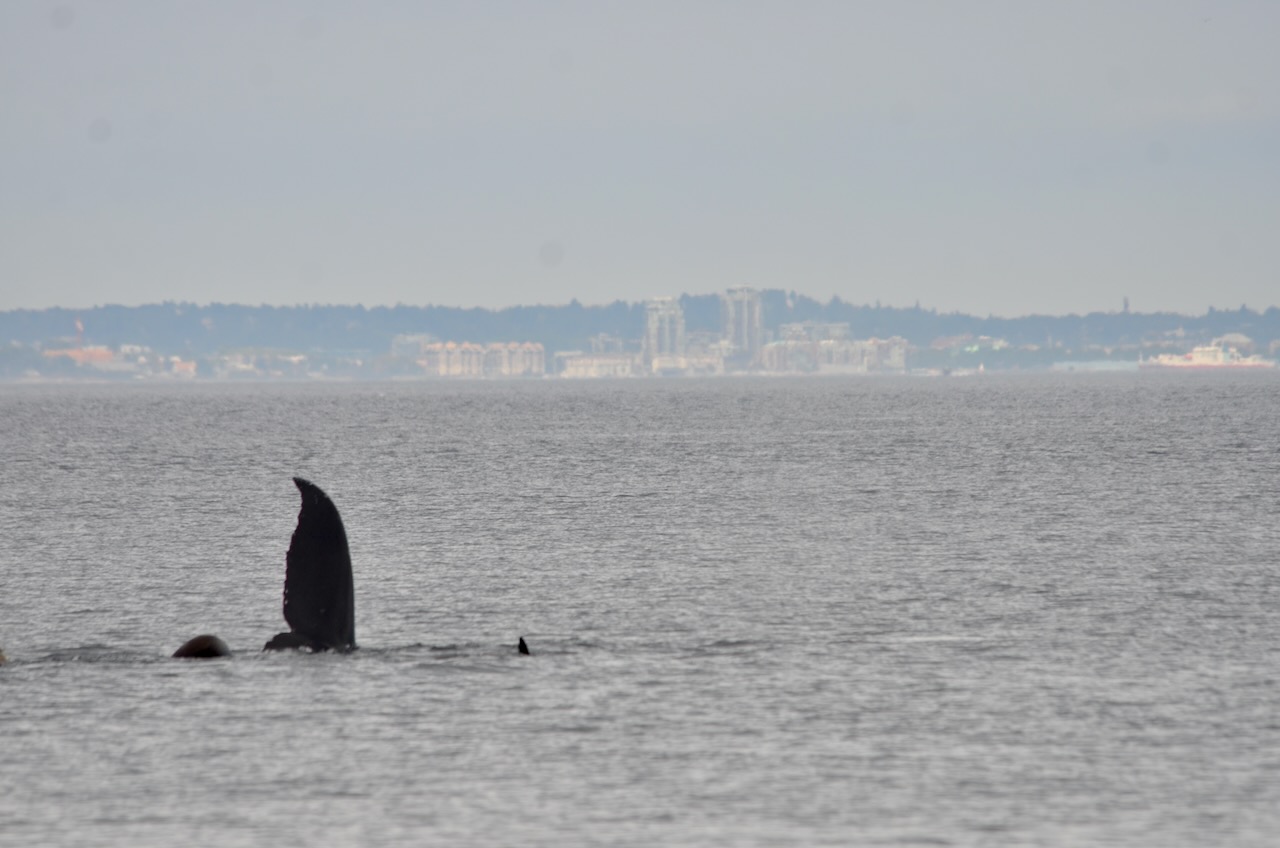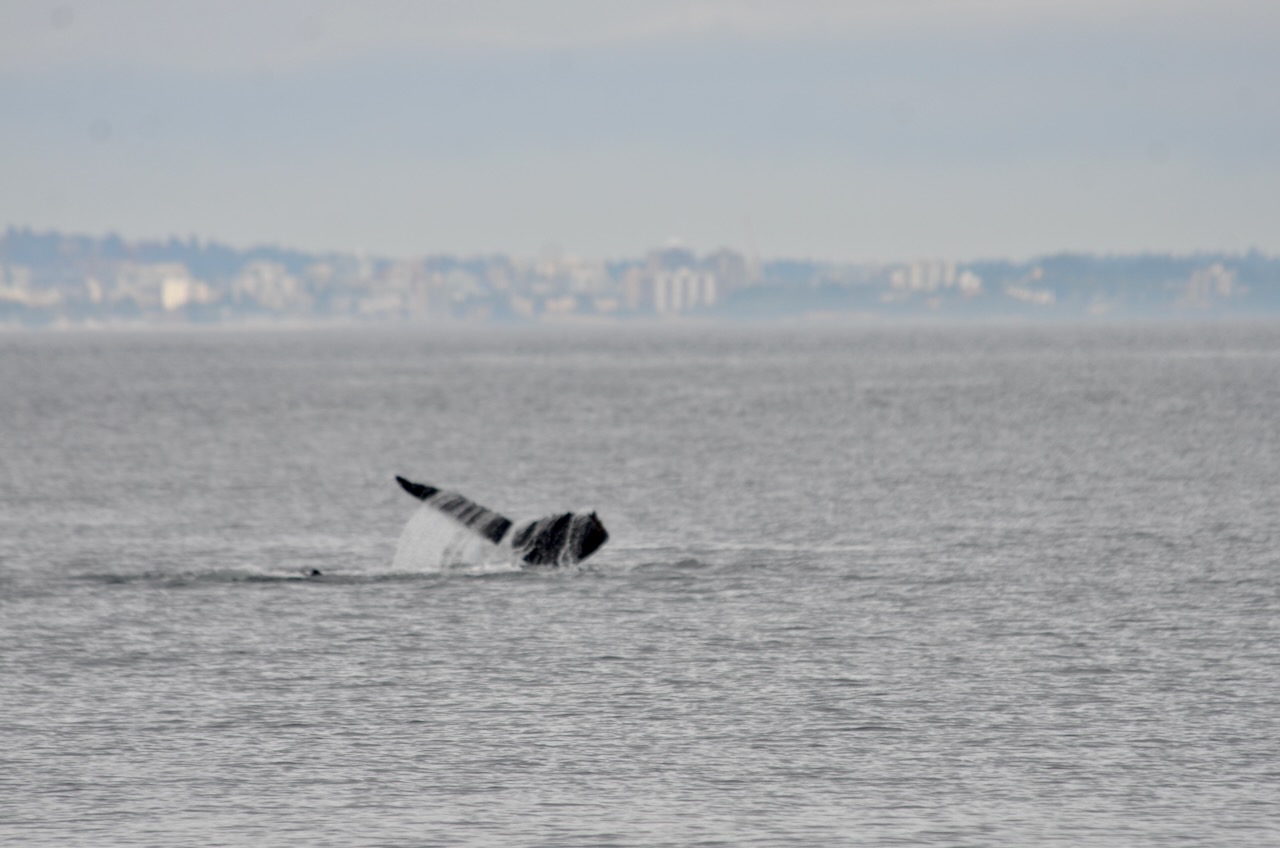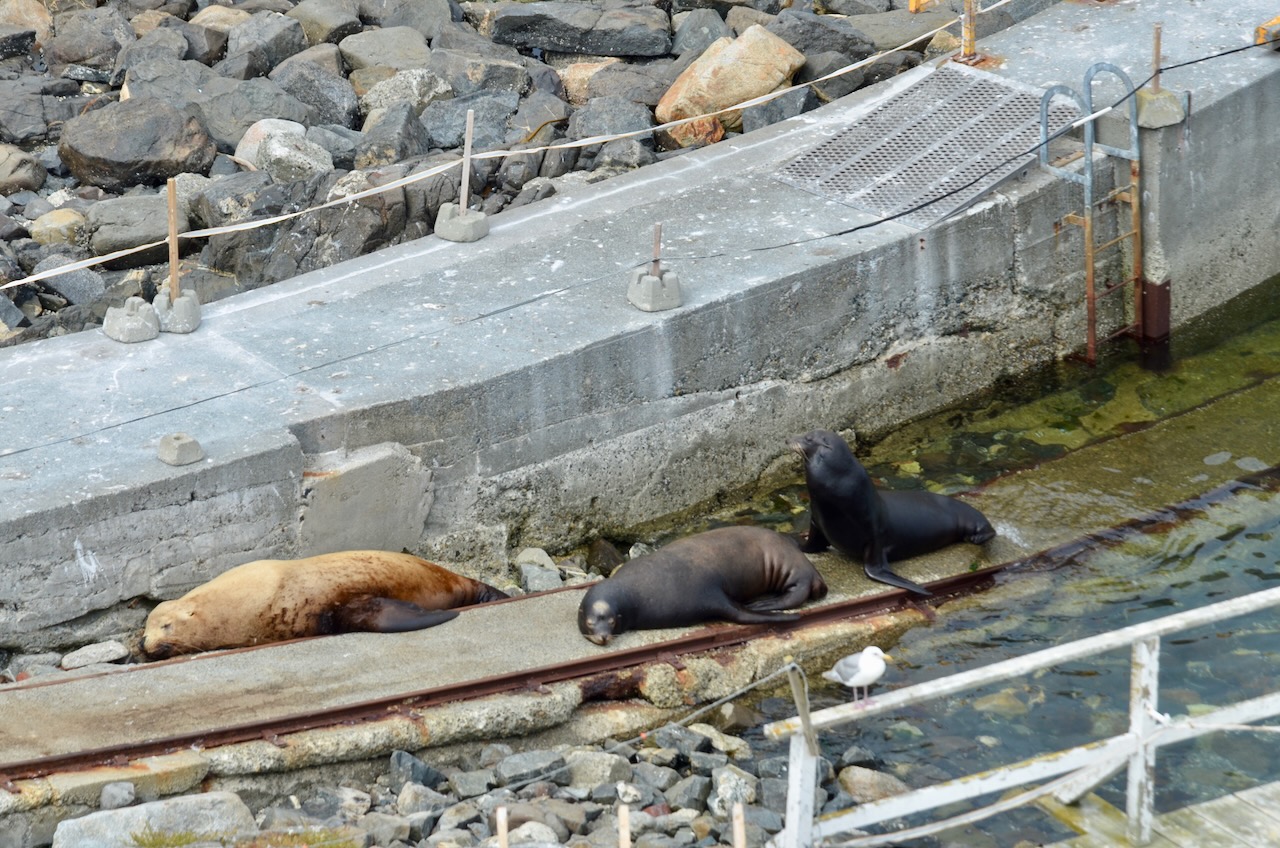August 24
Much quieter day workwise today.
The sea lions are taking over! They have knocked the fencing down in several places and once again have cleared the fence posts from the jetty. I am conceding defeat! I know Greg and Richard are planning to redo the fence system this week, so the sea lions can claim victory–for now.
During yesterday’s census, I saw a Glaucous-winged Gull with a seriously broken wing. It looked like an old injury given the condition of the wing. I couldn’t relocate it after viewing it from the tower, but today it was near the solar panels. I managed to catch it and will take it to WildARC when I leave on Monday.
The bird of the day remains unidentified. I flushed a small sparrow twice today, but it went too far for me to get a positive identification. I suspect it is a Savannah Sparrow. I am annoyed I didn’t get a better look as there are very few songbirds here.
The entangled sea lion is still present. Fingers crossed for a rescue soon.
Facility work:
- Clean the solar panels
- Clean the west and north windows of the Science Building
- Took hydrometer readings of the batteries in the generator building.
Weather:
- Sky: clear and sunny all day
- Wind: variable 0 – 20 knots
- Sea: rippled
- Air temperature: low 13 °C, high 27 °C
- Seawater temperature at max flood: 10.9 °C
Photos from today:
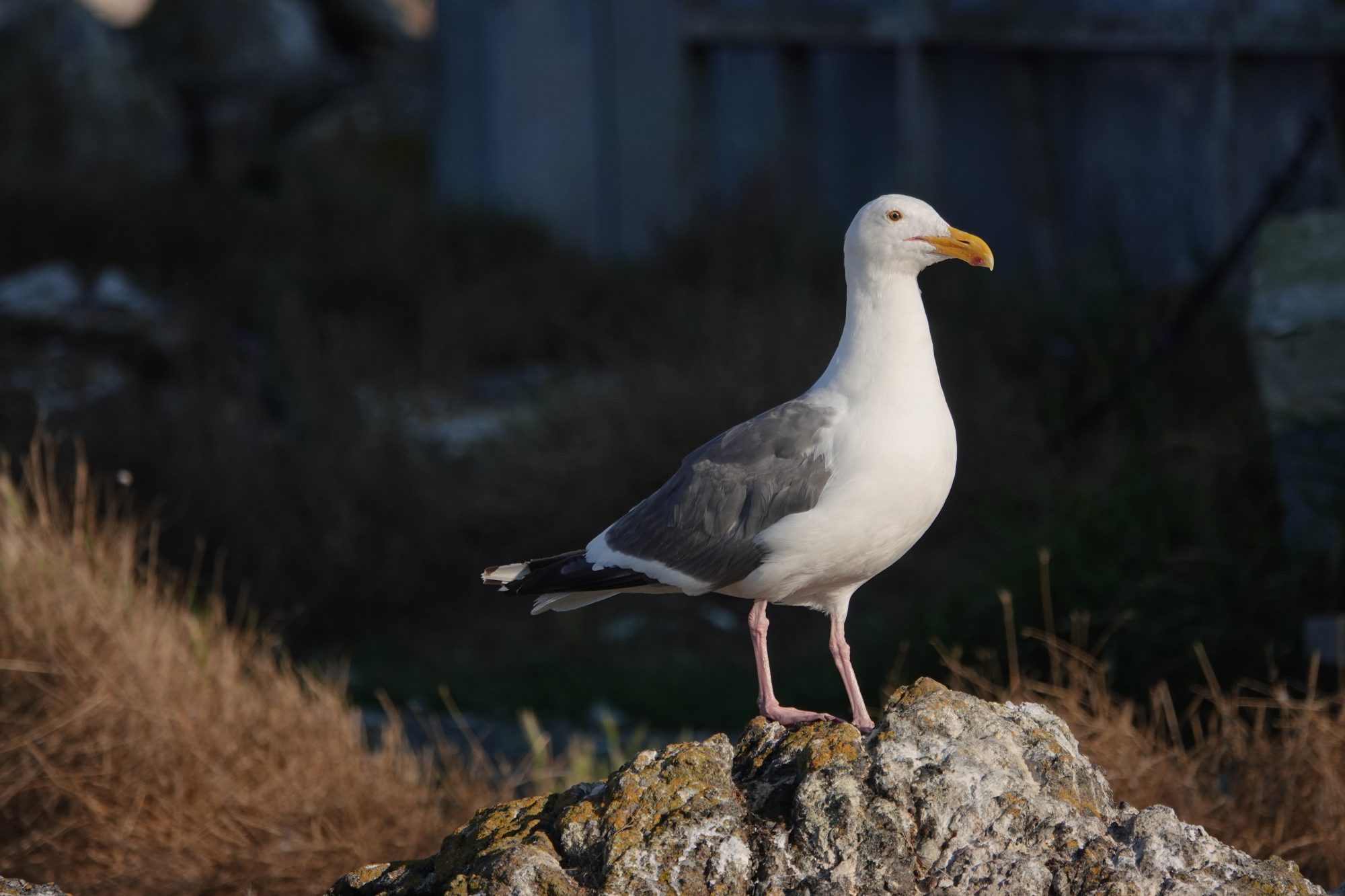
Western Gull, an uncommon species for Race Rocks, although there are a few who are breeding with Glaucous-winged Gulls on site.
August 23 Weekly Census
First things first! Time to check out the solar panels, while at the same time, keeping track of what animals and birds are being seen. Census is usually conducted on Friday, but since I didn’t arrive until mid-afternoon, I opted to do it today.
The solar panels were in better shape than I expected given the look of the Science Building windows. I remembered all of the valves that needed to be opened to provide water on the generator building roof, so a single trip up the ladder was all that was needed. Once those were taken care of, it was off to tackle the Science Building. There are some great new tools available for reaching the second story windows, but they are quite unwieldy, especially for someone who is just a little over 5 feet tall! As I feared, the gull artwork was baked on, so although there was improvement, the windows were not fully clean when I was done.
Next, a trip up the tower to count marine mammals and gulls. I found a key outside the door as I entered. The fob looked somewhat familiar, but I couldn’t quite place it. I thought one of the guests might have dropped it yesterday, so left it at the bottom of the stairs. A hundred steps up, I remembered why it looked familiar–it was the key to the hatch to the outside of the light. Down 100 steps and back up 100 steps. A double workout for today!
While at the top, I called my friends at Rocky Point Bird Observatory just the other side of Bentinck Island and arranged a neighbourly wave. There is a gap in Bentinck that provides a great view of Race Rocks from the other side.
Census complete, I headed back to ground level. Hmmm..Where are my glasses? You got it–back up at the light! Another trip to the top! Although I had done a count of gulls from the top, I decided to count the young birds again. They are difficult to see from the light. At ground level, I found about three times as many as I had counted from the birds’ eye view.
The sea lions had dumped most of the posts and their concrete blocks off the jetty again. I managed to get them back up before the tide rolled in and repaired the fence–again. I have to say, I felt that I’d put in a full-day’s labour before noon!
Weekly Census
Observed today because of arrival too late on Friday for a fair census
Mammals:
- Steller sea lion: 327 (including entangled female detected yesterday)
- California sea lion: 142
- Harbour seal: 64
Birds:
- Canada Goose: 7
- Black Oystercatcher: 5
- Pigeon Guillemot: 34
- Ruddy Turnstone: 1
- Black Turnstone: 15
- Brandt’s Cormorant 2
- Pelagic Cormorant 30
- Western Gull 2
- California Gull 270
- Glaucous-winged Gull 1042 (including about 300 young)
- Brown Pelican
Facility work:
- Clean the solar panels
- Cleaned windows on the north and west side of Science Building
- Returned posts and concrete blocks to the jetty and repaired the fence
- Topped up batteries
Weather:
- Sky: sunny and clear all day
- Wind: variable 0 – 18 knots
- Sea: rippled
- Air temperature: low 15 °C, high 26 °C
- Seawater temperature at max flood: 11.6 °C
Photos from today:
August 22
One more time! I’m back on Race Rocks for a short shift of just a few days. The last time I was relief ecoguardian was in 2023, and while much remains the same, there have been some changes, too. Nick left the house in great shape. What a nice welcome back!
I got my first trip on the new Pearson College boat. She’s a beauty! With lots of interior seating, I’m sure the students and visitors will appreciate the comfort of future journeys. We came across with several guests including Alex Fletcher, a former long-term ecoguardian on the Rocks.
After a quick look around, tasks began right away with the scheduled water temperature and salinity tests that are taken from the end of the jetty. No problem with the sea lions today as the boat was tied up and keeping them at bay.
One of the major chores for the ecoguardian is keeping the solar panels and building windows clean. Strong west winds this week resulted in the pelting of the Science Building. I know where I’ll be spending some time tomorrow!
As the Pedder Explorer departed, Greg yelled back to me about an entangled sea lion. A female Steller’s had the tell-tale signs of something wrapped around her neck. A close inspection of the photos showed a packing band which must have been on her for years given how far it has cut into her neck. The incident was reported to DFO. If she stays around, they may make an attempt to rescue her and remove the band.
Facility work:
- Reset the electric fencing on the jetty. Despite Nick’s efforts, the sea lions had knocked several posts off the jetty.
- Inspected the fence line around the perimeter. Again, the sea lions are not respecting the barrier.
Weather:
- Beautiful and clear on arrival at approximately 2 pm.
- Wind: Variable 2-13 knots
- Sea: rippled
- Air temperature: low 14 °C, high 25 °C
- Seawater temperature at max flood: 10.7 °C
August 20
This is my last log post, as I am heading home tomorrow. This evening, I am packing my things and tidying the house for the next ecoguardian.
I have enjoyed my time at Race Rocks over the past three weeks, as well as my many shifts since 2014 and visits since 2012. Over those years, I have been the resident ecoguardian here for varying shifts of two weeks to four months, during every season and all months except June. There have been so many special moments to witness such as watching storms, elephant seal pups, moulting elephant seal, sea otters, orcas, humpbacks, pelicans, as well as learning how to run the off grid systems. I would also like to think that I have done some work around the island to contribute to things not falling apart.
I plan to pursue other adventures next summer. When I visit Pearson at some point in the future, I hope to hop on a boat for a reminder of the familiar sights, sounds, and strong smells of Race Rocks. In the meantime, I look forward to following along with the log and checking out the webcams every once in a while.
Thank you to the staff team at Pearson College who keep this place running so well (despite the best efforts of the harsh elements) and have let me come back to spend more time on this unique island. I am truly honoured to be a part of the long list of ecoguardians, students, faculty, staff, volunteers, and lighthouse keepers who have stewarded this ecological reserve since its inception in March 1980.
Wildlife Notes:
- On my last full day here, I was treated to seeing two Bigg’s killer whales (AKA transient orcas) pass very close to me this afternoon. I was talking to a colleague on the phone when I saw the orcas passing east through the channel in front of the house. They then swam around the island where I saw them pass through the South Channel (about 50m from the back porch) between the South Islands and South Seal Rocks. Right after I snapped a few photos of them, a heavy fog rolled in obscuring the whole island.
- I heard back about the resighting history of the Steller sea lion branded 460Y that I saw on August 13. I spotted him again today hauled out on the South Seal Rocks.
Bryan, a biometrician from the Oregon Department of Fish and Wildlife, sent me this full history of this 12 year old Steller sea lion:
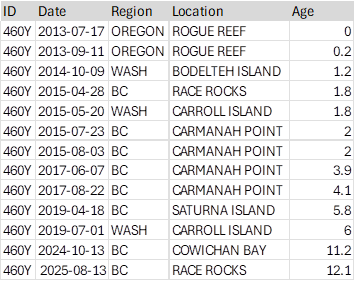
Resight history for Steller sea lion branded 460Y
- Steller sea lion branded 460Y (in the centre of the photo) on the South Seal Rocks today.
- This 12 year old Steller sea lion was branded 460Y as a pup in July 2013 in Rogue Reef, Oregon. Seen on August 13.
Facility work:
- Clean the solar panels
- Tidy the house and put away all the tools I moved around to different buildings
- Fix sections of the electrical fence between the house and tower. I had been avoiding that section due to the gull chicks and my dislike of getting pooped on by protective gull parents. Now, many of the chicks have flown away so the area is easier to access. I will fix the last part by the tower tomorrow morning and hopefully come away unscathed.
Vessels:
- Ecotourism: 19
- Private: 2
Weather:
- Sky: fog at sunrise, then clear until 3:30 when fog obscured the island for an hour, then back to clear
- Wind: W 12-28 knots
- Sea: rippled
- Air temperature: low 11 °C, high 15 °C
- Seawater temperature at max flood: 11.1 °C
Photos from today:
- Someone left behind their salmon eggs on the path.
- Clean solar panels with a clear sky
- The ladder to the top of the energy building that got the best of me last year. I have since regained my ladder climbing skills and have a sweet surgical scar on my ankle to remember Race Rocks :)
- What a treat to see two Bigg’s killer whales (AKA transient orcas) pass so close to me this afternoon. I am on the back porch of the house looking out towards the South Islands.
*All wildlife photos are taken at the furthest distance possible, and may be cropped to improve detail.
August 19
Wildlife Notes:
- As I was doing my breakfast dishes, I was delighted to see two humpbacks on the south side of the ecological reserve. I watched them from the back porch and witnessed two breaches, but I was too slow on the camera.
Facility work:
- The generator ran automatically for 7 hours due to not getting a full charge yesterday.
- Checked the battery fluid levels and topped up distilled water.
- Cleaned the windows.
- Topped up the diesel tanks in the energy building.
Visitors:
- Two visitors, Michael and Andrew, arrived in kayaks this morning to have a tour of the island. I have known them for many years through the outdoor industry. Andrew taught me how to sea kayak in 2006 when I worked at MEC Victoria. A couple years ago, Michael taught a sea kayak instructor course to me and my outdoor education colleagues. I enjoyed catching up and showing them around this amazing island.
Vessels:
- Ecotourism: 20
- Private: 8 (including two kayaks)
Weather:
- Sky: partly cloudy
- Wind: variable 2-20 knots
- Sea: rippled
- Air temperature: low 13 °C, high 18 °C
- Seawater temperature at max flood: 11.5 °C
Photos from today:
- Humpback whale this morning near the South Islands
- Trouble in paradise with an adult glaucous-winged gull and chick
- I have never seen a sea lion vomit. It appears a sea lion might have regurgitated a salmon. Maybe they wanted to try it out after seeing how the gulls feed their chicks.
- Sea kayaker visitors approaching
- Sea kayakers in Middle Channel
- Two sea kayakers watched by two bald eagles
6*All wildlife photos are taken at the furthest distance possible, and may be cropped to improve detail.
August 18
Wildlife Notes:
- This morning, I enjoyed watching from the top of the lighthouse as a Steller sea lion feasted on a salmon. See the photos below.
- I caught a glimpse of four brown pelicans flying through the ecological reserve and stopping in the kelp bed near Turbine Rock. I did see one close up this afternoon. They are my favourite bird I get to see here due to their size and rarity in these waters.
- With the permission of DFO (Department of Fisheries and Oceans), the dead Steller sea lion was towed away. The Race Rocks team did not want the carcass to rot in the jetty bay where it hauled out and died on Thursday. The plan was for the dead sea lion to be towed back to Pearson College, so it could be dissected by the Marine Science students. Due to the decomposition, the tow did not work and the carcass was cut loose in deeper water on the east side of the ecological reserve. Now that it has sunk, it is part of the food web.
Facility work:
- Due to rust, the jetty railing at the top of the built in ladder was removed. A new one will be manufactured and brought out soon. I reconfigured the electric fence at the end of the jetty to ward off the sea lions. After all, they do have so many rocks they can use.
- This afternoon, I took the Race Rocks station boat out for a leisurely tour around the ecological reserve. The boat ran well. I tested everything a couple weeks ago and was waiting for a good tide and current combination to take it out beyond the jetty. My attempt on Thursday was thwarted when the dead sea lion was blocking the boat ramp. Today, I enjoyed seeing the various smaller islands around the ecological reserve and vantages that I do not often see from Great Race Rocks.
Vessels:
- Ecotourism: 18
- Private: 8
Weather:
- Sky: partly cloudy
- Wind: west and southwest 5-15 knots
- Sea: rippled
- Air temperature: low 12 °C, high 19 °C
- Seawater temperature at max flood: 11.7°C
Photos from today:
- California sea lions are not known for their above reproach personal hygiene. These fellas have made quite a mess of the helipad in the past few days.
- Precarious perch for a harbour seal
- Pigeon guillemots
- Steller sea lion with a salmon feast (1)
- Steller sea lion with a salmon feast (2)
- Steller sea lion shaking the salmon to rip it apart
- Gulls managed to get some scraps of the salmon.
- Towing the dead Steller sea lion away from Race Rocks after getting permission from DFO.
Photos from this afternoon’s trip in the Race Rocks station boat:
- Getting ready to untie the station boat from the jetty to tootle around the ecological reserve.
- View of Great Race Rocks from the south
- Some of the sea lions that are usually out of sight for me behind the helicopter pad.
- View from behind the West Rocks looking towards Great Race Rocks
- Napping Steller sea lion on the West Rocks
- Brown pelican and a much smaller gull
- View of Great Race Rocks from the North Islands.
- Looking over Turbine Rock (covered in sea lions) to Great Race Rocks it is hard to distinguish the separation of the channel in between.
- A different view for me looking south towards Turbine Rock covered with sea lions.
- Retrieving the station boat with the winch up the boat ramp
*All wildlife photos are taken at the furthest distance possible, and may be cropped to improve detail.
August 17
Wildlife Notes:
- The dead Steller sea lion is still in the jetty bay and untouched by scavengers. The tide last night did flip it over and move it slightly away from the boat ramp.
Facility work:
- The generator ran automatically this morning from midnight to 08:00 because the state of charge dipped to 66%. This afternoon, the solar energy kept the battery topped up.
Vessels:
- Ecotourism: 14
- Private: 4
Weather:
- Sky: Partly cloudy
- Wind: (mostly) west 1-15 knots
- Sea: rippled
- Air temperature: low 13 °C, high 16 °C
- Seawater temperature at max flood: 11.5 °C
Photos from today:
- Two California sea lions on the boat ramp near the body of the dead Steller sea lion that has moved with the tides.
- Staring contest with a California sea lion
- Steller sea lion napping
- Glaucous-winged gull chicks
*All wildlife photos are taken at the furthest distance possible, and may be cropped to improve detail.
August 16 Weekly Census
Weekly Census
Observed today because of yesterday’s poor visibility from heavy fog.
Mammals:
- Steller sea lion: 229 (way up from 41 on August 9)
- California sea lion: 211 (way up from 35 on August 9)
- Harbour seal: 125
Birds:
- Bald eagle: 2
- Canada goose: 2
- Cormorant: 37
- Gull: 464
- Black oystercatcher: 6 (including 2 chicks)
- Pigeon guillemot: 92
- Surfbird: 25
- Ruddy Turnstone: 2
- Black turnstone: 99
Facility work:
- Checked the water levels in the batteries and topped up.
- Fixed parts of the electric fence to deter the sea lions from plopping themselves onto the paths and other human built areas of Race Rocks.
Vessels:
- Ecotourism: 10
- Private: 6
Weather:
- Sky: Partly cloudy
- Wind: west 3-25 knots
- Sea: rippled
- Air temperature: low 14 °C, high 17 °C
- Seawater temperature at max flood: 11.6°C
Photos from today:
- Trendsetting California sea lion on the helipad. This sea lion also has a rump brand reading 10 over 0. This means it was branded in Astoria, Oregon, at some point between 1997 to 2017.
- California sea lion followers to the helipad.
- California sea lions on the helipad. In the background are the Middle Rocks (also covered with sea lions) and Rocky Point, on Vancouver Island.
- Mostly Steller sea lions with a few Californias near the jetty.
- Swimming Steller sea lion
- Harbour seal near the South Seal Rocks.
- Canada geese tending to the grass
- Four oystercatchers and many Black turnstones and surfbirds blend in well on the beach in the East Bay.
- One California and three Steller sea lions on the South Seal Rocks. The sea lion branded 460Y (seen a few days ago) is on the right side.
- Sea lions on the southwestern edge
*All wildlife photos are taken at the furthest distance possible, and may be cropped to improve detail.
August 15
Wildlife Notes:
- The dead steller sea lion spotted yesterday was still on the boat ramp this morning. So far it appears to have been untouched by any scavengers. With the permission of DFO, there is a plan in the works to remove the animal from boat ramp in a few days if the high tide does not get to it first.
Facility work:
- The generator turned on automatically at 10:00 due to not getting enough solar energy for a full charge yesterday. It ran for almost seven hours before turning off with a charge of 94%. I could not figure out why the system decided it did not need a full charge like usual.
- I cleaned the solar panels with most of the work already done by the rain.
Vessels:
- Ecotourism: 3
- Private: 1
Weather:
- Sky: fog and rain
- Wind: variable 2-11 knots
- Sea: rippled
- Air temperature: low 12 °C, high 15 °C
- Seawater temperature at max flood: 11.6°C
Photos from today:
- A bald eagle on the North Rocks with a foggy view of William Head Institution, a minimum security federal jail and home to Race Rocks’ closest human neighbours.
- The dead Steller sea lion was still on the boat ramp this morning.
- Steller and California sea lions on a submerged rock in a rising tide.
- A foggy and rainy afternoon view looking north from the lantern room.
*All wildlife photos are taken at the furthest distance possible, and may be cropped to improve detail.
August 14
Wildlife Notes:
- A couple of humpback whales passed through the northern and eastern side of the ecological reserve this afternoon. At 14:30, I saw a spout just beyond the North Rocks and watched as the whales swam south. I heard over the radio from the ecotour boats that there appeared to be a mother and calf. I was surprised to see several sea lions swimming around the humpbacks. Most likely the sea lions were feeding on the fish that were being stirred up by the big whales.
- Early this afternoon, I noticed a Steller sea lion that had hauled out on the boat ramp beside the jetty. The sea lion did not move when I walked near it several times to fix the electric fence at the end of the jetty. It also wasn’t breathing, so I suspected it had died at some point overnight or this morning. I checked on it at this evening’s high tide at 19:30, by which point the sea lion’s mouth and nose were just under the water, but there didn’t appear to be enough tide to take it out. I reported it to the DFO (Department of Fisheries and Oceans) BC Marine Mammal Response Network, in case they want to check it out. Fortunately, I did not notice any signs of trauma on the animal from what I could see on the top. It had some battle scars on its back like most of the male sea lions and elephant seals I see. I am fairly sure it’s a male that is not mature, based on the thicker neck but not bulk of the fully mature males.
Facility work:
- Fix parts of the electric fence that were breached by party animal California sea lions. One made a foul mess at the end of the jetty that I washed away with many buckets of sea water. Any excuse to use a bucket on a rope to pull up seawater.
Vessels:
- Ecotourism: 13
- Private: 2
Weather:
- Sky: partly cloudy
- Wind: variable directions 0-30 knots
- Sea: riippled
- Air temperature: low 12 °C, high 15 °C
- Seawater temperature at max flood: 11/2°C
Photos from today:
- Pigeon guillemot perched on the second tower windowsill
- Looking down from the top of the tower at three sea lions swimming in the south channel
- Three poses of a black oystercatcher. I think they might have been celebrating a reprieve from the sea lions, who were off the rocks near the jetty on an afternoon swim.
- Pedder Explorer with Pearson alumni touring around Race Rocks
- Humpback pectoral fin with two sea lions swimming around it. If you click on the photo and zoom in you can see the barnacles growing on the end of the fin.
- Humpback fluke on the side. Downtown Victoria is in the background.
- Humpback fluke
- At some point this morning, the Steller sea lion (on the left) hauled out on the boat ramp and died. Two California sea lions behind it came and went from the ramp throughout the afternoon.
*All wildlife photos are taken at the furthest distance possible, and may be cropped to improve detail.
